Australian
and international
exploratory
performance and
media arts
Ben Brooker takes you deep inside four works in the 2015 OzAsia Festival, the first under the direction of Artistic Director Joseph Mitchell whose focus on cross-genre and cross-cultural performance and transnational engagement was immediately evident. Audiences live out Indonesian street life with Indonesia’s Teater Garasi, grapple with an overwhelming flow of digital data in Ryoji Ikeda’s Superposition, ponder the metaphysics of the collaboration between Australia’s Dancenorth and Japan’s Batik in Spectra and, raincoated, are awash with water, tofu, seaweed and everyday junk in a “spectacle of self-eviscerating excess” in Miss Revolutionary Idol Berserker from Japan.
RealTime issue #130 Dec-Jan 2015
–
Top image credit: The Streets, Teater Garasi, photo courtesy the artists and OzAsia 2015
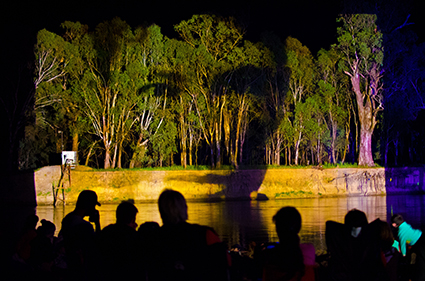
Haunting, creative team led by Julie Montgarrett, On Common Ground, CAD Factory
photo Jason Richardson
Haunting, creative team led by Julie Montgarrett, On Common Ground, CAD Factory
Last year The Cad Factory, along with National Museum of Australia’s historian George Main and friends, took a three-day healing walk from the Narrandera Common on the Murrimbidgee to Birrego, 40km away. This year they returned to the Common with many more friends to install sculptures, textiles and other works. Dozens of artists and many more locals came together to promote different perspectives on the location, and the healing theme continued with acknowledgment of the river’s long history as a contested site.
This historical perspective was brought into focus during Haunting on the Friday and Saturday nights, featuring a collection of vignettes from the region with images projected onto the river redgums across from Second Beach. Richly saturated photographs streamed through smoke onto pale trunks and eroded banks, as Main and others provided recorded narration over an atmospheric soundtrack.
Haunting was developed by The CAD Factory’s artistic director Vic McEwan during his time as artist-in-residence at the National Museum of Australia. His projections brought together water, earth and branches and made them active in the storytelling, “enabling understanding that would be possible nowhere else, under no other circumstance,” said Main in his introduction to the event, quoting literary historian Robert Macfarlane’s view of the poetry of Edward Thomas.
Main remarked in his narration how few of us look at the fields of wheat in the Riverina and imagine the forest of redgums that existed before the latter half of the 19th century. The Common is one of those places where a stand of Australian gums feels like a forest. Many old trunks are wider than cars and some have scars from Indigenous use. While the trees reflect an older landscape, the projection of static images from old photographs panning slowly across the river did too. I thought of the early days of Australian cinema, when the Limelight Department of the Salvation Army was one of the world’s first film studios.
The idea that art is spirituality in drag makes a lot of sense at a Cad Factory production, as the audience see local stories projected large. However, a reverential tone and too much spaciousness for reflection can feel ponderous. The snippets of history were like bubbles on the passing river and the variety of voices helped but sometimes Main spoke so…very…slowly.
It was surprising to see police arrive as the audience departed Haunting. A Facebook message from Michael Petchkovsky later described an incident with a local: “The lout [one of ‘the boys’] must have thought the bunyips had come for him when Hero Fukutu and I floated Gay Campbell’s gorgeous black swan right past him in the darkness and Craig said ‘boo’ to him from behind. He leaped up and ran screaming from the beach in front of all his friends, giving us all (his mates included) the giggles…”
The next day a local artist told me these ‘boys’ were a feature at local events. Perhaps they are performance artists in their own right? She also enthused that the youthful audience weren’t engaged in their usual activities on the Common, reinforcing the notion that this landscape remains a contentious space.
On the Saturday night there were introductions from Vic McEwan, George Main and local artist Michael Lyons, who performed imitations of wildlife such as “devil birds” (owls) on didgeridoo. It was the first of two musical performances that bookended the night. Local musician Fiona Caldravic closed Haunting with an operatic vocal in a bewitching outfit. It wasn’t until I looked at photos that I noticed the pattern on her cloak matched the huge backdrop—Vanishing Point, an installation across the river that was colourfully lit but still impressive the following day. Narrowing wires elegantly formed a vanishing point and billowing fabric served to reflect the black swans that had been driven from this landscape. The team of artists led by Julie Montgarrett drew on the writing of Mary Gilmour who attributed the decline of the swans to “swan hoppers” [whose work was to hop the swans off the nests in the breeding-season and smash their eggs, disrupting their breeding in order to reduce the birds’ damage to pasture. Eds].
Swans and billowing fabric were recurring features in On Common Ground. Black swans appeared at First and Second beaches in the works of Kerri Weymouth, on a totem pole, and Julie Briggs, in a formation of paper birds streaming down the riverbank. The title of the latter, Yes Faux Nature is a Real Trend, is explained in the program as referencing Glen Albrecht’s term ‘solastalgia’ to describe anxiety in response to negative environmental change.
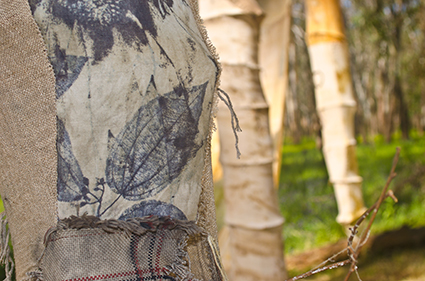
Tangible Spirit (detail), Emma Burden Piltz, On Common Ground, CAD Factory
photo Jason Richardson
Tangible Spirit (detail), Emma Burden Piltz, On Common Ground, CAD Factory
Fabric on site took many forms, including kites, quilts and an extensive variety of eco-dyed sheets that were the result of workshops with local artists and Nicole Barakat earlier this year. There were many shades but also beautiful details, such as printing the shapes of leaves and branches.
Emma Burden-Piltz is one local artist whose practice has blossomed through collaboration with The Cad Factory. When I interviewed the artist for Western River Arts she identified circular motifs as an element from the landscape incorporated into her collections of found and reworked objects. In Tangible Spirit, Burden-Piltz hung eco-dyed fabrics to give form to the movement of air, as well as shaping structures that resembled fishing traps. Up close I spotted hand-sewn circles.
Another local artist, Elizabeth Gay Campbell, creates often seemingly simple sculptural figures with a deeper message. Ophelia (2015) shows the character from Hamlet dying in a puddle surrounded by rubbish. In the program the work is described as acknowledging contaminated waterways and bush—the dying Ophelia the only remaining beauty, but she’ll too soon decay.
While a number of the works in On Common Ground expressed pessimism about environmental change, the event was beaut for its appreciation of Narrandera’s magical Common. Vic McEwan often explains CAD Factory’s role as creating memories within landscapes. This collection of activities and installations revealed On Common Ground to be much more than Bondi’s Sculpture by the Sea replicated on the Murrumbidgee.
The Cad Factory, On Common Ground, artistic director Vic McEwan, creative producer Sarah McEwan, project co-ordinator Julie Briggs; Narrandera, 16-18 Oct
RealTime issue #130 Dec-Jan 2015 pg. 32
© Jason Richardson; for permission to reproduce apply to realtime@realtimearts.net
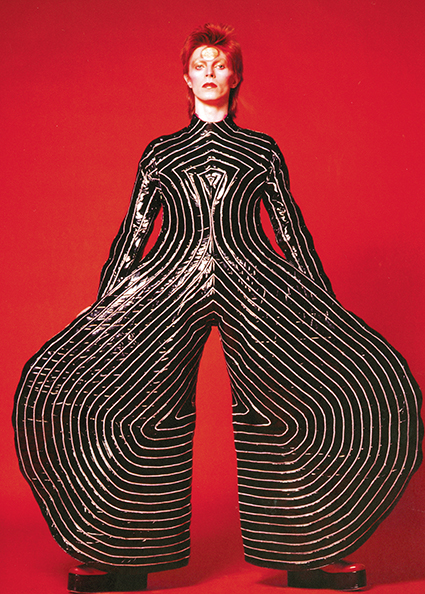
Striped bodysuit for ‘Aladdin Sane’ tour, 1973. Design by Kansai Yamamoto.
photo by Masayoshi Sukita
Striped bodysuit for ‘Aladdin Sane’ tour, 1973. Design by Kansai Yamamoto.
Babies, drunks and grandpas all know that David Bowie flirted with the image of sex, toyed with the image of avant-gardism and flaunted the image of mask-making. And sloths, slugs and doorknobs know that the promotion of imagery within music has remained a contentious issue ever since 18th century aesthetes worked hard to ingrain the Neo-Classical ideal that each art form should be pure unto itself and seek to attain its own ontological plateau of perfection. The 2013 Victoria & Albert Museum touring exhibition assembled from David Bowie’s Archive—pretentiously titled David Bowie Is—presents its findings as if Bowie invented the cultural brazing of sound and vision.
The exhibition charts how Bowie intuitively cross-hatched theatrical bricolage with persona politics and continued to ‘revolutionise’ mediarised music production across four decades. Maybe he did. But Bowie—the slut of the sonic, the tart of the textual—ripped into popular music by ripping off the late 60s vintage mania of second-hand clothing emporium styles which bloomed from Haight-Ashbury to Carnaby Street. Well before the cut-ups of Gautier/Goude, Westwood/McLaren and Bowie/Burretti, you had Jimi Hendrix looking like an Afrocentric culture-clash torn from a Napoleonic oil painting; Janis Joplin looking like a Texan bar maiden mashed up with a desert-distressed Art Nouveau poster for Absinthe. Bowie levered himself from the gauche posturing of 60s transhistorical image-mining wherein heroic rock icons were self-constructed by looking as much into their mirrors as at their audience.
You wouldn’t know this from surveying the mothballing multi-media catwalk of David Bowie Is. The through-line has been so thoroughly self-determined that most visitors feel happy to be corralled by the fawning narrative and its eponymous creator’s prescience. But let’s scrutinise this thin white historical thread between Bowie’s imagineered past and our mediarised present: I for one think Bowie should be prosecuted if his flagrant manipulation of ‘image’ begat the likes of Björk, Beck, Lady Gaga, Bonnie Prince Billy, Amy Winehouse, Marilyn Manson, Lana Del Rey and Nick Cave. Counter to their salacious embrace of artifice, the arch meaningfulness of those artists synchs more to Bowie’s dilettantish works than to his sporadic inspired works. Yes, it’s great to still be stung by the spine-tingling inappropriateness and halted eroticism of the alien visages of Ziggy Stardust, Aladdin Sane, Thomas Jerome Newton et al, but there’d been a far greater proportion of pale zeitgeist surfing in Bowie’s career.
As a teen fan of a near ridiculously high order, I have long noted Bowie’s contorted flips between crazed insight and embarrassing output. Standing in the rain eight rows back from the front at the infamous MCG concert of 1979 in Melbourne, I distinctly remember thinking by the third song that everything about the event was unexciting and weirdly insignificant—from his lame fisherman’s pants to the rank arrangements circa Stage (1978) to a god awful PA system only a footballer would appreciate. More, I was struck by the yawning gulf between Bowie’s ‘sound and vision’ and the ugly reality of how it was broadcast, staged, reported, rendered and transmitted. This was reverse Warholian logic, wherein Bowie’s audiovision—the image of music he fabricated and the melange of sonic styles he orchestrated—fully lived up to the empty stylishness of his gestural actions. Warhol transformed the abject banal into hyper art; Bowie often reversed the flow.
David Bowie Is notably gained access to the David Bowie Archive, but it feels like the V&A marketing department has shaped the exhibition more than its curators. What we get is: (i) a belaboured audio narrative forging a didactic trail; (ii) an over-designed theatrical presentation of artefacts; and (iii) a cynical and superfluous bombardment of TV screens. Yes, I get it: Bowie is image. Yet while the exhibition presents an amazing array of original costumes (those by Burretti and Yamamoto are stunning), it tarts them up as ‘image’ rather than ‘object.’ Some are stashed six metres up behind faux-telescreen grating and flashing ‘concert’ lights. Meanwhile, the exhibition’s hefty catalogue contains sumptuous pristine photos of all the key costumes on display; the book makes them look more actual than the exhibition.
David Bowie Is critically ignores the chance to materialise the fabric of Bowie’s key transformative stage personae, and to give physical museographic presence to Bowie’s costumery which has become so dematerialised, photocopied and hyper-imaged as to become nullified and tokenistic. While the exhibition adopts the uniquely British rhetoric of The Independent Group who inaugurated pop-as-culture in post-war Britain back in 1956 with their ground-breaking exhibition of Pop Art, This Is Tomorrow, it falls into the 19th century pit of artist-as-myth. Treating Bowie this way now does no service to anyone but bourgeois journalists and media teachers.
Bowie thought he was channelling Warhol, Burroughs, Dali, Duchamp, Schiele and Wilde, but he came nowhere near them in terms of concept, execution and innovation. David Bowie Is believes he was all those figures combined—without admitting to the delusional drug-laced phantasms conjured by Bowie between 1971 and 1978, which historically and culturally frame his brethren. The exhibition might have taken a leaf from Mick Rock’s iconic photos in the revealing hardback tome Moonage Daydream (2002). His stupendous archive proves that the amazing polysexual trans-alien pseudomorphic looks of Bowie start with the Haddon Hall red spiky cut of 1971 and peak with that look’s gaudy atrophy by the time of the Diamond Dogs publicity shots of 1974.
More importantly, the Moonage Daydream images are trailed by a ruminating text by Bowie, who was recorded looking through Mick Rock’s archive. His casual reminiscences were transcribed and edited into a running commentary. It’s a weird text: an oral account of Bowie looking into the mirrors of his past. (Numerous times this text is footnoted in the exhibition catalogue.) Yet not once does Bowie provide any interesting critical context for his self images: quite the opposite, he seems gripped by Wildean self-loathing. David Bowie Is silences that flippant voice, and instead broadcasts a hagiographic construction of Bowie on par with his own messianic concoctions.
Back in 2002 when Moonage Daydream was released, Glam Rock was derided, not lauded. Bowie’s mind was elsewhere: in 1998, he had launched BowieNet. A subscription-based fan-exploiting start-up venture, it was far more embarrassing than Glam’s glitter, with Kai Power Tools and insipid information-commodity-speak peppering its copy. It came one year after the outrageous stunt wrought by ‘rock and roll investment broker’ David Pullman who in 1997 marketed Bowie celebrity bonds, by securitising an artist’s royalties to enable said artist to self-fund future projects across the forthcoming decade.
David Bowie Is markets itself as if everything is grounded in the Ziggy/Aladdin/Diamond era Mick Rock fortuitously documented, but attempts to stretch that innovative sound and vision too far. Ultimately, the exhibition is a museographic version of the now defunct Bowie Bonds. As such, it sits well in the new millennial climate of atomised rock and pop culture. From Target launching Keanan Duffty’s bland range of post-Glam Bowie-inspired clothes (2007) to the Aladdin Sane face gracing a Brixton 10 Pound note (2011; a legal community currency), David Bowie really is all that too.
–
David Bowie Is. ACMI, Melbourne, 16 July-1 Nov
RealTime issue #130 Dec-Jan 2015 pg. 28
© Philip Brophy; for permission to reproduce apply to realtime@realtimearts.net
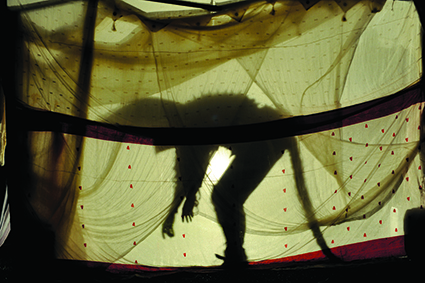
U.F.O. (Unidentified Female Object), Rakini Devi; costume Evangelos Laios and Jason Patten, Siteworks 2015, Bundanon
photo Heidrun Löhr
U.F.O. (Unidentified Female Object), Rakini Devi; costume Evangelos Laios and Jason Patten, Siteworks 2015, Bundanon
Arthur and Yvonne Boyd’s Bundanon property was gifted to the Australian public in 1993 as a centre for education and to support creative arts practice. Their bequest also insisted on public access to the site. Arthur Boyd obsessively painted this landscape and its anima mundi—or rather, his particular struggle with and against it. Many of his works examine the ‘guilt’ of an artist’s relationship to looking at and representing the natural world with an outside eye:
“Although I do the painting, everyone else who then looks at it is in the same position as myself. I hopefully have helped them to face their guilt also” (quoted in Grazia Gunn, Arthur Boyd, Seven Persistent Images, 1985).
This is especially evident in Boyd’s Nebuchadnezzar suite, which illustrates the fate and anguish of the King of sixth century BC Babylon who was banished for usurping a will and order higher than his own.
It is apt that Siteworks 2015 invited representatives of landcare, feral animal management, sociologists, philosophers, artists and architects to examine “The Feral Amongst Us”—an investigation of whether and how we humans place ourselves above or outside of the ‘wild.’
As recently as 2008, works proposed for Bundanon residencies that engaged with the site were not encouraged. Since 2011, Siteworks has perhaps overturned this tendency, but my ‘perhaps’ points to a caution around how we presume we relate to our environments. Is there actual dialogue between our bodily fluids and the rivers, our bones and the soil formed over our lifetimes and beyond? Is it too easy to transport cultural myths or practices from different landscapes (as did Boyd; as does Butoh) to help understand a landscape’s meaning and dreaming?
It is a boggy, wet drive over Clyde Mountain from Canberra in late September towards Bundanon. The sun peels the sky open at odd hours. It strikes me that most open-air events hope for clear skies. Indeed, a few of the Siteworks performances are cancelled. The four-hour talk-fest chaired by Robyn Archer is however untouched by the rain. The Glenn Murcutt-designed building has a flexible glass wall which opens to the river, but we sit facing the interior wall and a plinth for the panellists. This has the unfortunate effect of drawing focus onto the pull of human personalities over any sensed dialogue with the environment.
Alternately I feel punched, conversed with or lectured to. I suspect I sit in an audience nodding agreement with speakers who replicate their own views. Diego Bonetto chastises us for not understanding our edible weeds, Jennifer Atchison for not thinking with our environment, Adrian Franklin for farmers not listening to the evidence provided by science. Alarmingly, several panellists do not even listen to each other, absenting themselves from the room at particular times over the afternoon.
Architect Richard Goodwin gives a sweeping critique of his own profession, citing modernism and the anthropocentric ‘hero=architect’ as ‘dead,’ arguing instead for a practice which engages with social awareness (‘contingency’), minimal intervention, recycling of materials and a kind of ‘porosity’ or ‘irresolution’ which remains attractively vague against the harder-edged arguments of the afternoon.
Dean Bagnall, a feral animal management contractor from the local Shoalhaven area, modestly asserts the validity of culling feral animals to protect crops and farm animals. His talk sits in stark contrast with the later speaker Dr Fiona Probyn-Rapsey who delivers a hard-core lecture on the importance of letting creatures live in and for themselves. She cites Derrida for weight and authority. There is weight to her argument sans Derrida, but there is weight too in Bagnall’s argument, which is never picked up in the afternoon. Indigenous custodian Clarence Slockee plays the wise fool, nudging us towards a remembrance of Aboriginal relationship to land, but also claiming the infallibility of his peoples’ animal and landcare practices which makes my hackles rise.
Tim Low identifies our collective fear of death as blinding us to process and rational thinking through of human/nature/animal relationships. We eat, and are eaten, he asserts. He cites Val Plumwood, feminist ecologist and hero to many, who survived the ‘death–roll’ of a crocodile, and against which she held no grudges. Low, however does not mention that Plumwood not only felt the crocodile had a right to eat her, but that she herself sensed she transgressed by going upstream to where she was attacked. She had a sixth sense telling her she should not be there. Indeed, what is sorely missing from the forum is any discussion of the sensory intelligences—other than ‘sight’—that feed other ways of knowing and relating in the environments to which we belong.
Thankfully these aspects are grasped by the artworks installed for the day or performed from the onset of dusk. The site’s specific history, and Boyd’s contemporary dreaming of it, are most evident in Nigel Helyer’s exquisite Biopods—a rocket-ship, a boat—which physically reshape and recondition our listening. Each Pod is a vessel suggesting aspiration as well as the limits of form. Snippets of a seductively beautiful poem are triggered by human action: “The king’s heart is a stream of water in the hand of the Lord” (Proverbs 21:1).
Rosalind Crisp’s dance in the beam of a ute’s headlights is an exploration of disintegration, but her spoken text is impossible to hear. Open-air work always carries risk of interference, and there is meaning in the unexpected rubbings and gratings that occur beyond our control.
Elsewhere, Bonetto’s installation signposting edible weeds has already pointed us to things we value or devalue and ignore. On a “severe slope,” Branch Nebula puts a viewfinder on “things that bite” in a dance piece on the theme of wild things that watch, scatter, scarper, slide and are traumatised by human intervention. You couldn’t miss Amanda Parer’s inflatable, oversized rabbits which came to full beauty when lit at night.
But I almost miss a seminal image in Rakini Devi’s performance, because I am seated in the wrong position. But then, isn’t that the point? You see according to your [dis]position. Devi’s U.F.O. [Unidentified Female Object] begins in a puff of smoke—like the breath of a dragon, the backfire of a shot—and she appears like an enormous wayang puppet in full garb, picking her way like a giant cicada along a cat walk. A single beam of light casts the shadow of an enormous rabbit behind her. The joke’s on all of us: the ritualised beauty, the ‘exotic other’ rabbit becomes an overblown cartoon.
Speaking of entities in wrong places, Alan Schacher with NIDA Staging students creates “errant structures”—an outhouse, a heap and a bush shelter—that spit, shudder and try to crawl away, whilst Zender Bender salvage white goods and add sound and light to create a ‘bush doof’ that also comments on consumer throw-aways.
Branch Nebula repeat their epic Whelping Box from 2012, this time as a film recreated in the bush, which heightens the sense of men ‘whelped’ in endurance rituals that earn them a place in the tribe. The film is an epic comment on false heroism, compliance and suffering of the feral and human combined.
SITEWORKS 2015: The Feral Amongst Us, curator John Baylis, The Bundanon Trust, Riversdale, NSW, 25 Sept
RealTime issue #130 Dec-Jan 2015 pg. 31
© Zsuzsanna Soboslay; for permission to reproduce apply to realtime@realtimearts.net
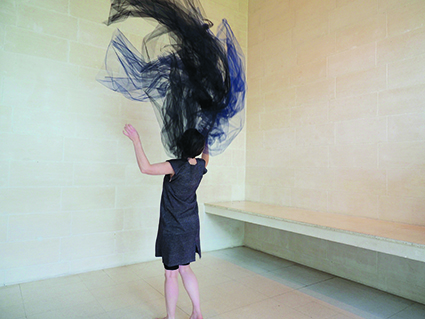
Lehte II
photo Jude Walton
Lehte II
Jude Walton’s Lehte II could well have been created in the mid-20th century. Its clean, clear, sleek distillation of time and space into a fine dance work draws on many of art modernism’s principles, most notably its sense of abstraction, which underlies the very construction of this work. Lehte’s manner of abstraction consists of a series of operations that transform the dimensions of a performance space into an artwork consisting of sound and movement.
Lehte II was performed at Heide Museum of Modern Art, in suburban Heidelberg, in the former house of art philanthropists John and Sunday Reed. Designed in 1964, by architect David McGlashan, Heide II is a sandstone building with high ceilings, exposed brick and plenty of light. The house was built with a view to its becoming an art museum. It doesn’t feel like a home.
We are invited to sample the space, to inspect its glass cabinets, which house a mixture of historical objects belonging to the Reeds, exhibits from Walton’s earlier work on dance and books and a floor plan of the house with some algorithmic calculations, which formed the basis of the work. We look out the window. A woman adorned in a striking top made of blood red felt traces a pathway.
Passing through the rooms, we descend a staircase into an extremely tall room which houses a grand piano and features a high wall of glass framing the surrounding native garden. Two women enter a mezzanine high above. They lean out, turn and walk, tipping over like modernist ducks. A woman (Fiona Bryant) enters downstairs where we are seated. She skirts the wall, drawing attention to its material surface, eking out its dimensions. Her movement conforms to the room’s coordinates, especially its long shelving underneath which she curls. More women join in: walking straight ahead, turning corners, walking, turning, walking, turning.
A 90-degree turn has two points of reference: the body (an internal space) and the (external) space of the room. If the turn is produced by the body, in the rotation of the femur in the hip joint, the orientation of the torso and the spiral of the head, its clarity is felt elsewhere, between the internal space of the body and the room. We see the dancers draw on their somatic perceptions in order to calibrate their movement.
Meantime, and throughout, Kym Dillon constructs a series of sonic atmospheres, clear and resonant. The series moves forward without circling back. It feels… measured.
While the dancing mirrors the sparse purity that informs the modernist architecture of the house, it draws on a thoroughly postmodern sensibility in order to do so: involvement of the dancer in task-based actions, a submerged sense of self, no expressive or individualistic gestures, clean lines and ordinary movement. The clearest physicalisation of these tasks comes from those who are able to distill their skills into very plain movement, without any kind of mannerism. It is the plainness that sings. The music also. Formed from an occult algorithm that transforms the spatial dimensions of the various rooms into selections of white and black keys on the piano, the music is surprisingly melodic, an indication of Kym Dillon’s virtuosic engagement with the productive constraints of the piece.
Overall, Lehte II is a contemplative work. Its spaciousness allows the viewer’s attention to wander, over the sandstone walls, into the garden, forming sensory trails in the midst of thought. It is a very considered work.
Lehte II, made by Jude Walton in collaboration with performers Phoebe Robinson, Fiona Bryant, Sally Grage-Moore, Michaela Pegum, music Kym Dillon; Heide Museum of Modern Art, Melbourne, 16-18 Oct
RealTime issue #130 Dec-Jan 2015 pg. 33
© Philipa Rothfield; for permission to reproduce apply to realtime@realtimearts.net
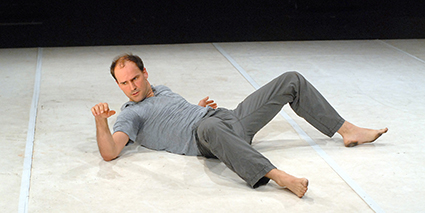
Martin Nachbar
photo Gehard Ludwig
Martin Nachbar
German choreographer Martin Nachbar sure kept himself busy during his three-city visit to Australia. In Brisbane he undertook research for his PhD, in Sydney he taught workshops and in Melbourne he presented one of his dance works.
Catching up with Nachbar in Sydney, I soon found out that this was not the first time he had been to Australia; his wife is Australian-born choreographer and performer Zoë Knights and he had previously accompanied her to visit family. This was, however, Nachbar’s first professional trip to Australia, on which he actively engaged with the local dance sector. In three capital cities no less.
Now based in Berlin, Nachbar studied at the School for New Dance Development (SNDO) in Amsterdam, in New York and at PARTS in Brussels. Since 2001, he has created more than 20 dance pieces, some of which have successfully toured internationally. During the last few years, his artistic focus has been on investigating walking practices, which is also the research topic of the trans-disciplinary PhD he is currently undertaking at Hamburg’s City University.
Brisbane
In fact, the main purpose of Nachbar’s residency in Brisbane—assisted by the Goethe-Institut—was to conduct research for his PhD. His thesis, Nachbar explains, asserts that performative group walking has the potential to create a stronger community, change urban life and increase contact between people. In addition to studying anthropological texts at the State Library of Queensland, Nachbar also participated in walking tours offered by the Aboriginal Cultural Centre in Brisbane’s city centre. Whereas these are mostly targeted at tourists, Nachbar himself has previously conducted walks of a more performative nature in the German cities of Berlin, Hamburg, Düsseldorf and Essen: “We invite a group of people, an audience, to walk with us, and we propose different modes of walking—backwards, forwards, really slow, really fast, homolateral [distinguishing between left and right body movement] and stomping. People can join us, or they can also step aside and watch.” The experiences of those participating in the walks are then charted through questionnaires.
Among the more unusual of Nachbar’s urban walking exercises is one that he calls the Quick Facade Walk: “The rule is that you stick to the facades of buildings as closely as you can. And whenever you come across an open door you have to go in, briefly explore the building or shop you’ve entered and then exit again.” And how do people, who are not part of the walks, react to this? Are the participants allowed to interact with them? “The walking exercises are usually conducted in silence to heighten the awareness for the sounds of the city. But yes, when people address you, you can answer.”
Sydney
Teaching a masterclass for students of Sydney Dance Company’s Pre-Professional Year (PPY) as well as conducting a workshop at the choreographic research centre Critical Path, Nachbar’s subject in Sydney was not walking but “Animal Dances.” The workshops drew on a project of the same title he undertook in Berlin in 2013 comprising both a solo and a group piece. As for what fuelled his interest in animal dances, Nachbar reveals: “[Gilles] Deleuze and [Félix] Guattari have an important chapter in their book A Thousand Plateaus called Becoming Animal, Becoming Woman. They talk about how ‘a becoming’ is not an imitation. Imitation might be part of it but it’s not its foremost feature.” After a short pause, he adds: “And it’s true. Because there is a lot of imagination involved, a lot of feeling and sensation. But since this book has been read by people like Xavier Le Roy and many other choreographers, it feels as if it has become forbidden to imitate when working within the context of concept-driven dance in Europe. And I thought, hey, I’m going to give this a go. So I started off my research with imitating praying mantises, horses and birds.” And how did he go with that? “It was a lot of fun,” Nachbar laughs. “Because, of course, you’re immediately confronted by the impossibility of imitating. You have to draw on your imagination and it’s really challenging, both physically and mentally.”
Nachbar concedes that Animal Dances received its fair share of criticism, precisely because of its premise of humans imitating animals. He puts this down to the currently predominant view that representation is something to be avoided in the arts. As much as he understands, he says, the limitations of representation, he is uneasy about the prescriptive approach some reviewers and fellow artists adopt on the topic. “To say about any art work—you can’t do this, you can’t do that—is completely undemocratic. It’s ideologically motivated and not useful artistically.” Nachbar seems determined to keep challenging commonly held views as to what is allowed in the arts and what isn’t.
So, what is the connection between his walking performances and the choreographic concerns underpinning Animal Dances? “I used to think that I always work on different themes for each project and I couldn’t identify what my choreographic signature or overarching interest was. But I’m slowly beginning to get a sense of what it might be,” Nachbar laughs. One of his major concerns, he says is definitely the idea of ‘becoming:’ “It’s a very important aspect of my work. Even in the walking performances. You could, for example, say that they are about the human becoming human. Bi-pedal locomotion is what distinguishes us from all other animals.”
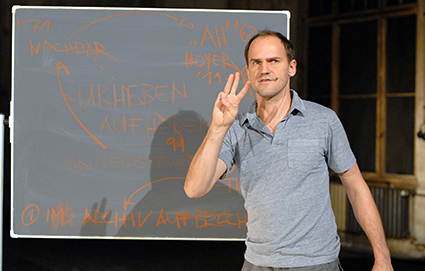
Martin Nachbar
photo Gehard Ludwig
Martin Nachbar
Melbourne
‘Becoming’ also plays a large part in the project Nachbar conducts in Melbourne, revolving around the reconstruction of the famous dance cycle Affectos Humanos by German expressionist dancer Dore Hoyer. The two-night presentation of his version of the work, was accompanied by a five-day workshop at Lucy Guerin Inc, part of the company’s Hot Bed program through which the work of international choreographers is introduced to the local dance community.
Nachbar’s research into reconstructing Hoyer’s seminal dance cycle began in 1999 and culminated in the creation of the piece Urheben Aufheben (2008) which he still tours. The original premiered in 1962 and a film of it was made in 1967. Working off the film was instrumental for Nachbar in orchestrating what he defines as a ‘meeting’ between Dore Hoyer and himself—across a timespan of over 40 years and two differently gendered bodies. He felt encouraged to do so by Hoyer herself. His research found that “she was interested in a particular unisex choreography in that piece.” He also was motivated by the impossibility of the task: “Knowing that I will neve be able to get rid of the differences, I had to embrace them.”
Nachbar admits that, from a modern day perspective, Hoyer’s choreography seems “strange and hermetic.” He says: “The question is how can you open it up to today and your own body, to think of reconstruction as a meeting rather than the attempt at perfect imitation.” These concerns were also to be explored in the then forthcoming, accompanying workshop: “I will ask the participants to choose one of the dances from Hoyer’s cycle [as glimpsed from her film] and devise a strategy for warming up for this particular dance.” This, Nachbar hopes, will allow participants to meet Hoyer’s work on their own terms, using their own skills. It’s the first time he’s run this workshop outside of Europe and he expresses great excitement about what the participants will come up with, especially given that Dore Hoyer plays no role in the Australian cultural consciousness. It will come down, he muses, to what strategies of ‘becoming’ each participant will devise for themselves.
Animal Dances Workshop, Critical Path, Sydney, 2-3 May; Hotbed Workshop #1, Lucy Guerin Inc, 4-9 May 2015; Urheben Aufheben, concept & dance Martin Nachbar, choreography Dore Hoyer, Martin Nachbar; presented at Lucy Guerin Inc, Melbourne, 8 & 9 May. Tour supported by Goethe-Institut.
RealTime issue #130 Dec-Jan 2015 pg. 34
© Martin del Amo; for permission to reproduce apply to realtime@realtimearts.net
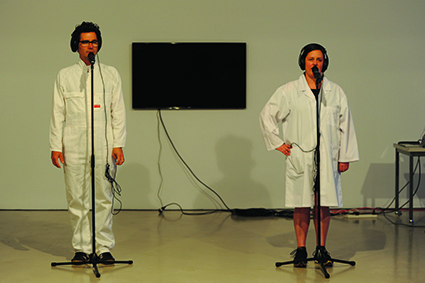
Glenn Thompson, Julie-Anne Long, 4’33’’ Into the Past
photo Heidrun Löhr
Glenn Thompson, Julie-Anne Long, 4’33’’ Into the Past
Despite a reluctance to do so, one can’t ignore saying something about John Cage’s performance 4’33’’ and the tradition within which this work sits. Why? Because even though Julie-Anne Long and Glenn Thompson do not directly perform this famously controversial score (musician on stage with instrument without playing said instrument over three movements in front of an audience) they do participate playfully and parodically with the provocations and propositions of Cage and others of this period historically labelled “happenings.”
Born on the stages of the Bauhausian influenced Black Mountain College with Cage, Merce Cunningham and Robert Rauschenberg, these experimental events reverberated east to New York, with the groovy gallery interactions of Alan Kaprow and the often lab-coated performances of Fluxus artists muttering and/or instructing their audiences through microphones
In the gallery spaces of Campbelltown Arts Centre the reverberation continues. Long in a white lab coat is busily collecting data and mapping the suburb and state electorates in which audience members live. We are not asked our earning bracket, but how much “actual cash” we have brought with us, “down to the last cent.” A record is made—the card swipers, pushers, tappers and wavers obvious among us. Meanwhile Thompson, also in lab coat, begins to drill holes in the gallery wall. A large plasma screen is mounted. The stage is divided. A drum kit played by Braxton Hegh from Campbelltown Performing Arts High School animates the first story of the past. High on the high hat with rock beat Lesson No. 5 underway, Thompson drops to his knees and recounts a ‘when I was young’ encounter; it’s nostalgically small, but character forming. On the margins of stage right we see the profile of Long directing someone offstage with tripod and camera, revealed on screen to be Georgia Briggs, also from CPAHS, who is “whipping it around” in a release based movement sequence: lesson, practice and warm-up.
The stage resets. There’s a bit of turntable rubbing from Long and an explosion of applause from a studio audience—not us from the Greater Sydney electorates, but artificial cheers jabbing at the space. Briggs sweeps through the space with her routine and a solar system appears on the plasma. All four dance a quirky number together, in white, in a white box with the galaxy glittering through a digital window.
Two microphone stands. Long and Thompson tell more stories of the past: were they formative in the emergence of arts practices? Hegh and Briggs sitting cross-legged flank Long and Thompson, left and right, in a perverse symmetry responding to these memoirs with simple mimicking gestures while plugged into their handheld devices. But where are their instructions coming from? The logic of transmission is unclear.
Long, helped by Briggs, returns to focus our attention on a faux-analysis of previously collected data. A map of the state electorates shows the density of attendance this evening, followed by an emerging pie chart on the monitor as a new galaxy representing how cashed up we are together: ca-ching! Use-value versus exchange-value suddenly takes on new meaning: could a coin really be a carrot rather than an abstract representation of it? But what is the point? Hmmm, my interpretive brain is working overtime here; am I taking Cage too seriously? Perhaps the point is no point: a pointless build to nowhere. This is the piece’s charm, along with a poke at earnestness. And for the askers of the why: why the hell not!
The Casio filtered voice of Long repeats the words “the contemporary dance” as we are plopped into an I♥NY loft scene, with Hegh strumming on acoustic guitar, Briggs leaning, coolly observant and Thompson wrapping his arms and hands around his head in a baroque twist to physically frame the retro-blurring of instrument, voice, image, movement and mood. A strong light beams in from stage left; the room thickens with smoky ice. Acceptance speeches in a canon run of overlapping “thank you’s” spoken into mics—doubling, trebling and quadrupling in the portal mist of a dying light.
The work feels less a happening than that things happened, offering us scenes, or better yet, events of not really knowing what or why, other than that we were ‘entertained’ by ‘art’ and fulfilled by the offering to “pay attention to what it is just as it is” (Cage 1957). Cage’s 4’33’’ is a paradoxical score about silence. Into the silence all we can hear is the noise. For Long and Thompson, the past—all we can find, and indeed applaud—is the present since the artists here are from where they were: Thompson, the little drummer from Queensland and Long “the prima batlet ballerina” (as she recorded in a childhood book of 1972 charting her then career) from suburban Auckland.
4’33’’ Into the Past was developed as part of the Campbelltown Arts Centre’s I can Hear Dancing Program (2012) initially curated by Emma Saunders and curatorially developed by Kiri Morcombe.
I can hear Dancing, 4’33’’ into the past; artists Julie-Anne Long, Glenn Thompson and collaborators, Campbelltown Arts Centre, Sydney, 25 & 26 Sept
RealTime issue #130 Dec-Jan 2015 pg. 35
© Jodie McNeilly; for permission to reproduce apply to realtime@realtimearts.net
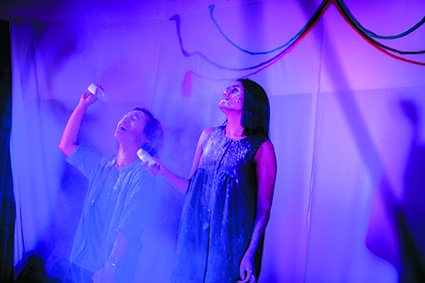
Asian Ghost-ery Store, Crack Festival
photo Mitch Lee
Asian Ghost-ery Store, Crack Festival
Crack Theatre Festival is one third of the festivals that make up the annual Newcastle gathering This Is Not Art. Works in the 2015 program took place in makeshift performance spaces throughout the coastal town, most prominently in an abandoned BI LO supermarket, affectionately re-named The Crack House. The slogan “The Low Price People” is still faintly visible through the festive decorations that dress the gutted store, now a festival hub. It’s fitting that all performances are free. Artists aren’t paid, but the Australia Council’s Setting the Stages initiative covers travel costs for selected artists from around the country, making for a nationally curated program that feels like a relief for emerging independent artists from the pyramid scheme that governs most fringe festivals. Here is a safe space to experiment with new work that is raw but ready enough in a convivial setting.
Performances presented in the 2015 program often reflected the fraught tensions at play in the theatre-making process itself and the cultural, conceptual, political, pragmatic and representational concerns that follow.
Hectoring Apocalyptica
With the audience on a seating bank of steps descending from the rear entrance into The Crack House, Nathan Harrison stands before an arrangement of transparent plastic cups filled with water. He tells us that Hectoring Apocalyptica is about water security, about looking into the future while responding in the present. He expresses his trepidation in approaching the material, in wanting to do the issue justice without being silly or flippant. The reconciliation of this struggle to make political theatre manifests in the form of speculative stage descriptions which—read from clipboards by the performers—suggest what the show might be like. They vary from the fantastical to the self-deprecating, embodying a sense of futility in trying to represent the issue and be self-reflexive to the point of speculating on audience responses to the work. These readings punctuate the actual show as a series of demonstrative acts in which facts and figures are personified by the audience wearing character nametags in order to perform the artists’ research, and in which the cups of water become props.
Audience members play farmers and countries in negotiations for scarce water in which repercussions are discussed ecisions are made. In another sequence facts arrive amid game show-like activity that exposes coffee as requiring more water to produce than most western delicacies, much to the shock of the audience. We are continually removed from the gravity of this material by pointedly silly stage descriptions, culminating in the suggestion that when we leave the show, we leave with hope, and with the final repeated refrain, “the oceans never rise.”
Asian Ghost-ery Store
Asian Ghost-ery Store begins with two performers sitting casually on stage eating Hello Panda biscuits. They discuss how they might make a post-racial show that avoids Asian-Australian clichés and stereotypes and what such a show might look and feel like. Through this simple and personable beginning the friendly rapport between the two establishes an entertaining framework for anecdote and parody. Despite their expressed desire to go beyond the typical cultural parodies that frustrate them, they never really do. Through an awareness of this though they manage a sharp parody of cultural representation itself.
The work is a funny reflection on young artists grappling with the representation of cultures they are proud of but by which they don’t necessarily define themselves. The strength of the performance is in the hubristic storytelling and personal narratives that the pair engage in, referring to each other by the nicknames Shan and Yaya. As an example of a focus that is both inwards and outwards, at one point Shan teases Yaya for only having white boyfriends, presenting her as both victim and perpetrator of orientalism. Their banter culminates with a white-faced period-drama pantomime, Shan performing an abstracted strip dance so that the predominantly white audience can “get more used to Asian cock.”
They’ve Already Won
Harriet Gillies and Pierce Wilcox in They’ve Already Won stand onstage in corporate attire either side of a projection of a desktop computer, on which one opens a text edit document of a ‘script’ for the show. It continually links to web pages and YouTube videos repurposed as found material and performance texts for the performers’ sardonic reflections on the end of the world and the death of us all. They craft logic with their schizophrenic pastiche of seemingly disparate sources. This is the world that young theatre artists live in where theatre struggles to compete with the internet, which itself possesses a theatrical potential that the stage does not. Gillies and Wilcox revel in this futility of representation, without directly acknowledging it in the conceit of their presentational mode of performance.
They do give a hammed-up performance of a scene from Ruben Guthrie (2015), exposing a terseness in the writing of Brendan Cowell. Later Wilcox goes to deliver a piece of poetry but Gillies protests the reading of work by a white male European poet. In a recurring ditzy persona Gilles struggles to name even three female poets and scrolls Buzzfeed articles while Wilcox talks on the history of the Congo (because “politics is boring”). Theirs is a cumulative expression of disenchantment for the theatre and simultaneously a display of appreciation for its history, which informs what they do.
YouTube music videos which punctuate proceedings are danced to by the pair. A scene of absurd rolling around the stage to the Johnny Cash cover of “Hurt” suggests catharsis is of no interest (and maybe has no place). This is testified to in the closing when we are handed Mars Bars melted in their wrappers and watch a YouTube video of a man having a terrible day at work.
Business Unfinished; Home
In Home and Business Unfinished solo male performers present verbatim content of material gathered from others. The content of the first is in the title: the idea of home, homes born into and homes made by subjects interviewed who ranged from migrants to the homeless to people recently released from gaol. Their musings are delivered in measured tones, relayed via headphones. In Business Unfinished the material is of supernatural encounters. The disembodied voices of the interviewees telling their stories are played over the sound system and impeccably mimed by the performers. Both shows use the unpacking of boxes as metaphor in a simple theatricalising of their subject matter. They also share a focus on how best to represent their subjects by using their voices, the different verbatim approaches capturing a sense of authenticity. It will be interesting to see how each of these works evolves.
Little wonder that young and independent artists focus on the fraught demands of making performance work given the gutting of the Australia Council to establish the National Program for Excellence in the Arts, now Catalyst. Whatever the cause for this introspective turn, it represents an awareness and self-reflexivity ultimately born of artists sharing the same cultural climate as their audience. By providing artists with the opportunity to test their visions, The Crack Theatre Festival is fostering the excellence of tomorrow.
Crack Theatre Festival, Hectoring Apocalyptica, artists Nathan Harrison, Jacob Pember, Rachel Roberts and Emma McManus; Asian Ghost-ery Store, artists Shannan Lim, Vidya Rajan; They’ve Already Won, artists Harriet Gillies and Pierce Wilcox; Business Unfinished artists Robert Maxwell, Maeve Mhairi MacGregor; Home, Tom Christophersen, Nick Atkins, Crack Theatre, Newcastle, Oct 1-4
RealTime issue #130 Dec-Jan 2015 pg. 36
© Malcolm Whittaker; for permission to reproduce apply to realtime@realtimearts.net
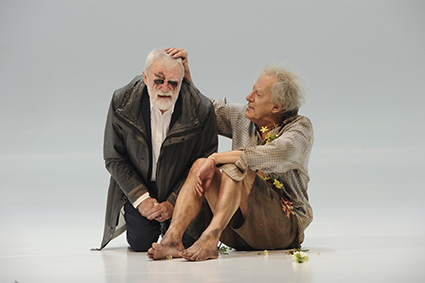
Geoffrey Rush, Max Cullen, King Lear, Sydney Theatre Company
photo Heidrun Löhr
Geoffrey Rush, Max Cullen, King Lear, Sydney Theatre Company
Insanity took centrestage in major productions in Sydney of Shakespeare’s King Lear and Fausto Romitelli’s An Index of Metals. In each the rupturing of a personal relationship yields terrible consequences. In Lear we watch the whole process unfold, in An Index of Metals we enter the mind of a woman living out the aftermath.
STC, King Lear
Geoffrey Rush’s Lear is elegant and stentorian—gravely and boldly voiced without ever being stock ‘Shakespearean’ in his delivery. Chest thrust out, he holds his head high. He’s robust, sweeping about the stage, but easily battered by emotional shocks that propel hand to heart and have him seeking out chairs either side of the stage, caving in, chest sunken, before angrily rallying. The anger is palpably raw but so is the personal pain his old age cannot immure him to. We already sense an emotional complexity that will unleash the madness he already fears and which will ultimately engender his short-lived salvation.
Rush brings to Lear a contemporary gravitas, underlined by the production’s initial setting, its opening scene akin to a party at an upper end reception centre or RSL club, men in dinner suits, women grandly frocked, some aptly kitsch entertainment from the Fool, tinsel and speeches at a microphone. This Lear has the appearance of an elder statesman and indeed looks mightily like Malcolm Fraser in country cap and long coat in scenes that follow. Rush perfectly embodies Lear’s bewildered, mad and sad trajectory right to its dark conclusion, the aged body increasingly weakening, memory fading save for the small jolts of recollection that return him to a tormenting real world. But the journey is critically interrupted and it’s not Rush’s fault.
The first part of Neil Armfield’s production, designed by Robert Cousins, is set in a vast empty black-walled space, filled with machination and misjudgement and only tinsel, microphone and costuming to minimally evoke location. In the second part there’s an edgeless, depthless white space—modulated by mist and subtle pastels—rapidly emptying of life but finally admitting of love and nuance. In between is the storm and Lear’s refuge on the heath. For a production excelling in minimal design that foregrounds action and emotion, the storm scene is astonishingly overwrought—the black walls slide up to partly reveal a white expanse against which we see an enormous volume of heavy rain flooding the stage, while live percussion thunders at the expense of words as Lear runs towards a huge industrial-scale fan to the side of the stage that fiercely pumps wind and mist. What’s lost is our direct contact with Lear, here he’s in profile braving the blast, and, above all, the fine balance between the inner and outer storms, the superfluity of the latter here scuttling the connection. Recovery is quick, but we have been rattled for the wrong reasons. Likewise, some devices that start out well are sustained too long after their framing of the initial scenes—the use of the microphone and the ba-boom drum beats that climax the Fool’s witticisms—instead of letting them fade as mood and circumstances change.
Also out of kilter was Meyne Wyatt’s powerful performance as Edmund, big and loud (and louder with microphone) as if dropping in from a performance of a play by one of Shakespeare’s revenge tragedy peers of the 1590s.
Otherwise performances all round were uniformly strong and subtly modulated, with licence given, of course, to Mark Leonard Winter’s excellent, naked Poor Tom to run mad and slide gleefully across the wet heath. This was a memorable if flawed Lear but the acting, the seamless transitions from scene to scene, the design and lighting (Nick Schlieper), Alice Babidge’s costumes and the live music (John Rodgers with Simon Barker and Phil Slater in a fine take on drums and trumpets), added up to an almost satisfying whole. Perhaps the storm scene will be recalibrated. I hope so. Best of all is Geoffrey Rush’s performance although there are many who have cast him forever as inspired clown and will let him be nothing other, missing what a superbly embodied Lear he has given us.
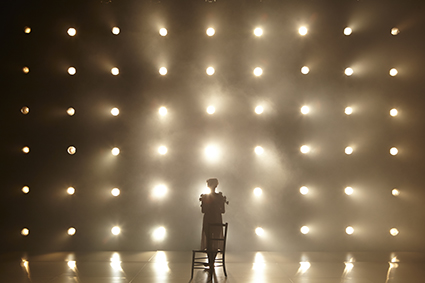
An Index of Metals, Sydney Chamber Opera
photo Zan Wimberley
An Index of Metals, Sydney Chamber Opera
Sydney Chamber Opera, Ensemble Offspring, An Index of Metals
Director Kip Williams has responded to the late Fausto Romitelli’s An Index of Metals—for instrumental ensemble, electronics and two electric guitars—by creating a scenario for a psychodrama suggested by the work’s fragmentary poetic text from Kenka Lekovich. It’s monumentally framed by three walls and a ceiling of some 200 lights that suggest a surreal padded cell or place of interrogation writ large. They function in enormous waves, reflecting the surging emotional states of a lone woman (soprano Jane Sheldon) attempting to come to grips with the breakdown of her relationship with ‘Brad’ (of Roy Lichenstein’s pop-art masterpiece Drowning Girl: “I don’t care, I’d rather drown than call Brad for help”). The sense of drowning is amplified with descending glides, both gentle and vertiginous, from the orchestra and, grippingly, from Sheldon.
The protagonist’s mental condition is portrayed as neurotic with her compulsively repeated tipping over of a vase of red roses and her chair on an otherwise empty stage until, neurosis turning to psychosis, she conjures a man, clearly the object of her thwarted desire, whom he she undresses and soon multiplies into five more naked men. Counterpointing, and not competing with, Romitelli’s dense, propulsive score and Lekovich’s evocative phrasings (that include the metals of the title: iron, copper, nickel, lithium and rust with their various resonances), Williams wisely keeps stage action spare save for several critical passages. Initially closed in on herself, the woman is hoisted high multiple times on her chair by the men, out of darkness into light, until she gradually opens out, extending a leg, drawing up her dress and leaning exultantly back. It’s a temporary erotic reprieve and prelude to her own nakedness—a profound vulnerability—and suicide (the music painfully and metallically grand). But in a hyperbolic ending the woman is rejoined by the men, equally blood drenched, as if she has exorcised herself of Brad in the very act of self-destruction. The accompanying, deeply melancholic adagio is followed by a final dark enigmatic guitar passage, confirming not only the powerful and often subtle role of the two instruments (Joe Manton, Cat Hope) throughout, but also recalling an intriguing phrase sung earlier by Sheldon in one of her four arias, “murdered by guitar.”
Jane Sheldon’s convincing evocation of advanced nervous breakdown and her sublime singing, Elisabeth Gadsby’s design and Ross Graham’s lighting and the combined instrumental forces of Sydney Chamber Opera and Ensemble Offspring, conducted as ever by Jack Symonds with passion and precision, came together to make an opera of An Index of Metals. Having the orchestra placed immediately before the audience meant that we could luxuriously immerse ourselves in the playing itself as Kip Williams’ direction carefully balanced sound and image. Meanwhile we were surrounded by glorious real time electronics operated by Bob Scott. Although the pulsing of waves of light in which the woman is drowning and the final bloodiness seemed overwrought and at times archly stagey and the movement and demeanour of the men too abstracted, Kip William’s fidelity to Lekovich’s text and his dramatic expansion of it proved to be an admirable venture for all parties involved and another step forward for adventurous opera in a Sydney greedy for it.
Sydney Theatre Company, King Lear, writer William Shakespeare, Sydney Theatre, 28 Nov, 2015-9 Jan, 2016; Carriageworks, Sydney Chamber Opera & Ensemble Offspring: An Index of Metals, Carriageworks, Sydney, 16-19 Nov
RealTime issue #130 Dec-Jan 2015 pg. 37
© Keith Gallasch; for permission to reproduce apply to realtime@realtimearts.net
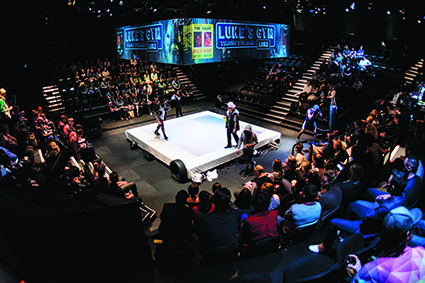
Prize Fighter, La Boite Theatre, Brisbane Festival
photo Dylan Evans
Prize Fighter, La Boite Theatre, Brisbane Festival
This year’s Brisbane Festival was carefully shaped by brave programming and warm place-making, where even the large public festival spaces like Arcadia and the Theatre Republic felt like private house parties rather than public way stations. The dance between popular and worthy has always been a difficult one for the festival and incoming Artistic Director David Berthold seemed acutely aware of this, stating on his blog, Carving in Snow, soon after his appointment that “the gap between what artists want to make and what audiences want to see is now wider than I’ve ever known it.”
Yet the unflinchingly radical message about the violence perpetrated on the bodies of black men in America produced the most heavily promoted image of the festival advertising—two young Afro-American men, in hoods, circling each other, their bodies contorted into impossible extensions. As well, the cabaret Coup Fatal—where Congolese artists worked with Belgian choreographer Alain Platel to explore intractably difficult political and cultural issues in the Congo—threw off any pallor of worthiness with exuberant virtuosity. This was one of the magic tricks that Berthold managed in his tenure at LaBoite: selecting work that might on paper appear too edgy for conservative Brisbane audiences but that attracted them nonetheless through sheer energy and visual impact.
Ditto with the local work, including the saucy, politically punchy all brown ladies cabaret Hot Brown Honey at the Judith Wright Centre, and the two most commented on local works in this year’s festival: La Boite’s Prize Fighter—the debut of Congolese-Australian Future D Fidel—and the Queensland Theatre Company’s The Seagull adapted from Chekhov and written and directed by Brisbane wunderkind Daniel Evans.
Prize Fighter
Prize Fighter was the most anticipated show of the year from the moment of its announcement by former Artistic Director of LaBoite, Chris Kohn, who is most responsible for its incubation. The conceit of the show as an actual boxing match in real time was a powerful one and demonstrates Fidel’s strong instincts as a playwright. The match was flawlessly brought to life in production by deft direction from Todd MacDonald, elegant design by Bill Haycock and technical wizardry by lighting designer David Walters.
What was also extraordinary about the work was its showcasing of the breadth of African-Australian talent in this country with local performers Pacharo and Gideon Mzembe matched by recent NIDA graduate Thuso Lekwape and veteran American-Australian performer Kenneth Ransom. The opening night felt genuinely significant, evoking descriptions of the first night of Wesley Enoch and Deborah Mailman’s Seven Stages of Grieving at Metro Arts in the 1990s. For me, Prize Fighter felt not quite finished. Despite the obvious talent of the playwright, some of the writing seemed sketchy and the deeper ideas of redemption and trauma had not quite integrated the pivotal relationship in the work, that between the feisty trainer played by the redoubtable Margi Brown Ash and the doggedly heroic boxer trying to knit together a psyche torn apart by experiences of true horror. When the show tours, which it must, I have no doubt there will be time to deepen and integrate what is an important new work in the canon.
The Seagull
In direct contrast to the raw and stripped back Prize Fighter was Daniel Evans’ adaptation of Anton Chekhov’s The Seagull, which played out in a hoarder’s paradise—a set full of domestic detritus where stage manager Daniel Sinclair pottered around, moving pieces of the set and organising the quotes from Chekhov projected regularly onto the side wall of the Bille Brown Studio. I am not a Chekhov devotee, so although familiar with the story I came to Evans’ adaptation with relatively naïve eyes.
This is one of the most talented casts assembled in local memory but it was Brian Lucas’ performance as the mischievous and delusional dementia patient Soren that was at the heart of the adaptation. He spent the second half of the piece clutching the seagull shot by Trigorin. It was embalmed and spoke to him alone in the voice of Chekhov.
Lucas’ embodied and melancholic performance signalled what might have been for this work with more time and without the punishing dual role of writer/director. Evans’ previous adaptation for QTC, Oedipus Doesn’t Live Here Anymore, was brave and wild, but exactingly disciplined in form and structure and displayed his longstanding preoccupation with Australian suburbia, a great leitmotif of Australian performance. The Seagull, for all of its self conscious disdain of Chekhovian mannerisms as boring and its meta-theatrical referencing of the tired controversies around adaptation, still faithfully adhered to all of the major story arcs and themes of the original.
This left those in the audience attached to the original in a real conundrum: if as a writer you literally excise Chekhov and try to fit your thoughts about art and life back into a Chekhovian shaped hole, you offer yourself up for direct comparison. While there was all of Evans’ vivisectional, generationally savvy, observational humour and flashes of sly brilliance, so much of it felt, well, petty. Yet in those sequences with Soren you felt the tingle of what could have been from one of Brisbane’s most daring and talented writers.
Theatre Republic
Across the river at Theatre Republic, the venue beautifully designed by Sarah Winter and program curated by La Boite Creative Producer Glyn Davies, it was business as usual with a mix of independent work from around the country. This included Attica Erratica’s disturbing reboot of the biblical story of Lot, The City They Burned, and the effortlessly charming political satire Richard II by Mark Wilson for MKA, another adaptation, but one that takes a range of Shakespeare’s history plays to pillory the current bloody federal political landscape. The loose brilliance of Wilson’s renditions of Shakespeare’s text scattered through the work was bettered only by his ability to rant: my favourite his tribute to Paul Keating. The fake golden velveteen of the set was gorgeous and the crisp by-play with Gillard cipher Olivia Monticciolo delicious, though the currency of the show did suffer from a climax tied to the rise of the then freshly deposed Tony Abbott.
Experimenta Recharge
Just adjacent to the Theatre Republic was one of the gems of the festival: Experimenta Recharge: 6th International Biennial of Media Art, with a dizzying range of visually beautiful and politically witty media art. While many of the pieces invited a traditional gaze—framed on walls or mounted in installation—their lurid colours disguised a slightly askew technological formalism that gave them an eerie depth. My undisputed favourite was a technicolour panaroma by Japanese collective TeamLab, 100 years sea, that rolls out animated verdant green islands across a pulsating aquamarine sea and changes subtly as it literally maps sea levels rising, minute by minute.
The last word though must go to the evangelically mesmerising American theatre director Peter Sellars. He suggested that there is a crisis of imagination in contemporary culture that only artists can solve by providing new models for work and collaboration. He ended his talk with a final provocation, urging the beleagured Australian arts sector to find solidarity and comfort with other communities straining under the weight of poverty and shrinking funding. In fact he claimed that it may well be in the work that we are now forced to do outside of our own art that we will find the fuel to create new approaches that could eventually change the world.
Brisbane Festival: La Boite, Prize Fighter, Roundhouse, 5-26 Sept; QTC, The Seagull, Bille Brown Studio, 29 Aug-26 Sept; Theatre Republic: MKA Theatre of New Writing, Richard II, The Loft, QUT, 22-26 Sept; Experimenta Recharge, The Block, Creative Industries Precinct, QUT, 8-26 Sept; Brisbane Festival, 5-26 Sept
RealTime issue #130 Dec-Jan 2015 pg. 38
© Kathryn Kelly; for permission to reproduce apply to realtime@realtimearts.net
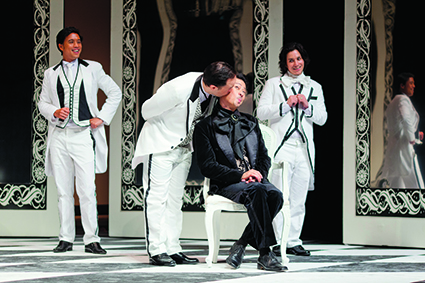
The Importance of Being Earnest, Wild Rice
photo courtesy Brisbane Festival
The Importance of Being Earnest, Wild Rice
I’m going to be very honest here and admit that there have been years recently where the Brisbane Festival has come and gone and I haven’t really registered that it’s on. Riverfire (the festival’s culminating firework spectacular) happens, sneaking up and strafing me as an annual wake-up call to say that it’s all just finished. The Theatre Republic, hosted by La Boite (curated by Glyn Roberts under David Berthold’s jurisdiction as then Artistic Director) was my viewing highlight last year, and a highlight again in 2015, but this time with Berthold at the helm of the festival itself, it felt an integrated part of a rejuvenated and eclectic program. Chris Ioan Roberts’ Dead Royal contained some deliciously scabrous writing in his coruscating dissection of the private lives of women who marry royals (think Dorothy Parker meets Joan Rivers) and Dead Centre/Sea Wall was a compelling study of grief. In that context, It was gratifying to see Thomas Quirk’s locally sourced The Theory of Everything take its place alongside the Melbourne-heavy national (and indeed, international) line-up.
Thomas Quirk, The Theory of Everything
Quirk’s tightly scripted anarchy (‘contributed to’ by J M Donellan and Marcel Dorney) had the feel of improvisation and managed to sustain focus for its tight 60-minute span. During that time we see the ensemble cast (Ellen Bailey, Thomas Bartsch, Katy Cotter, Chris Farrell, Coleman Grehan, Dale Thornburn, Merlynn Tong and Reuben Witsenhuysen) announce themselves as actors attempting to explain the formulation of the universe and meaning of life in post-dramatic montage fashion. Actually, they all announce themselves as creator Thomas Quirk at one point. They ‘shoot’ each other playfully to fight for the soapbox in one scene, then transform into iconoclastic thinkers of the past two thousand years—Aristotle, Newton, Einstein, Darwin, Warhol (!) et al, then personalise the search for the meaning of existence, then comment meta-theatrically on the fact that that’s what they’re doing. It’s a riotous theatrical experiment that somehow conjures up Kenny Everett’s spirit of anarchic comic ridiculousness for me. I look forward to seeing how Quirk’s work develops.
As for the broader festival program, there was a distinct postcolonial bias to the line-up, with dance, opera and theatre pieces from Africa and South-East Asia proving popular highlights.
Wild Rice, The Importance of Being Earnest
From Singapore, Wild Rice’s all-male version of Wilde’s The Importance of Being Earnest was a delicious confection. The play is cast entirely with male actors from Singapore’s evidently deep talent pool. The conceit could have proven gimmicky, but it rose above queer parody for me. While the energy was high and camp and paced at the frenetic end of the farce spectrum, the pitch was just right. The outlandishness of the plot was overplayed, inviting the audience in to laugh at its ridiculousness. We weren’t laughing because Cecily and Gwendolyn (Gavin Yap and Chua Enlai) were men playing girls falling for men. We were laughing because Wilde’s text somehow felt fresh and raucous again under Glen Goei’s direction. The colour scheme was smart, austere black and white (though the set did feel like it had been whacked up for a quick bump in and bump out—something that wouldn’t cause headaches in the luggage hold). A string quartet from the Queensland Conservatorium provided fitting period ambience. And Ivan Heng’s Lady Bracknell was appropriately withering and evocative of Maggie Smith at her caustic, distingué Downton Abbey best. The cast was uniformly excellent. Hanging over it all was the knowledge that this theatre company really does push the envelope in socially conservative Singapore, and while the text’s queerness is safe enough to ‘pass’ as British panto here (and there), this production enabled me to re-access the piece and feel something of the frisson of salaciousness that no doubt attended its original performance. Social media tells me that at least one QPAC dowager subscriber was outraged by the all-male inversion of the text. “And they’re all Asian!” she evidently loudly declared. If those feathers alone have been ruffled by this joyous production, it’s been worth it.
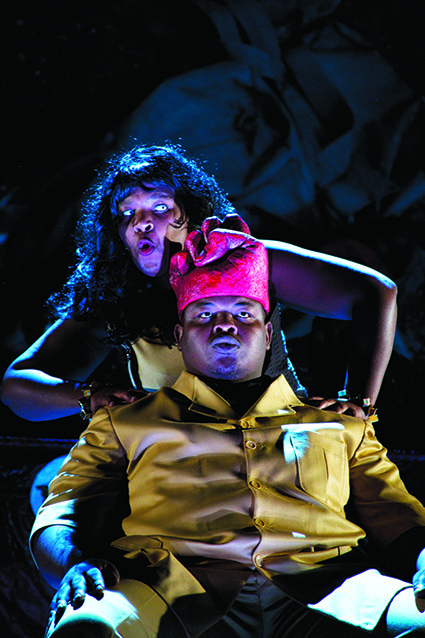
Macbeth
photo Nicky Newman
Macbeth
Third World Bunfight, Macbeth
Brett Bailey’s reconceptualisation of Verdi’s Macbeth was an altogether more sinister affair. Bailey’s company, Third World Bunfight, is committedly engaged with socio-political commentary in South Africa. The central conceit is that a troupe of East Congolese refugee performers stumble across a trunk full of musical scores and costumes that once belonged to a local amateur opera company who performed Verdi’s Macbeth. They use the outfits to tell their country’s own story of colonial corruption. That premise was something of a dramaturgical leap of faith, and not one I’m convinced was brokered clearly in performance. Once it was up and running, though, things cohered more clearly. Here, the three witches are converted into voracious mining company executives whose augury sees installation of a regime supportive of their own rapacious ambitions for the country’s resources. Macbeth (Owen Metsileng) is the corrupt puppet who benefits and grows decadent on his country’s imperial exploitation. The scene where he and Lady Macbeth (Nobulumko Mngxekeza) transform into booty-grinding bling-clad hip-hopsters (singing to the original Verdi score) is the highlight and the moment, for me, when the adaptation—the collision of parent text and contemporary interpretation—crystallised most successfully in performance.
It didn’t always feel like the audience was ‘there’ with the piece. There was some inane giggling whenever the word “fuck” appeared in the surtitled translation of the text, and despite the excellence of the singing by the entire cast, I sensed some audience detachment for long stretches. Perhaps this is, again, a dramaturgical problem with a parent text that doesn’t quite know when to end. As Berthold writes in the program foreword “Shakespeare’s play and Verdi’s opera are, I think, flawed works that very often fail to ignite in the theatre.” At various points, there are Brechtian interventions in the form of projected biographies of the chorus performers. We learn that several of these singers are themselves either former child soldiers or first-hand survivors of the Congolese wars, and suddenly, despite the didactic way in which this knowledge is introduced, the piece resonates more deeply. The musicians too (the No Borders Orchestra from central and eastern Europe) are reminders, as Berthold notes, that “homelands are torn apart in many parts of the world.” When the singers and the orchestra embrace each other during the curtain call, there is a theatre-wide standing ovation and that earlier disengagement is forgotten. The piece is, ultimately, a triumph of compassion over human greed and rapacity.
Brisbane Festival: The Theory of Everything, deviser, director Thomas Quirk, presented in association with Metro Arts, Theatre Republic, La Boite Studio, 15-19 Sept; Wild Rice, The Importance of Being Earnest, QPAC Playhouse, 11-13 Sept; Third World Bunfight, Macbeth, concept, direction, design Brett Bailey, QPAC Playhouse, 15-19 Sept
RealTime issue #130 Dec-Jan 2015 pg. 39
© Stephen Carleton; for permission to reproduce apply to realtime@realtimearts.net
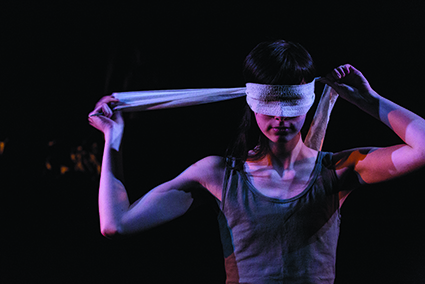
Carla Tilley in The Bacchae
photo Pia Johnson
Carla Tilley in The Bacchae
Melbourne in 2015 might be remembered as a place and time in which art took an unexpected turn towards the ecstatic. There was even an entire festival at our Arts Centre devoted to work that comes under the label. You could trace some genealogy back to trends in live art of recent years as well as durational dance works, the crossover of experimental sound art into more conventional theatre spaces and a shift away from irony and distance towards immersion and presence. But just as important has been the realisation that the hypnotic and trance-inducing needn’t be divorced from intellectual engagement. Stunning the senses doesn’t require the switching off of minds.
Two entries at this year’s Melbourne Festival left audiences truly dazed while also plumbing profound philosophical and political depths. Adena Jacobs’ and Aaron Orzech’s The Bacchae created havoc among audiences’ interpretative registers with its house-of-mirrors approach to voyeurism and the sexualisation of teenage bodies, while Andrew Schneider’s YOUARENOWHERE had many questioning the very reality into which they had somehow been dropped.
The Bacchae
To describe The Bacchae as Jacobs’ and Orzech’s work is a bit of a mistake, though it’s one that explains some of the concerned reactions several reviewers had to the piece. The pair are listed as co-creators (Jacobs directs with Orzech as dramaturg) but crucial to this free adaptation of Euripides’ text is the large ensemble of teenage girls whose responses to the original drama inform almost everything we see on stage.
Euripides’ tale is still here: the work begins with a murky, obtuse prologue in which a prostrate figure gives birth to an animal skull, alluding to the double birth of the god Dionysus. Pervy King Pentheus will make an appearance soon enough, too, and a recounting of the frenzied violence of the women on the mountain is directly drawn from the original tale. But for the most part the source material is dispersed across the bodies of the entire cast and refracted through a confronting teenage perspective.
Post birth-scene, a girl describes the boring rituals of her morning before announcing that she is Dionysus and will punish unbelievers. From here the rest of the work could be seen as a kind of increasingly ecstatic dance, beginning with the affectless stillness of a group sitting around staring at their phones or flipping through books and slowly building to a frenzied intensity of harrowing imagery and exulted obscenity. A hooded man with foam abs and a baseball bat stalks the space menacingly; a giant head with gaping maw inflates to take over most of the stage; a boy slouches listlessly on a sofa, staring dully at the eroticised spectacle unfolding before him.
It’s these erotics that have alarmed a few critics charging Jacobs with exploiting young girls for the audience’s gaze. The objection overlooks the fact that this is unmissably the point. The work’s most striking image occurs when a large portion of the cast appear in formation wearing bikinis and some kind of oil that renders their skin as shiny as plastic. Their heads are each bound in an opaque wrap that leaves them literally faceless. It’s as overt a representation of sexual objectification as one can imagine.
But the gaze here comes from the subjects themselves; or, rather, it is their own exaggeration of the gaze within which they are commonly framed. It’s not exactly news that the adolescent female body is sexualised in popular culture and that young women are treated as objects rather than subjects. It’s deeply unsettling to witness evidence that these same young women are highly aware of this, though. Rather than protesting that objectification, they here produce a nightmarish burlesque that amplifies it to an excruciating point.
It’s a brilliant enough move to ask young women to articulate their own subjugation of agency as they see others doing to them. To allow that othering of the self to escalate to such nightmarish levels is where the work goes one better. By its end, masked figures with giant hairy penises are humping every available surface and individuality has dissolved into a morass of animalistic violence and apathetic surrender. The bone-rattling oscillations of a modular synth crescendo while an onstage band has been beating out a tireless and insistent rhythm. The sustained spectacle of horror seems as if it will never end.
Then it does. The lights come up and it becomes shockingly apparent just how young these performers are. But as senses scramble to readjust to the everyday world, there’s the lingering understanding that the shit these girls are expected to put up with doesn’t end, really. It goes all the way back to Ancient Greece.
YOUARENOWHERE
YOUARENOWHERE is no less timeless in its reach. US artist Andrew Schneider performs alone, his shirtless torso wired up with various gadgets that allow for the live manipulation of his voice along with various other effects only his technicians probably understand. He delivers a wide-ranging monologue that jumps from autobiography to speculative physics, and by joining the dots it seems as if his ambition is nothing short of traversing the gap between possible universes. He kind of manages it.
The sophistication of the technology here is mindboggling. Schneider has in part been inspired by artists of light and space such as James Turrell. Through improbably precise manipulations of both Schneider is seemingly able to teleport across the stage in an instant or to cause parts of his body to simply vanish. The work’s great coup de théâtre—which nobody should ever, ever spoil—turns out to be less technical in nature and more the result of a sheer willingness to do what others daren’t try. Suffice it to say, it appears Andrew Schneider has achieved the impossible because the more likely scenario would be too hard for an artist to pull off.
Schneider’s discussion of special relativity and quantum dynamics and the possibility of human connection don’t really give any hints toward this final moment of dazzling spectacle, but the work’s conclusion so alters perception that it honestly appears as if physical limits have been broken. It’s hard not to wander off into the night questioning what other impossibilities demand rethinking, too.
Melbourne International Arts Festival: St Martins, Fraught Outfit & Theatre Works, The Bacchae, concept Adena Jacobs, Aaron Orzech, director Jacobs, dramaturg Orzech, performers St Martins Teen ensemble, music Kelly Ryall, design Dayna Morrissey, costumes Chloe Greaves, lighting Danny Pettingill, Theatre Works, Oct 8-24; Arts House, YOUARENOWHERE, created with collaborators by performer Andrew Schneider; North Melbourne Town Hall, Oct 15-19
RealTime issue #130 Dec-Jan 2015 pg. 40
© John Bailey; for permission to reproduce apply to realtime@realtimearts.net
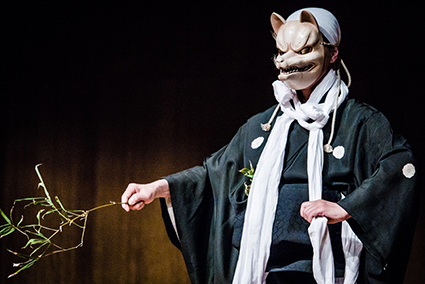
Yoke Chin as fox-dancer, Oppenheimer
photo Lee Nutter
Yoke Chin as fox-dancer, Oppenheimer
Cursed to live 500 lives as a fox for wrongly concluding that an enlightened being falls outside the laws of karma (cause and effect), the weary spirit of a monk, Hyakujo, has become legend. A waki (traveller) goes to Hiroshima to find a temple associated with foxes, where this ancient priest’s wisdom might ease his aching heart. There he encounters Hyakujo who later reveals his true identity as the ghost of Robert Oppenheimer (whose spirit is a shape-shifter), cursed to a cycle of suffering for his contribution to the making of the atomic bomb. The action unfolds, typically slowly, with every opportunity for allegory taken.
Part of the story is told from the viewpoint of siblings who have come to the fox temple to honour the grave of their father, killed in Hiroshima in 1945. The daughter performs a fox dance while her brother and the traveller look on. In Japanese mysticism foxes are shape-shifters and fox-symbolism often indicates messages from the afterlife. There are two kinds of spirit foxes though, Inari (the good rice-prosperity deity) and Yakkan (evil mischief-maker), and perhaps for this reason foxes signify schizophrenia in some Japanese art. Hot tip for budding Noh fans: when the fox-dancer bears a branch it implies she is herself; when not it suggests she is possessed by the fox spirit.
When the siblings depart, Oppenheimer’s ghost re-appears in fantastic gilded kimono and long black wig and is confronted by the Buddhist wisdom king Fudô Myô-ô in even shinier robes and a bright red wig. He sets Oppenheimer free from his anguish once Oppenheimer voluntarily immolates himself by entering the fires of Hiroshima. Fudô Myô-ô is usually depicted seated resolute in flames, carrying a sword and snare to liberate people from impediments to enlightenment. He appears fierce but is a force of positive change, like Kali in Hindu mythology. The play alludes to the burning pain suffered by the people of Hiroshima and Oppenheimer trusts that his immolation will relieve the torture inflicted by his (but not his alone) careless application of scientific expertise.
The creator of Oppenheimer, Allan Marett, built layer upon layer of metaphor into the plot, each scene looking at equivalent situations from different angles. This approach mirrors a Zen method of enquiry. One of his inspirations was a collection of Zen koans, the Mumonkan (‘a gateless barrier’), which contains the story of Hyakujo and his fox lives. Marett mused over this story and created a drama where the protagonist seeks deliverance from torment born of his impeded perspectives. Oppenheimer is dazzled by that Zen emptiness which is limitless, formless and has no inverse: Like Hyakujo he misunderstood its relationship to the material world. Oppenheimer misused a scientific discovery so destructive it consumed him too. With taut, well-woven themes, pregnant with signification like so much stylised Japanese-inspired art, Oppenheimer reveals a mastery of form that is also social commentary.
When it comes to stylisation, it’s as much about what’s not there as is there. The torpid sparseness of Noh makes the costumes seem more elaborate, the text more parabolic, the music sweeter and the dance more ecstatic. It heightens every particular. In the performance I saw, within the Noh orchestra always visible on stage, I thought I detected a combative dynamic playing out between the o-tsutsumi and ko-tsutsumi drummers which drew my attention because Noh’s form affords space for reflection. Their exchange reconfigured the energy of Oppenheimer, reinforcing the emotional journey of all the troubled souls that met in the story.
All the performances were excellent, especially the chorus made up of local performers along with David Crandall as the waki; those in masks (made by Hideta Kitazawa): John Oglevee as Oppenheimer; Akira Matsui as Fudô; and Yoke Chin as fox-dancer.
Marett, Emeritus Professor of Musicology at Sydney University, a Noh specialist and the librettist for Oppenheimer, went to Japan 40 years ago to understand Noh. His collaborator on this work, Noh performer and instructor Richard Emmert, formed Theatre Nohgaku in Tokyo so he and friends could produce Noh plays in English primarily for English-speaking audiences, as a way to generate further interest in the form.
Sung through elaborate masks in a low grumbly warble, characteristic of shomyo (ancient Japanese Buddhist monody), the text remained unclear, despite the performers’ excellent diction and vocal production. Surtitles helped, especially in catching quotations and references, for example to the Faust story.
The waki is a fictional character inspired by Marett’s personal experience: in 2013 Marett was drawn to Hiroshima while walking the 1200km coast of Shikoku as a Henro pilgrim. Approaching Hiroshima, he and wife Linda realised they were ‘following the path’ of the bomb-carrying Enola Gay, adding heaviness to their grieving steps. Together they chanted, through tears, the Emmei Jikku Kannon-gyo, an invocation of compassion that concludes, “Thought is not separate from mind.” Deeply knowledgeable creative minds invested in living and preserving Japanese art forms here—Emmert (music), Marett (text) and Matsui (director)—have produced in Oppenheimer a truly moving work.
You can see the full production here.
Oppenheimer, A Noh Play in English, text Allan Marett, music Richard Emmert, choreography, direction Akira Matsui, masks Hideta Kitazawa; Sydney Conservatorium of Music, 30 Sept-1 Oct, www.theatrenohgaku.org
RealTime issue #130 Dec-Jan 2015 pg. 41
© Felicity Clark; for permission to reproduce apply to realtime@realtimearts.net
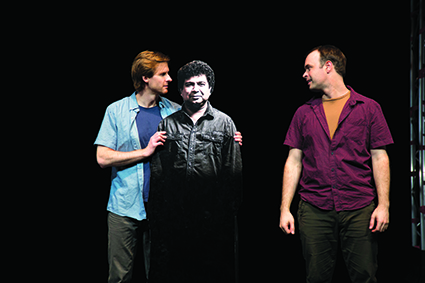
A Sri Lankan Tamil Asylum Seeker’s Story as performed by Australian Actors under the guidance of a Sinhalese Director, Merrigong Theatre Company
photo Carolyn Nowaczyk
A Sri Lankan Tamil Asylum Seeker’s Story as performed by Australian Actors under the guidance of a Sinhalese Director, Merrigong Theatre Company
Relations between regional Australia and refugees are complicated. On the one hand, some of our most conservative politicians come from rural and regional Australia. They have not only endorsed Operation Sovereign Borders, but also demonised anyone who dared to cross those borders, even when they have been found to be genuine refugees. On the other hand, some regional mayors have proven far more progressive than their city counterparts. Mayors in country NSW and Victoria have wholeheartedly embraced asylum seekers as valuable community members and workers who are willing to do jobs the locals are not, such as meat packing and fruit picking. Yet most of the theatre made by, with and about refugees over the past 15 years has played to city audiences. For this reason, A Sri Lankan Tamil Asylum Seeker’s Story as Performed by Australian Actors Under the Guidance of a Sinhalese Director, which is playing in Wollongong—a town of about 250,000, a two-hour train ride south of Sydney—intrigues me even before anyone appears on stage.
The play, written by Dhananjaya Karunarathne, dramaturged by David Williams and directed by both, weaves between two realities: that of a Tamil asylum seeker fleeing Sri Lanka and finding his way to Australia; and that of two white Australian actors trying to rehearse and perform a theatrical version of this story. The set consists of two steel arches: one upstage and one downstage. They are connected by a web of red ribbons, which run out into the upper reaches of the auditorium. Some have pieces of paper tied to them: they might be letters from asylum seekers held in detention or they could just as easily be old drafts of the script. It’s this line between reality and theatricality that the performance constantly blurs.
The play begins with a crash course on Sri Lanka and its history. The house lights are, unnervingly, still up as the actors debate whether they should wear blackface and/or adopt an accent. It seems unwise. “Any Sri Lankans here?” they ask. “Are you upset yet?” The absent playwright, represented by a roughly life-size cardboard cut-out, is dragged onto the stage and the patter continues. The actors wonder whether Sri Lanka might become the new Bali and muse on the fact that everyone in Australia is a migrant. “Anyone here from Syria?” Silence. “Not yet,” they joke. We are invited to sing “We Are One, We Are Many.” I can’t bring myself to do so, but others do. Finally the patter stops when one actor interrupts the other in character, shouting “Do you have any idea what your people have done to mine? And now you want to tell a Tamil asylum seeker’s story for your fucking research or career?”
From here the play engages more fully with the story of a particular asylum seeker, Raja. We see him in a refugee camp, forced to leave his small daughter in the care of a woman he does not know in order to ensure his own survival. However this reality is never allowed to solidify or settle, so it is interspersed with scenes of the actors rehearsing Raja’s life in the refugee camp and arguing over who can deliver his monologue with the appropriate amount of emotion. The same thing happens as Raja huddles on a boat while a journalist cajoles and eventually coerces him into telling his story, only for one actor to break the scene and demand: “Where are the props?” While some scenes reference real events, others involve real labour, such as when the two actors, dressed as customs officials, lug heavy body bags from backstage to centre stage. In another moment, there is a false interval: the lights come up and the actors tell us to get out of the theatre. Just as we are about to leave, the lights dim—they just wanted to give us a tiny taste of what it is like to have to leave a place before time and against one’s will.
In the last third of the play, Raja, by now in immigration detention, meets a student, Garth, who is doing his Masters in Refugee Studies. The student’s interviews play out over several months, during which time Raja’s partner falls pregnant. Once again, reality is disrupted, this time by the actors rehearsing different endings to Garth and Raja’s final encounter. In one, Garth is righteous and judgmental; in another apologetic and forgiving; in still another, there is a violent confrontation between the two. But this is deemed unacceptable because “it’s not a good way to end your story.”
Is there a good way to end this story? Or more to the point, will this story ever end? Immigration detention was introduced in Australia over 20 years ago and there is now an abundance of evidence confirming the deep damage it inflicts. Yet refugee policy remains at an impasse. Until recently I thought this might be true of theatre too, however some of the work I have seen this year has made me reassess this (see RT126, p6). Dhananjaya Karunarathne’s play suggests that comedy and metatheatricality might provide some unlikely ways through.
Merrigong Theatre Company, A sri lankan tamil asylum seeker’s story as performed by australian actors under the guidance of a sinhalese director, writer Dhananjaya Karunarathne, directors Dhananjaya Karunarathne, David Williams, performers Adam Booth and Anthony Gooley, dramaturg David Williams, designer Imogen Ross, lighting Matt Cox, sound design Rob Hughes; Illawarra Performing Arts Centre, Wollongong, Sept 16-26
RealTime issue #130 Dec-Jan 2015 pg. 42
© Caroline Wake; for permission to reproduce apply to realtime@realtimearts.net
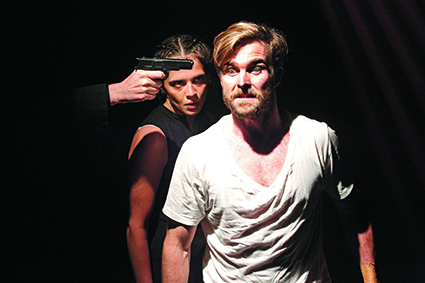
Slow Love, Richard Murphet, La Mama Theatre
photo Jeff Busby
Slow Love, Richard Murphet, La Mama Theatre
Let’s start with a remark from the philosopher Gilles Deleuze: “The modern fact is that we no longer believe in this world. We do not even believe in the events which happen to us, love, death, as if they only half concerned us. It is not we who make cinema; it is the world which looks to us like a bad film.”
Is this true? Does the modern world seem to us like a poorly scripted romantic comedy or a banal disaster flick, some vast congeries of clichés, a place where nothing new ever happens? And can theatre restore our faith in the real? Can it cut through the formulaic conventions and re-connect us with the world as it is, and with the elemental influences of love and death?
These questions—it seems to me—are crucial to Richard Murphet’s Quick Death and Slow Love, two short plays first produced at La Mama in the early 1980s and revived here for the Melbourne Fringe Festival.
The room is empty except for a single chair and an old mattress. A young man in blue slacks and a white T-shirt enters. He seems uneasy, unsure what to make of this small, dimly lit space. From offstage we hear the sound of typing and the cry of a baby. The man sits in the chair, as if to settle his nerves. Then he stands up and turns to the audience—and all at once his uneasiness transforms into a look of horrified recognition. We hear a gunshot. The man falls and the lights go out.
When they come up again, he is back on his feet. We hear another gunshot. Once more he collapses, once more the lights go out. And that’s the machinic process of Quick Death, a lightning pageant in which the man, Raymond, is gunned down some 30-odd times in less than an hour.
“Men kill other men,” says a woman from offstage, as if issuing a sombre mandate. “Mostly men kill other men.” And this is what happens. Other voices are heard and other figures are seen: images and snatches of dialogue from an ensemble of crime films and noir thrillers accumulate. But in this dark, dissociated world the only through-line is fear, and the danger of violent death.
Quick Death first appeared in 1981 as part of Jean-Pierre Mignon’s premiere Anthill season and featured on a double bill with Artaud’s To Have Done with the Judgment of God. During the late 1970s, Murphet was a core member of the Australian Performing Group offshoot Nightshift, and Quick Death can be seen as a continuation of the confrontational energy of that inspired, self-dramatising avant-garde collective.
In 1983 he developed Slow Love, a sort of companion piece. Like the first, this second play develops image by image, segmented by blackouts, parodying filmic tropes. As the title indicates, however, the rhythm is more measured, with none of the earlier work’s convulsive violence. Instead it has a sort of quiet intensity—mesmeric, not disruptive. Across more than 80 brief scenes we watch four figures, two male and two female, fall in and out of love, arranging and rearranging themselves according to a logic of exhaustive variation.
Directed for the first time by Murphet himself, and revised in collaboration with the present cast, the two plays are performed here without interval. It is the physicality of the production which most impresses. Murphet’s method is to body forth the clichés of love and death—and, in the process, to exaggerate them—reducing spectacular distance and asserting a sense of communal space.
The actors deserve credit—and so do the sound and light operators—for throwing themselves so wholeheartedly into this quick-change tumult. Even in Slow Love, we still sense the bodies hurtling around backstage between the many scenes. Always we are conscious of the physical effort needed to transform the scudding shades of the cinema into theatrical substance. Kevin Kiernan-Molloy is particularly memorable as the eternally doomed central figure of Quick Death, staggering and swaggering and forever going down.
Live performance, the movement of bodies in an empty space, exhausts the glamour of cinema, pushes it until the spell breaks; and in the aftermath we sense the possibility of something new, something beyond the serried repetitions of the silver screen.
But I also wonder. The regime of images that these two plays engage recalls an earlier, perhaps simpler time, say of Humphrey Bogart and Lauren Bacall, of The Big Sleep and To Have and Have Not. Today the romance machine produces gonzo pornography. And the death machine gives us a vast and always open library of digital snuff videos. It is no longer just Deleuze’s “bad film” which stands between us and the world. Now there is also the bad meme. Clichés proliferate at 100 megabits per second: can even the most passionately experimental live theatre keep up?
Or does it come back to faith—faith that there is always some new creative possibility hidden within the real? In these two plays, both more than 30 years old, you do sense a kind of reverent power, a manifest conviction, even if, in performance, it is apprehended only for a moment, in the darkness and the charged silence that precedes the applause.
[To read more about Quick Death, Slow Love and other works by Richard Murphet, go to Denise Varney’s Radical Visions 1968-2008, Rodopi, Amsterdam & New York, 2011. Eds]
La Mama Theatre, Quick Death/Slow Love, writer, director Richard Murphet, performers Kevin Kiernan-Molloy, Emma Tufrey Smith, James Cook, Naomi Rukavina, sound design Daniel Czech, set design Jacob Battista, lighting Steve Hendy, costumes Rebecca Dunn; La Mama, Melbourne, 30 Sept-11 Oct
RealTime issue #130 Dec-Jan 2015 pg. 44
© Andrew Fuhrmann; for permission to reproduce apply to realtime@realtimearts.net
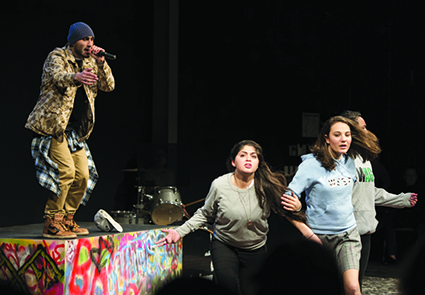
Matuse, Naomi Nazarin, Aida Zjakic, The Way
photo Lee Pham
Matuse, Naomi Nazarin, Aida Zjakic, The Way
David Byrne, former frontman of Talking Heads, once wrote of Australia’s suburbs as “a residential theme park in what is essentially a desert.” Though there’s some truth to this, I can only guess Byrne didn’t visit the western suburb of Bankstown, a small metropolis 45 minutes away from the city but vastly different from it. Greater Western Sydney is highly culturally diverse, with 40% of the population born overseas and with predictions that in the next 15 years, the area will accommodate 60% of Sydney residents; it’s hardly a marginal area despite its meagre arts funding allocation.
So it’s little surprise there’s something unique developing in the art world here. Though there is not one artist-run gallery in Greater Western Sydney (Hazelbrook’s West Space was recently moved on from its home), institutions like Powerhouse Youth Theatre, Urban Theatre Projects and Casula Powerhouse continue to craft innovative programs that aim to find a home for arts and culture in the region rather than export the best of the west to the city.
To this list we can add Bankstown Arts Centre, which in October hosted a 10-night run of The Way, the final in a trilogy directed by Stefo Nantsou, produced by Bankstown Youth Development Service and gathering a number of local companies including the Australian-Macedonian Theatre Group. The production was born of a series of workshops from which participants’ own stories were crafted into a loose narrative. It’s one of those ‘day in a life of a community’ premises, tracing abundant subplots and families, beginning with an early morning scene at Sydney Airport Arrivals Hall and moving into the heart of Bankstown as characters find their way through the big personal-political issues of today. On the way, we detour through Bankstown Central shopping centre, the Sports Club, the main bus stop and a bunch of other locales that audibly stir audience recognition.
It’s a minimalist production, from the barebones set, live musical accompaniment from local musicians and large-scale projections providing backdrops of shifting locations. I counted roughly 30 people on stage and heard at least half a dozen languages. The subplots range from forgettable to compelling, the most fully realised being the stories of the Islander Tamati family reuniting after a brother’s death; a man called Minh Tran dealing with the break-up of his family and the migration of his elderly father; and a young Arab Australian, Mohammed, reacting with anger and shock to racist treatment by Border Security after a holiday in Thailand.
Though these subjects might seem dark, the show is less about a deep engagement with politics than empowering participants by just placing them on stage. Nantsou has crafted an irony-free zone with the dramatic stakes set low, creating a feel-good production about the unity of community—something Hollywood marketers might call the human spirit but which is really just the beliefs we all hold in common. Music is a particularly important storytelling ingredient in The Way, with the Tamati family leading the show’s high point—a mourning song at their vigil, which raised the hairs on my arms.
It’s telling that a community-based cultural development group rather than a traditional theatre organisation has produced The Way. Though the trilogy of which it is a part was originally made under the auspices of Sydney Theatre Company, where Nantsou has been artist in residence, The Way has the feel and the vitality of community theatre. This is its strength and its weakness. The night I attended was sold out, many of the audience members clearly friends and family—vocal, diverse and conveying the sense that we were all part of something. I felt that I participated rather than attended and was being spoken with rather than spoken to. It’s the kind of a show whose heart-on-sleeve hyper-sincerity would be considered discomfiting any closer to the CBD, a show during which you realise that the Chippendale ARI you’ve been frequenting is comparatively a pretty white place in contemporary art right now.
The Way isn’t a great show, nor is it deeply ambitious or substantial, it’s more like a lovely gathering. The directive is inclusivity and the drive is for optimism and theme over character and plot. This is the stuff that Bankstown Arts Centre specialises in alongside professional productions and development: cultural events like their excellent regular poetry slam, that highlight first-hand experiences of migration, gender, race, ethnicity, religion and class. The Way might not meet all the ‘excellence’ criteria being thrown around by arts policymakers; rather, it provides serious access to participation in the arts. That’s its function in the arts ecology. The Way understands that theatre is a shared experience—an exercise in empathy, for everybody.
BYDS [Bankstown Youth Development Service], The Way, Bankstown Arts Centre, 1-8 Oct
RealTime issue #130 Dec-Jan 2015 pg. 45
© Lauren Carroll Harris; for permission to reproduce apply to realtime@realtimearts.net
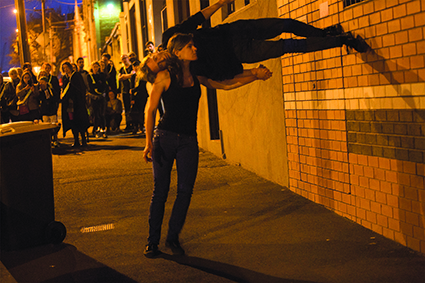
Bodies Over Bitumen, Naomi Francis, Skye Gellmann
photo Ponch Hawkes
Bodies Over Bitumen, Naomi Francis, Skye Gellmann
Three interdisciplinary circus performers lead an audience on a 60-minute wander through the streets of North Melbourne. At intervals, we stop to watch their ‘tricks.’ But in a manner rare for circus-based works, Bodies Over Bitumen deeply engages both performers and audience with the site. Dressed-down in jeans, sneakers and hoodies, the artists carry stuff around that suggests they could be travelling, or even homeless.
The way we are led is fugal—a passing cyclist (Alex Gellmann) provides our initial cue to follow, disappearing when we notice another performer and stop to watch, then returning at unpredictable intervals. As one act finishes, another performer—not always Alex—subtly distracts us and we move to follow again. It’s a kind of guided flâneuring, each segment dovetailing into the next.
Early on we pause to watch Naomi Francis pull aerial silks and rigging gear from a bulky backpack. She contemplates an exposed beam over a gated laneway, figuring out how to rig it. Perhaps put off by a car entering earlier, she seems to change her mind, stops, stuffs everything back in her bag and strides off fast enough for us to lose her trail. She looks lean, maybe even mean. On her way where? The cyclist swings around a corner into view as she disappears into the night.
Francis’ initial caution is countered by her eventual claiming of the night-time streets: it’s she who later suspends herself from a tree to perform a space-eating aerial routine in black gym gear, no spangles or frills. And it’s her body that supports four heavy strands of webbing in the centre of a roundabout for Skye Gellman’s slacklining routine, evincing awareness of the risk, physical strength and vulnerability that lies at the heart of circus.
Alex Gellmann tore major shoulder ligaments in a cycling accident ahead of the show. His sling-strapped arm can’t help him as he rides his bike one-handed, or both one-handed and seated back-to-front, or carries it on his shoulder. His tricks are necessarily curtailed, but this evidence of a real-world encounter with risk and danger cements his role in the work. Somewhat ‘broken’ himself, Gellmann marks his path at intervals with miniature cairns of shattered pavement illuminated by bike lights. In a tricky balance-board routine, he incorporates these fragments, tossing them with his usable hand and catching them on his head.
In what for me is Bodies Over Bitumen’s key scene, the performers do nothing. Skye Gellmann lies starfished in the middle of a narrow side street; Alex Gellmann flops in the gutter, half on the footpath. They lie there for a long time. Francis crouches against a brick warehouse with her too-big backpack.
Now and then a car turns into the street. Francis calls “Car!” and the guys roll quickly to the footpath and sit facing the road till it’s passed; then return to position. The scene intensifies, sparks literally flying, when Skye Gellmann begins scraping the ground with a hefty flint. Entering vehicles hesitate and we feel their intrusion and ours—as well as the folly of lying in the middle of the road. It’s a poetic and visceral pause that stretches into long minutes, pulling our guts right down to the tarmac.
At the end of Bodies Over Bitumen, Skye Gellmann applies virtuosic pole-acrobatics to a parking sign, twisting, circling and shimmying without ever touching the car parked close alongside. With a rare combination of strength, technical ability and dancerly poise, he illuminates, tests and defies gravity. Even arching on the footpath at the base of the pole, he maintains a defiant, balletic relationship to gravity’s incontestable force.
With histories spanning homelessness, squatting and street daredevilry, Bodies Over Bitumen’s creators are credentialled with lived understandings of space and who it belongs to, as well as how to claim and disrupt it. With a shared language born of past collaborations, they create a mood sometimes of aimlessness, sometimes of interrupted purpose, and equally of experimental occupation. Even the best of ‘new circus’ often boils down to a sequence of thematically related ‘acts,’ failing to create emotional immersion. By contrast, Bodies Over Bitumen places us in direct relationship to the surface of the road, making the space of the streets subtly dangerous, but also a place to play. It illuminates and destabilises the city environment, gaining our investment in uncertainty and caution from the start. From a modest approach—this work really hinges on the ‘less is more’ philosophy—Gellmann, Francis and Gellmann, with off-stage creative collaborator Kieran Law, have created something quietly extraordinary.
–
Bodies Over Bitumen, creators, performers Skye Gellmann, Naomi Francis, Alex Gellmann with Kieran Law; Melbourne Fringe Hub, North Melbourne Town Hall (starting point), 18 Sept-3 Oct
RealTime issue #130 Dec-Jan 2015 pg. 46
© Urszula Dawkins; for permission to reproduce apply to realtime@realtimearts.net
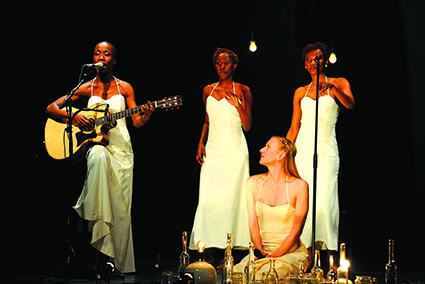
Desdemona
photo Mark Alan
Desdemona
“I’m thinking it would be more fulfilling for the viewer if she or he had read Othello.” Toni Morrison, NY Times, October 2011
Filling in at short notice for our reviewer suddenly confined to quarters with a twisted ankle and having no time to read the play, I invite a friend to accompany me to Desdemona, a former schoolteacher who’d spent the best part of a decade casting light on Othello for students. As it turns out, a close knowledge of the play proves in her opinion to be more of a disadvantage.
In his personal introduction, director Peter Sellars prepares us for a meditation. The stage is suitably serene—four narrow mounds of soil embedded with soft fluorescent light and glass jars containing candles as might be encountered in a burial ground. Desdemona’s ritual reappraisal of the events of Shakespeare’s play is carried out in the after-life.
The production works multi-vocally. Desdemona (Tina Benko) slips the confines of the play to recite her version of events in the slow, sensory, ‘right on’ tones of Toni Morrison, at times dropping into a resonant bass to channel Othello himself. In contrast, Malian singer/composer Rokia Taororé, eyes often downcast and with minimal gestures, delivers a smooth and sensuous counterpoint in song accompanied by two female vocalists and two musicians on traditional African instruments.
A word in Shakespeare’s text provides the impetus for Morrison’s departure—mention of “Barbary” and, following quickly on, the possibility that the maid who raised Desdemona was African and strongly influential in her upbringing.
There is a sense at the outset that we’re in for some revelations. Traororé as Barbary is a graceful presence, her strong words at the outset instructing the desultory Desdemona (“My name means misery”) in her feminine powers. But as the ritual unfolds and the rhythms of Sellars’ staging recur, the conceit drifts into question. “I am not the meaning of a name I did not choose,” says Benko’s Desdemona and I wonder, for instance, just how far a character may stray from the mind that imagined her and still answer to that name.
Distracted now, it occurs to me that an audience seated in the round or at closer quarters might have more sense of connection with this work. As it is, in the large space of the Sydney Theatre, the static Benko’s voicing of three characters now—she has added Iago’s wife Emilia—is having a distancing effect. Though Rokia Traroré’s songs attempt to disrupt Desdemona’s view of her predicament, she still appears to see herself through the eyes of her lover—taking on his voice, giving the impression she’s possessed by this man’s spirit or that the two exist in the one body.
“What happened to Iago and jealousy?” whispers my friend. Next day she emails, “Othello’s tragedy is that he doesn’t know himself and he’s coerced by the deceitful Iago into betrayal, believing that the innocent Desdemona has been unfaithful to him with Cassio. He’s already jealous of Cassio and willing to trust Iago over the woman he loves.”
Wednesday and we’re still tossing it around. Certainly, we agree, there’s beauty and pity in Traororés music, which is full of sad restraint. But we’d expected Toni Morrison might have something stronger to say about this tale of a good and trusting woman going willingly to her death at the hands of her lover.
And then, in this production Desdemona is faced with an unlikely confession from Othello to a secret shared with Iago that they had raped two elderly women watched on by a young boy. Refusing forgiveness, Desdemona professes enduring love and surrenders once more to her fate. But, we wonder, where is the regret beyond that final line, ‘We should have talked about this’?
By Friday the two of us agree that while we’ve enjoyed talking through Desdemona, what Toni Morrison has described as a ‘talking back’ to Shakespeare is perhaps less revealing than a more directly engaged dialogue with the play might have been.
Desdemona, Toni Morrison’s Re-imagining of Othello, Director Peter Sellars, Sydney Festival 2016 Roslyn Packer Theatre, 23-24 October
RealTime issue #130 Dec-Jan 2015 pg. 47
© Virginia Baxter; for permission to reproduce apply to realtime@realtimearts.net
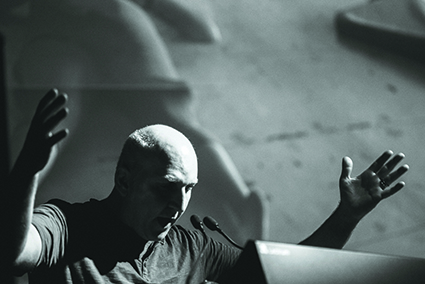
Brandon LaBelle
photo Keelan O’Hehir
Brandon LaBelle
The exhibition statement for Capitalist Surrealism is the ultimate in sponsorship acknowledgements: “this program of lecture-performances by sound artists is brought to you by the new cultural logic of capital—real, but honestly, also kind of surreal.” A one-night event, Capitalist Surrealism aimed to assay capitalist social formation by thinking through the surreal processes and possibilities that are our economic life. Held at the National Gallery of Victoria and curated by Liquid Architecture, Capitalist Surrealism encompassed nine lecture-performances that engaged, wrestled with and thought beyond our capitalist present.
Brandon LaBelle
The opening performance by Brandon LaBelle, an American-born and Berlin-based writer, artist and theorist, established the event’s theme. Titled Confessions of an Overworked Artist, or, Strategies for an Impossible Practice, LaBelle’s performative mixture of spoken word and visuals reflects the social structures the artist works within, while also attempting to work beyond them. From the beginning he presents himself as the third-person ‘every artist’: “he often imagines what might be possible, the horizon of ideas and solidarities.” The forcefully charismatic LaBelle delivers a stream of consciousness avalanche of ideas: flight details, questions about the republic, budget concerns, application deadlines, democratic crises, theoretical quandaries…. The larger concerns of aesthetic practice are interspersed with lines humorously referencing the quotidian life of the artist, as LaBelle says, “and what of cognitive capitalism? Have to pick up the dry cleaning.”
LaBelle’s quick and urgent recital captures both his own permanent restlessness and further mimics a world determined by speed and information overload. Yet no matter how abstract or conceptual LaBelle’s thoughts become, the accompanying photographic slideshow features scenes and objects that unavoidably entwine the artist with the social world. However, Capitalist Surrealism is rarely directly evident in LaBelle’s words and images; instead he subtly positions art as something social rather than purely money-related, echoing the notion that we live in a society, not simply an economy. The piece finally builds to the central paradox that concerns LaBelle as he asks, “Overworked? Or the work that sets us free?” The answer, of course, is both, LaBelle’s performance portraying the artist as perpetually moving through a social life of competing ideas, relations and possibilities.
Saskia Doherty
In the Miner’s Companion, Saskia Doherty takes to the stage to recite a list of seemingly unrelated words in alphabetical order, signalling for some of the audience a possible test of endurance, but the performance reveals an acute and noteworthy logic. Doherty’s long list is extracted from a 1920s South African mining lexicon that translates words from English to a South African dialect, Fanakalo. This lexicon, likewise titled The Miner’s Companion, ensured communication between English-speaking miners and the South African workforce—but through a dialect that only references the technical components of machines, extraction processes, injuries, money and the barest of quotidian terms. The dryness of the list is made evident by Doherty taking large, exaggerated breaths and then proceeding to whisper as many words as one exhalation allows. This process repeats until every term in the lexicon is extracted: a process not unlike mining itself.
Doherty’s recitation is meaning-laden, but my attention is foremost on her voice and whispering, her delivery mimicking that of a miner who has developed pneumoconiosis—miner’s lung. By evoking the body, voice and language of the miner and broadcasting it, miner’s lung becomes a form of communication which speaks of how the material basis of capitalism disadvantages certain voices and bodies. In thinking through the linguistic and bodily processes of capitalism, the virtue of the performance resides in its recuperation of a mining history that is rarely acknowledged, perfectly conveying the violence of mining and by extension capitalism. The contemporary relevance of the performance is subtler, prompting reflection on our own language and how it is unconsciously determined by capitalism.
Tom Smith
What might an artist do with Pro Tools, Luc Boltanski and Eve Chiapello’s The New Spirit of Capitalism, online costume stores and fast cars? The answer is found in Tom Smith’s The New Spirit, the highlight of the evening. Armed with a laptop and headset, Smith interprets The New Spirit of Capitalism, a book centred on how contemporary capitalism appropriates the ideal of freedom as the basis of its networked logic. Smith renders the book’s sentences as sound, evoking the generic nature of contemporary music by producing a sound work using only the most familiar drum beats, rhythmic patterns and post-production processes of a culturally dominant MP3 sound world. Consequently when he speaks the authors’ words he renders them generic, signalling a loss of agency and political meaning—words becoming auto-tuned beyond aesthetic control. Networked capitalism feels natural and seems to offer agency, while mainstream music may likewise feel like it empowers artistic creation, but perceived freedom is lost to generic convention.
As Smith plays his sonic creation, he simultaneously peruses the virtual aisles of dress-up costumes and luxury cars and humorously attempts to purchase fake SoundCloud ‘listens’ to use in his own music. Importantly these signal new capitalism’s illusion: that we each operate as free agents who maximise our own interests and build ‘unique’ identities through consumption of generic items.
These lecture-performances don’t realise Capitalist Surrealism’s critical ambition, to imagine ‘horizons’ beyond the naturalised surrealism of capitalism. Rather each takes a particular facet of capitalism we are not necessarily conscious of and shows how it naturalises the actually surreal everyday. For these artists thinking of another ‘horizon’ begins by first thinking through how capitalism works on us.
Liquid Architecture, Capitalist Surrealism, National Gallery of Victoria, Melbourne, 24 Sept
RealTime issue #130 Dec-Jan 2015 pg. 48
© Tiarney Miekus; for permission to reproduce apply to realtime@realtimearts.net

Arcko Symphonic Ensemble
photo Langdon Rodda
Arcko Symphonic Ensemble
An all-star band of swashbuckling musicians, the Arcko Symphonic Ensemble has a reputation for performing some of the most sublime and yet neglected Australian works. It makes sense then that they should champion one of Australia’s most sublime and neglected composers, Nigel Butterley. Butterley belongs to a generation of luminous and relatively well-funded composers including Peter Sculthorpe and Richard Meale, but stands out for not taking a reactionary, post-impressionistic turn in later life. His music is detailed and spacious like a rambling baroque manor house. One wanders the halls of his mosaic forms listening for clues, taking new paths, and circling back on old ones. Arcko celebrated Butterley’s 80th birthday with performances of iconic works and a new piano concerto by his former student Elliott Gyger.
Uttering Joyous Leaves
The piano solo Uttering Joyous Leaves is a riot of colour. Pointillist atonality shares the piano with snatches of blues modes and tonality, here jumbled together and syncopated with exceptional spirit by pianist Zubin Kanga. Pitches are scattered around like the oak tree in Walt Whitman’s poem “Uttering joyous leaves all its life without a friend, a lover near.” But not all is joy and light. There are dark undertones, shadows under the leaves. Kanga smiles through the effort of realising this virtuosic piece composed for the 1981 Sydney Piano Competition. After the performance, Gyger explained how the piece is “distilled Butterley” with “almost” everything wonderful about his music condensed into five minutes. What is missing is the expansiveness evident in the rest of the program and in works like Laudes, which Arcko performed in May last year.
In the Head the Fire
Butterley’s radiophonic work In the Head the Fire eschews the musical meteorology of his generation. In the place of birdsong and rain one finds the howling of wolves amid incantations from the Dead Sea Scrolls. The piece is of its time, composed shortly after the Scrolls were popularised by their translation into English in 1962. The piece would also find favour with today’s ritual-and-wolf-obsessed art school students. Aided by the space and watts of the Iwaki Auditorium, the superimposed choirs and orchestras were vast and cinematic. The vocal writing and subject matter is reminiscent of Schoenberg’s Moses und Aron, which was transformed into a film by Jean-Marie Straub and Danièle Huillet in 1973. In the Head the Fire notoriously pipped Berio’s Laborintus II at the post for the Prix Italia in 1966 and I like to imagine Huillet and Straub tuning in to this work of biblical proportions as they planned their film.
From Joyous Leaves
In From Joyous Leaves Gyger expands the material of Uttering Joyous Leaves into a 25-minute concerto for piano and chamber orchestra. He provides a nuanced mosaic form that speaks an obscure and enticing narrative (though Gyger insists the stakes are purely musical). The effect is like listening to a story told in another language, an experience I recall from Defunensemble’s All Finnish concert at the Bendigo International Festival of Exploratory Music in September. The piece opens, like Butterley’s From Sorrowing Earth, with sweet harmonies in mellow violas. The orchestra and piano begin quoting Butterley’s piece, Kanga throwing fistfuls of note-confetti into the air. The magnificent display of orchestration continues until—all of a sudden—the piano strikes out a metallic tone, then another and another. The piano had been prepared all along (a reference to Butterley’s performances of the prepared piano works of John Cage), but Gyger carefully avoids the 22 prepared keys until halfway through the piece. The transmutation of the piano is revelatory, a little musical miracle at the heart of this intricate work.
From Sorrowing Earth
Butterley’s From Sorrowing Earth is as much a masterpiece as dozens of other works that regularly grace our state orchestral programs and Arcko deserves high praise for mustering the large forces required for a well-overdue performance. The title refers to the piece’s epigraph, a poem by Kathleen Raine describing renewal after environmental desecration. The piece likewise moves from plodding, dark episodes to freer, lighter textures, ending on a single harp harmonic. According to Elliott Gyger’s program note the piece’s message is moral and spiritual rather than political, but a 30-year-old listening to the work is not going to hear it the same way as an 80-year-old (or even the 65-year-old who composed it in 1991). The piece reflects the Cold War binary of destruction and renewal, at a time when a change of spirit really was essential in avoiding nuclear holocaust. But the decline of humanity under global warming will be slow and painful fuelled by actions not taken long ago, actions half-taken now and who knows what sort of action in the future. But perhaps the spiritual message of From Sorrowing Earth is precisely what is needed in the face of global environmental collapse.
Arcko Symphonic Ensemble, From Sorrowing Earth, composer Nigel Butterley, piano Zubin Kanga, conductor Timothy Phillips; Iwaki Auditorium, Melbourne, 31 Oct; podcast by ABC Classic FM
RealTime issue #130 Dec-Jan 2015 pg. 49
© Matthew Lorenzon; for permission to reproduce apply to realtime@realtimearts.net
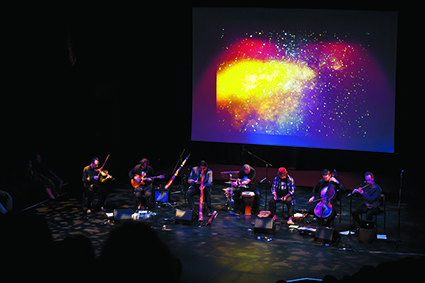
Reflection Tour
photo Holly Jade
Reflection Tour
The TURA-led Reflection Tour brought together two of Australia’s most revered Indigenous musicians, William Barton and Steven Pigram, with a range of instrumentalists from different performance contexts to make up the Narli Ensemble. Travelling to 12 locations around Western Australia’s Kimberley and Pilbara regions, the eclectic ensemble performed concerts and school shows for around three weeks before winding up in Perth for a finale concert. The night was filled with surprises, with music that ranged from traditional and story-led songs to atmospheric and electronic offerings. It’s hard to describe how such different kinds of music fit together so well, but the night felt entirely fluid, as if every musician were telling the same story from their own unique perspective.
Over the course of the concert musicians wandered on and offstage, resulting in an ever-changing ensemble that performed a range from solos and duets to full band works. The night opened with a solo improvisation titled Kimberley Night Sky by didgeridoo virtuoso William Barton. As he plays, it’s hard to take your eyes off him, such is his focus and intensity. He traverses the boundary between traditional and experimental music with ease, mixing stick taps, whistles and abstract sounds with the drones and barks of the didgeridoo sound with which we are more familiar. It’s an effective opening to set the tone for a night which is both meditative and engaging, steeped in tradition but focused on the exploration of new sounds.
Barton is soon joined onstage by Tristan Parr (cello) and Errki Veltheim (violin) for Parr’s own Strati, a piece with quite poetic origins created by manipulating satellite photos of Reflection Tour concert locations to be translated into a graphic score. Each iteration incorporates a live recording of the last, such that the final concert contains audio from every performance on the tour. In a similar vein is Veltheim’s Silence of a Falling Star, delivered by the full ensemble later in the evening. It is a meditative exploration of softly evolving textures, enhanced by radio static and a softly bubbling electronic undercurrent. It would have been quite an experience to have seen this performed outdoors under the stars as intended, as the enclosed space of the Octagon Theatre somewhat dampened the spiritual effect.
As soon as Steven Pigram took to the stage the energy changed from meditative to entertaining. Pigram was engaging in an entirely different way from Barton. While Barton was inwardly focused on his sound, Pigram was friendly and conversational, guiding us through his songs by cracking jokes and telling stories. From Pigram and the full ensemble (now joined by Ron Reeves on percussion and Steven Magnussen on guitar) we heard the foot-tapping “Nothin’ Really Matters,” humorous “Crocodile River” and others.
There were more instrumental offerings along the way. A highlight was Stephen Magnussen’s virtuosic solo guitar piece New Digs. The guitarist traversed the instrument with ease, delivering a flowing and complex array of melody. Then there was the Perflewdj trio of Barton, Tos Mahoney (flute) and Ron Reeves (percussion) who performed a curious and spacious improvisation.
Perhaps the emotional high of the night came when the ensemble was joined for two songs by Stephen ‘Baamba’ Albert, a veteran musician, performer and storyteller from Broome. Baamba has a unique stage presence, peppering his performance with stories from his childhood and beyond. His voice is throaty, aged by a life of singing, adding so much character to the songs. We get “Slomat Tingal,” the trilingual pearl-divers’ song, as well as an unexpected cover of Cole Porter’s “Begin the Beguine.” Before long Baamba retreats offstage, but not before he has met his rapturous applause with a cheeky smile.
The full ensemble ended the program with the catchily rhythmic Kalkadunga Yurdu by Barton and Mimi, a tribute to Pigram’s granny. There was a final all-in, groove-heavy encore of Pigram’s “Saltwater Cowboy” and then the ensemble bade farewell. What a rare opportunity it was to witness the coming together of such an eclectic group of musical minds. I feel incredibly lucky to have experienced such a varied and intimate evening of music making, and given the standing ovation the musicians received I’d say I’m not the only one.
Reflection Tour, Final Concert: William Barton, Stephen Pigram, Stephen Magnussen, Errki Veltheim, Ron Reeves, Tristen Parr, Stephen ‘Baamba’ Albert, Tos Mahoney, Tura New Music, Octagon Theatre, 29 Sept
RealTime issue #130 Dec-Jan 2015 pg. 50
© Alex Turley; for permission to reproduce apply to realtime@realtimearts.net
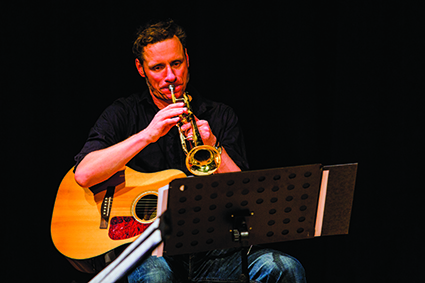
Jochen Gutsch
photo John Frape, copyright Campbelltown Arts Centre
Jochen Gutsch
We hear Bronwyn Cumbo’s amplified violin before we see it. A forlorn melody heralds her entrance from behind a curtain. A second violin voice is soon added as Natalya Bing enters from the other side of the stage. The peripatetic violinists feed off each other, the music an improvisatory conversation until they reach their music stands and settle into a rhythmic ostinato. Jochen Gutsch takes to the stage on electric guitar, his sound dry and percussive. The final member of the quartet, Simeon Johnson, joins on electric cello. Described by Gutsch as “a truly collaborative work that has the handwriting of all four members in it,” the world premiere of Patches and Paths is the result of The Hinterlandt Ensemble’s week-long residency at Campbelltown Arts Centre.
The opening rhythmic figure intensifies before it segues into a more conventionally tonal idea: Gutsch strums a chord progression while the violins trace repeating scalic patterns. Johnson taps on his cello’s frame, sending a deep bass percussion beat through the speakers. This motif becomes an almost pop-style refrain throughout Patches and Paths that the ensemble returns to between more adventurous excursions.
The components of a drum kit are scattered between the players, drums and cymbals used to highlight cadences and climaxes—the suggestion of a drummer without the saturating repetition of a relentless drum beat. Distortion kicks in on electric guitar and cello, Gutsch’s rock background making itself heard. Despite the raw sound, the balance is sensitively controlled and the ensemble maintains the feeling of chamber music’s intimacy.
The music darkens; electronic pedal effects throb. Rhythm and pitch disintegrate and drift. Sweet high notes from Gutch’s guitar add a naivety that is soon undercut by the intensification of the electronic manipulation. Freer episodes such as this intersperse with the rhythmic patterns and chord progressions of rock and pop music. At one point the music shifts completely into an electronic world: synthetic warbles and slides flutter at Gutsch’s fingertips on a console. At other times the tonality is conventional, Gutsch strumming guitar or playing a nostalgic trumpet line over the string trio.
Patches and Paths reaches its conclusion fading into a wash of atmospheric electronica. Players leave the stage one by one, but Gutsch remains at the controls. Memories of earlier melodic material emerge from the fog of sound, but soon decay. Gutsch exits and the ambient noises dissipate into silence.
The first half of the concert comprised two acoustic works by Gutsch, written specifically for Hinterlandt. Alltagswelt (Everyday World) opens with a spiky repeating pattern on guitar. Bing and Cumbo join (staggered entries are a recurring theme) with short measured trills on violins before Johnson initiates a rising figure that passes around the strings. Gutsch alternates between guitar and trumpet; the five-movement work touches on genres including rock, folk and Spanish music, as well as improvisatory passages that wander into the atmospheric—a cloud of siren string glissandos and guitar slides.
Like Alltagswelt, Umgangswelt opens with a rhythmic pattern. Cumbo begins an unsettled heartbeat on xylophone, Bing joining on a second xylophone to fill the off-beats. The title translates less readily into English, but suggests interactions and social frameworks. Though Gutsch describes Alltagswelt and Umgangswelt as “similar in length, structure and aesthetics,” the colour palette of Umgangswelt is expanded: xylophones, glockenspiel, woodblock, bass recorder and bamboo wind chimes augment the regular line-up of violins, cello and Gutsch’s guitar and trumpet. The music meanders through disparate worlds: from layered rhythmic grooves to burlesque circus music.
Gutsch announces the encores as “fun” pieces. The first is “Tiny Ugly World” by psychedelic punk rock band Alice Donut. Gutsch sings and strums acoustic guitar, Cumbo, Bing and Johnson providing back-up vocals. Tom Waits’ “No One Knows I’m Gone” follows. Gutsch plays the vocal line on glockenspiel, an innocent chiming to replace the melancholy lyrics, while the string trio accompanies.
The Hinterlandt Ensemble expands the intimacy of classical chamber music to an eclectic fusion of styles. The long-form works took the audience on journeys through diverse sound worlds, the unconventional line-up of instruments creating unique possibilities and timbres. The wandering narratives could be unsatisfying at times; Patches and Paths in particular felt rather episodic. Fascinating ideas were presented but often passed by before they could be developed or explored in depth. That said, the ensemble’s cohesion and refined musicianship drew the audience in, inviting listeners to immerse themselves in shifting musical landscapes.
Jochen Gutsch & The Hinterlandt Ensemble, residency performance, Campbelltown Arts Centre, Sydney, 2 Oct
RealTime issue #130 Dec-Jan 2015 pg. 52
© Angus McPherson; for permission to reproduce apply to realtime@realtimearts.net
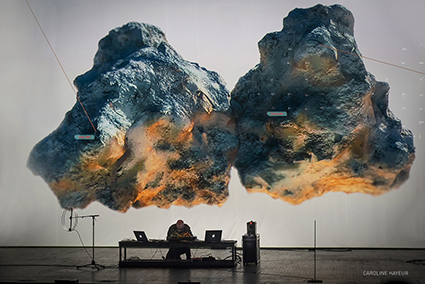
Herman Kolgen, Seismik
photo Caroline Hayeur
Herman Kolgen, Seismik
Despite the emphasis on the aural implied by the festival’s title, Sonica is equally about the visual. When sound meets vision (and vice versa) there is some sort of implied interdependency and with no overt theme to the festival, I found myself looking and listening to the works of the first weekend of Sonica 2015 via the conceptual framework of interrelation—cause and effect—in particular how aesthetic choices either clarified or obfuscated (not always in a bad way) the connection between sound and vision.
Tipping Point
UK artist Kathy Hinde’s Tipping Point, commissioned in 2014 by Cryptic for Sonica, offers a pleasing level of complexity within a cause and effect relationship. In a darkened room 12 tall glass tubes containing water are suspended in counterbalanced pairs and lit from within. A mechanical armature raises one tube above the other syphoning the water between them in gentle seesawing motion. Unseen microphones in the tubes generate pure feedback tones, amplified via speakers at the base of each pair. As the water level changes it affects the resonant frequency of each vessel and the tone glissandos to another pitch.
I experienced the piece in performance mode, where Hinde ‘plays’ the rise and fall of the tubes, augmenting the pure tones with processing via guitar effects pedals. The ‘choral’ result is both visually and aurally mesmerising. While it is clear that what we hear is a direct result of the activity of these tubes, the actual mechanics of the sound generation remains mysterious, the tones essentially drawn from the varying ‘emptiness’ of the vessels. Here the aesthetic choices add a complexity to the cause and effect; we have to interrogate the work to understand the magic.
The New Alps
A 2015 Cryptic for Sonica commission, The New Alps by Robbie Thomson (UK), offers an example of a clear one-to-one ratio action to sound relationship. Housed in an empty swimming pool at the Govanhill Baths, Thomson’s kinetic sculptures are made from heavy industrial materials and produce sharp, angular sounds—all about the attack. One machine drums a spasmodic riff on a sheet of metal culminating in a skull-reverberating gong; another goes through a series of motions to expel a sudden blast of compressed air; another whirls a speaker around at speed, the susurration of static bouncing back at us from the tiled pool walls. The machines seemingly graze on the edge of a rusty puddle of water down at the deep end, occasional water spurts and bubbles softening the clang and rupture. Adrift from any industrial function, Thomson’s melancholy machines are caught in a non-productive cycle of cause and effect—a bleak poetic postscript to our end of days.
Order and After
In the Ladies Bathing Pool at Govanhill Baths is the Sonica-commissioned Order and After by Indonesian artist Jompet Kuswidananto. Working with notions of national identity viewed through the lens of the post-Suharto Reformasi period, this is a poetic interpretation of cause and effect—an extended transitional terrain of political action-reaction-action. Through the haze of artificial fog and blinding spotlights, two large red flags adorned with gold script are suspended over the empty swimming pool. Over the roar of industrial fans, which cause the flags to flutter, we hear a voice singing fragments of song and speaking a collage of verbatim texts from interviews and speeches. Without warning the flags drop to the bottom of the pool, only to be later re-hoisted, the cycle of reformation and nation-building activated again. While simpler than Kuswidananto’s previous army of robotic soldiers, this piece is no less performative and effective for the concentrated metaphoric power expressed most strongly in its visual aspects.
Herman Kolgen
It’s clear from the Sonica 2015 program that Cryptic curator Cathie Boyd’s tastes favour the highly polished, energetic and spectacular—a combination well-realised in the practice of Québécois audiovisual artist Herman Kolgen. In the first of three pieces, LINK.C, Kolgen performs the visuals to Philip Glass’ String Quartet No. 2 played by the Maxwell Quartet (UK). Kolgen’s vertiginous flyovers of 3D-rendered high-rise cityscapes in constant slice-and-dice reconfiguration meet the cyclical propulsion of Glass head-on, creating a dramatic and immersive visual hymn to urbanity.
In AfterShock, Kolgen takes over the sound as well, offering an aestheticised nightmare of a post-apocalyptic world. His non-specified disaster is introduced with jarring bolts of noise probed from his modular synthesiser with what looks to be a screwdriver. Once the world has ended the game-like flyover perspective implicates the viewer, we become collapse-porn voyeurs cruising around the broken artifacts of the Anthropocene, the scene propelled by a soundscape of uneasy roil and rumble. Rendered in smooth-skinned, monochromatic 3D animation, the apocalypse has never looked so good.
In the final and most substantial work, Seismik, Kolgen uses realtime seismic data from around the globe. This is sonified and augmented by his own synthesised rupturings. Placing a microphone in the space he also hopes to make a feedback loop that will shake the building. His visuals have us floating through fault lines, twisting between tectonic plates and soaring over vast and terrifying topographies, all sliced and fractured with his by now familiar spidery data feeds. It’s stunning and awesome in scale but with not quite enough variation or development to sustain its extended duration of 45-50 minutes. Also, given the emphasis on the realtime data feed, the actual presence of this as a clear sonic element and driver of the action is not so evident. Here the aestheticisation of the cause dilutes the effect.
Oscillon Response
Scottish artist Mark Lyken’s Sonica 2015 commission, Oscillon Response, is also a highly aestheticised audiovisual work. Based on six examples of electronic pioneer Ben F Laposky’s Electronic Abstractions—beautiful spectral images created using an oscilloscope—Lyken has created six audiovisual studies. Lyken’s is a sensuous interpretation of Laposky’s images, his music a textured ambient electronica, laced with processed choral vocals that swirl around his animated versions of the oscillator figures. However, given the oscilloscope’s ability to visualise sound as electrical wave a stronger relationship of sound to image was missing with the sound-image interplay appearing merely decorative. Of course Lyken has to find his own way into this material, but it was hard not to compare it with the tightly-sutured dynamism of Robin Fox’s oscillator work, Volta (2006).
Fluorophone
As well as delivering a presentation about the soon-to-be opened Melbourne Electronic Sound Studio (M.E.S.S), which I didn’t catch, Robin Fox was at Sonica for the festival’s opening night performance of Transducer, created with Speak Percussion’s Eugene Ughetti. (See Totally Huge 2013, RT online). Given space constraints I’ll concentrate on the other half of Speak Percussion’s concert, Fluorophone, which explores the relationship of light to sound. The program opens with Damien Ricketson’s Rendition Clinic, inspired by the click of the electrical discharge of strobe lighting. Performers Louise Devenish and Matthias Schack-Arnott undertake small rhythmic studies—the tapping of stones, the spinning of wind wands, the chime of struck metal tubes, underscored by just audible sub-bass tones played from a laptop by Ughetti. All action is illuminated by strobes creating a cool fracturing of image that is somehow softened and unified by the delicacy and subtlety of the sound palette—a clever balance of spectacle and understatement.
Ughetti’s Pyrite Gland also challenges expectations, refusing to deliver any sound that we expect from the featured instruments, three tom-tom drums. The toms house sound-sensitive lights that respond to succinctly scored extra-musical experiments involving air mattress pumps, balloons, water and tensioned strings. The result is a rigorous yet playful study of sonic and visual expectations.
Simon Løeffler’s enigmatically titled piece, e, is the most ambitious in the program, using a triangular sculpture made from fluorescent lights. With foot pedals the performers switch the lights on and off in increasingly complicated sequences. Meanwhile the electrical current running through their bodies issues an underscoring of hums and buzzes. The audible clicks of the pedals sync tightly with the on/off of the lights, while the electrical sounds are harder to parse with the action, the body conduction causing buffering and delays. The final section introduces the metallic clang of a struck triangle nested in the centre of the sculpture, a curious and unexpected sound in the midst of the clicks and buzzes. Løeffler’s work is as sonically challenging as it is visually arresting.
Beyond aesthetics
From the dozen or so events I experienced of the festival’s first weekend, it seems that what makes Sonica unique is its prioritising of the aesthetic—everything just looked so damned good! However I did want some of the works, Kolgen and Lyken for example, to present a more complex intertwining of sound and vision that reaches beyond illustration to a point where each element actually challenges our understanding of the other. But perhaps my concern can be satisfied elsewhere in the realm of media art with festivals that have a more interrogative agenda (sometimes at the expense of aesthetics). But really, I am being greedy, because even only experiencing half of the festival, there’s no denying that Sonica offers a rich and generous banquet of sonovisual delights.
–
Cryptic: Sonica 2015, curator Cathie Boyd, co-curators Patrick Dickie, Graham MacKenzie; Tramway, Centre for Contemporary Arts, Govanhill Baths, Mitchell Theatre and various venues Glasgow; 29 Oct-8 Nov.
Gail’s travel to Sonica was assisted by the Australia Council and Arts NSW, and accommodation was provided in Glasgow by Cryptic.
RealTime issue #130 Dec-Jan 2015 pg. 53
© Gail Priest; for permission to reproduce apply to realtime@realtimearts.net
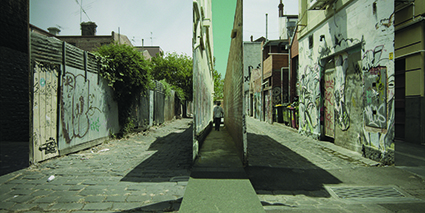
A Garden of Parallel Paths
photo Daniel Crooks
A Garden of Parallel Paths
The first thing you notice about the group exhibition People Like Us at UNSW Galleries is the sound. You enter a foyer through glass doors and immediately hear snippets of violin, the ascending tones of woodwinds and a soaring operatic soprano. Michael Nyman’s The Art of Fugue (2012) is a video work situated outside the main gallery space, and before you see the screen its arcing melodies are resonating around the high ceiling. When you arrive in front of the work, the movement of amateur male photographers and their scantily clad female subjects immediately becomes operatic as Nyman’s composition turns this recorded experience in Mexico City into a kind of choreographed performance.
Like the photographers in Nyman’s piece, who mediate their way of seeing the world through the barrier of the lens, this exhibition is concerned with the interrelationship between art, technology and human experience: how technology facilitates or disrupts our connection to information and the environment. Curator Felicity Fenner gives us a diverse array of contemporary works that seek to challenge the anxiety that technology is isolating, that it is making us withdrawn and disengaged. As the exhibition title infers, what is significant here is the human, our personal relationships not only with technology but with the people around us.
This tension between community and isolation, between switching on and plugging in or tuning out, thematically runs across all the works. Daniel Crooks’ A Garden of Parallel Paths (2012), which splices video of Melbourne laneways into one single moment, each laneway sliding into the next, brings together the virtual and the real. There’s something eerily familiar about all of these paths and, when viewed in a constant scroll, the work becomes like a maze, claustrophobic and compact. It’s oddly jarring when figures pop up in the laneways, seemingly walking beside one another but separate all the same, as a hushed drone plays out over the top. Similarly, there’s an element of intimacy and pathos right alongside separation in Jason Wing’s Syrinx (2015) where you peek round a black curtain to find a solitary empty wooden chair and a pair of headphones and focus your attention on the shrieks of black cockatoos that tell the story of Aboriginal suffering and displacement.
Wing’s work sits next to the whistlers in Angelica Mesiti’s The Calling (2013-14), a three-channel video installation showing three remote communities where this tradition is carried on. While Wing is focused on absence and deletion, Mesiti turns to communal presence. A teacher stands before a class, a common enough occurrence, but here he is communicating entirely through whistling—a call and response with the students. Mesiti takes the time to focus on a particular gesture, a raised hand, a smile and three pieces of women’s clothing on a line, swinging in the breeze. This is finding the transcendental in the everyday moment, a kind of sacredness, and yet she is also questioning how a tradition can fit inside the modern world. Will it change in the face of technological advancement?
In a separate room to the right of Mesiti’s work, the body appears: we are brought back to human limbs, sinew and blood. Yuri Ancarani’s Da Vinci (2012) is not for the queasy with its robotic surgical procedure projected on an entire wall. I like this movement from the transcendental to the physical. It feels as if metaphysical transport must be brought back down to earth and seen among the corporeal. As Ancarani’s title alludes, the work references that old collision between art and science, propelled forward since Da Vinci’s own Renaissance. Seeing surgical procedure close-up brings home an awareness of layers via technology’s capacity to reveal what goes on under the skin and to rupture, cut and repair. The curator’s note accompanying People Like Us suggests an artistic preoccupation with our ‘inner selves’ and indeed Ancarani turns inside, forcing us to acknowledge the pulsating veins and vessels that make up the body.
Grouping such disparate works brings with it the sense of a lack of cohesion, with some of the works sitting uneasily beside others. Su-Mei Tse’s purring cat portraits seem an odd choice right alongside Mesiti’s poetic videos, and George Poonkhin Khut’s interactive Brighthearts app, which monitors breath and heart rate, jars against Nyman’s elegiac Symphony No. 11: Hillsborough Memorial (2014). Then again discord does form a significant part of our relationship with technology and indeed with each other, particularly in our attempts to negotiate excessive amounts of information. If Felicity Fenner is attempting to question how technology impacts on our way of viewing the world, then these moments of dissonance need to be considered.
Sound does provide a form of unification: there are birdcalls and the hiss of a spray can from Joan Ross’ The Claiming of Things (2012), Mesiti’s whistles and Crooks’ subtle bell tones. With a sideways glance to Nyman’s work, you can think of that sonic experience as being like a fugue, a musical composition that relies on contrapuntal motion—the movement of melodies against one another. The word ‘fugue’ stems from the Latin ‘to flee’ and ‘to chase’, and I like the idea that each sound seems to chase after another; with the whistle, the bird cry, the whirring of bicycle pedals, there’s a brief meeting of tones, one emerging as the other subsides, interlocking the works. And when thinking of the exhibition as a whole, and trying to reconcile moments of disparity, the placement of the works can also be likened to the harmonies of a fugue. Because what People Like Us is offering is a similar kind of experience: it is simultaneously an interchange of different ideas, interweaving at some points and crossing over, before falling away.
People Like Us, curator Felicity Fenner, UNSW Galleries, Sydney, 5 Sept–7 Nov
RealTime issue #130 Dec-Jan 2015 pg. 54
© Naomi Riddle; for permission to reproduce apply to realtime@realtimearts.net
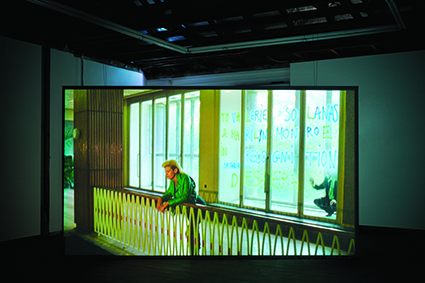
To Valerie Solanas and Marilyn Monroe in Recognition of their Desperation, Pauline Boudry and Renate Lorenz
photo Zan Wimberley
To Valerie Solanas and Marilyn Monroe in Recognition of their Desperation, Pauline Boudry and Renate Lorenz
In the early days of the historical avant-garde, Futurist and Dada manifestos were recited, performed and even shouted by their authors in front of audiences. These announced a violent rupture in the historical continuum by passionately propelling society into a newly imagined future; through radical rhetoric, they aspired to nothing less than changing reality with words. As Galia Yanoshevsky writes in her analysis of the manifesto as a defined genre, “manifestos are violent acts, spectacular acts, a way to sound your voice, whether the act is artistic or political.”
Amy Ireland and Virginia Barratt carry on this tradition of public manifesto recitation in an eccentric performance that is both artistically and politically charged. The performance is presented as part of an exhibition at Woolloomooloo’s Firstdraft gallery curated by Frances Barrett. Entitled Haunting, the exhibition explores artworks that use historical narratives to produce temporal shifts by conflating past, present and future.
In Ireland and Barratt’s performance, it is two feminist manifestos, and two of the women who produced them, that communicate across a 20-year gap. Dressed in white jumpsuits, Ireland and Barratt engage in forwards and backwards recitations of VNS Matrix’s 1995 Cybermanifesto for the 21st Century along with extracts from Laboria Cuboniks’ 2014 manifesto, Xenofeminism: A Politics for Alienation.
VNS Matrix was a cyberfeminist collective of which Barratt was a member. Formed in Adelaide in the early 1990s, it injected a critical feminist discourse into the male-dominated space of the virtual. Alongside Donna Haraway who famously wrote she’d “rather be a cyborg than a goddess,” VNS Matrix, in their condensed and ferociously poetic declaration, announced themselves as “the modern cunt” and “the virus of the new world order.”
By contrast, Cuboniks’ recently published manifesto sprawls over 27 dense paragraphs categorised into seven sections. Amy Ireland is involved with this xenofeminist collective that is spread across five countries and three continents and whose stated mission is to “dismantle gender, destroy ‘the family’ and do away with nature as a guarantor for inegalitarian political positions.” Centred on trans-politics, the manifesto seeks to create “a feminism at age with computation” by calling on technology to be repurposed for progressive gender political ends.
It is a strange and potent experience to encounter these two feminisms, past and present, in dialogue. The performance space, meanwhile, evokes the uncertain space of a radical technological future, with a neon green X marked on the floor across which the women slowly travel, each on her own axis, alternately facing toward and away from us. At one point, three small remote-controlled flying toys are unleashed into the space, loudly buzzing and crashing into the walls but providing an unfortunate distraction from the power of the spoken words.
Cuboniks’ manifesto is readily accessible online but has been printed on paper for the occasion of Haunting. It reads as not so much haunted but rather inspired and impelled by the cyberfeminisms that preceded it. Yet while it echoes the urgency of past feminist manifestos, the text does not shy away from interrogating their limitations and failures, boldly reimagining the untapped political potential of technology for a contemporary era.
Alongside the printed text, the exhibition features two video works, Pauline Boudry and Renate Lorenz’s To Valerie Solanas and Marilyn Monroe in Recognition of their Desperation (2013), and Geo Wyeth’s Quartered (2013-2014). In Boudry and Lorenz’s film, six artists perform a 1970 score composed by Pauline Oliveros and inspired by Valerie Solanas’ radical feminist “SCUM Manifesto.” The score tasks the performers to make autonomous musical choices and respond to the dynamics of the group by rejecting the hierarchical structures of traditional compositions. With the camera panning the performers who each play different instruments, the piece feels like an anarchic rock concert with no centre. The converging noises progressively take on a life of their own as the performers don’t just play but also listen to one another, becoming their own audience.
Quartered follows performance artist Geo Wyeth’s journey to the deep American South, tracing the history of an old relative. Wyeth’s identity as a biracial transgender man is explored in a dreamlike reverie, juxtaposed with jarring DIY-style editing that prevents us from getting too comfortable. Memory and history are revealed to be both real and imagined as Wyeth’s personal and family histories, national historical traumas and Southern mythology intersect in an original feat of evocative storytelling.
The works that make up Haunting are tied together by their interrogation of the past and fearless imaginings of the future. Joining these politically inspired artists and activists is an unexpectedly empowering journey.
Haunting, curator Frances Barrett, Firstdraft, Sydney, 2-25 Sept
RealTime issue #130 Dec-Jan 2015 pg. 55
© Ilana Cohn; for permission to reproduce apply to realtime@realtimearts.net
Email us at giveaways [at] realtimearts.net with your name, postal address and phone number. Include ‘Giveaway’ and the name of the item in the subject line.
Please note you can nominate for ONLY ONE GIVEAWAY.
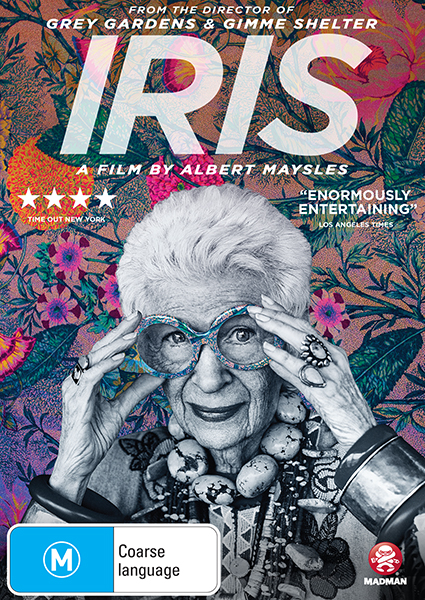
Iris
One of the last works of the late, great film documentarian Albert Maysles. A verité portrait of equally famous New York “fashion icon” Iris Apfels.
3 copies courtesy Madman Entertainment
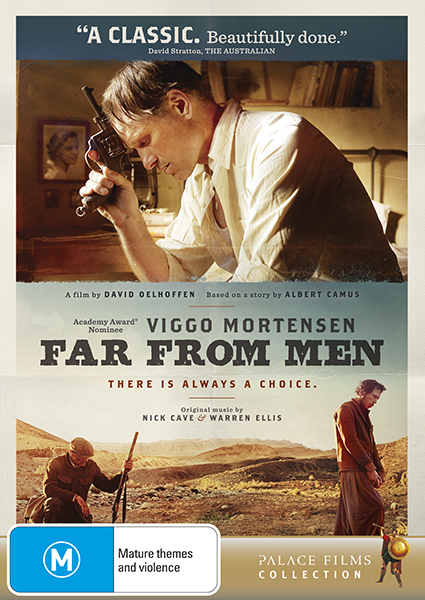
Far from Men
One of this year’s best films from director David Oelhoffen based on a story by Albert Camus. Set in 1950s Algeria, the film features a striking performance from Viggo Mortensen as a schoolteacher faced with a perilous challenge.
3 DVDs courtesy Madman Entertainment
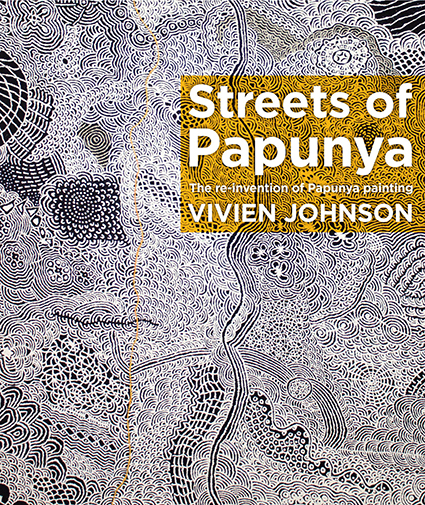
The Streets of Papunya: The re-invention of Papunya painting
Another handsome volume from NewSouth Publishing, this of time Vivien Johnson’s wonderful celebration or the remarkable art of the women painters of Papunya.
1 copy courtesy NewSouth Publishing
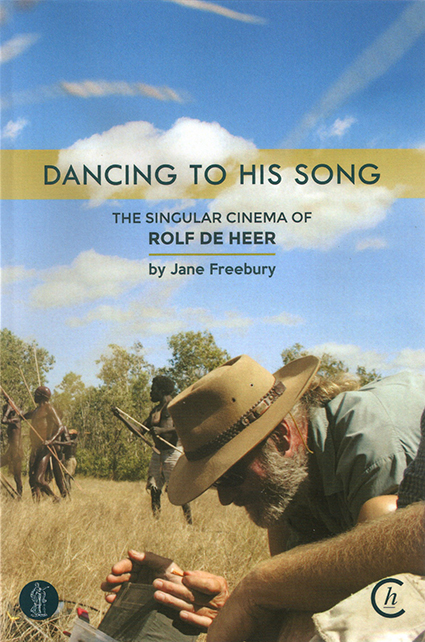
Book: Dancing to His Song: The Singular Cinema of Rolf de Heer
By film scholar Jane Freebury, this is part critical essay, part filmography and part study of the critical and audience response to the work of a truly radical Australian filmmaker.
2 copies of paperback and 2 e-books courtesy Currency House and Currency Press
RealTime issue #130 Dec-Jan 2015 pg. 56
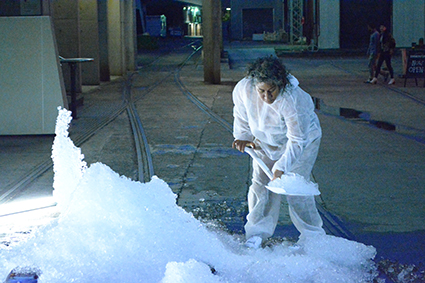
Latai Taumoepeau, Repatriate II
photo Sanja Simic
Latai Taumoepeau, Repatriate II
How long does it take to transport ice? A time that depends on temperature as much as distance. Before electricity, ice in our part of the world was brought on big ships from continents whose climate made ice naturally. Buying an ice cream in Bondi as recently as 1915 meant dependence on this long voyage.
One hundred years later, ice is locally manufactured in refrigerators, powered by fossil fuels whose emissions help melt the northern icecaps. A 500 kilo pile of this ice dumped before the entrance of Carriageworks signals the beginning of punake [Tongan performer] Latai Taumoepeau’s Repatriate II.
The artist is dressed in a disposable body suit. She shovels up ice, carries it 20 metres then dumps it on the ground near a drain. It is a futile task, the second pile melting as it grows. Her labour contrasts with the audience idling by the bar, lulled perhaps by the repetition and stark beauty of the performance, until the abrasion of metal on concrete when Taumoepeau returns to the first pile, dragging the shovel behind her. Her pace is meditative, each gesture deliberate, the endless to-and-fro modulated by slight variations in carriage.
Repatriate II is a three-hour performance, as measured by the presence of the artist. The ice would have endured longer in the nocturnal iteration that I saw, than the diurnal one the following day, conducted before the busy commerce of Eveleigh markets that take over this forecourt on Saturdays.
Taumoepeau, Sydney (Eora) by birth and Tongan by ancestry, has been making works that address climate change in the Pacific for some years now. They become stronger and more refined with time. Repatriate I, which opened Liveworks, saw the artist seated in a high tank. Dressed in a black bikini and yellow floaties, she performed dances of her Pacific Island heritage as water gradually filled the tank. The vocabulary of the dance while unknown to this white viewer, resonated with myriad celebratory welcomes seen danced by Pacific Islanders.
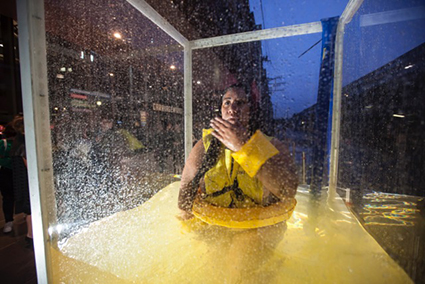
Latai Taumoepeau, Repatriate I
photo Alex Davies
Latai Taumoepeau, Repatriate I
Repatriate I was more of a plangent goodbye, the dance initially limited to hand gestures when the artist was seated. Slowly, Taumoepeau began to float, valiantly continuing her dance. Upright, as the tank filled, the movements of her lower body were restrained by water. Night fell, the rain came, and we huddled under the eaves feeling her cold.
Insistent, thwarted, struggling, the dance continued til the bitter end. A long black wig added a note of absurdity. Yet there is nothing light-hearted about this work. Its seriousness of intent is refreshing and necessary in a cultural context often characterised by insincerity. An earlier performance in Sea Suite saw Taumoepeau stack ice into cardboard boxes, walling herself into a niche in a laneway behind a bar. It was the opening night of Sydney Contemporary, and a dozen or so artists were performing in the streets around the venue. Taumoepeau was the only one with gravitas. She has something urgent to say, these works so compelling and universal they could happen anywhere: Finland, London, Singapore, Chile, galleries, theatres, streets, bank foyers, shopping malls, parliaments.
–
Performance Space, Liveworks Festival of Experimental Art, Repatriate I and II from The Stitching (Up) The Sea Suite, artist Latai Taumoepeau; Carriageworks, Sydney, 22-24 Oct
RealTime issue #130 Dec-Jan 2015 pg. 17
© Fiona McGregor; for permission to reproduce apply to realtime@realtimearts.net
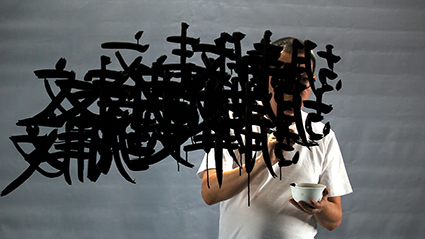
Writing in the Rain, FX Harsono
photo courtesy OzAsia Festival 2015
Writing in the Rain, FX Harsono
No, we’re not ailing. It just so happened that our choice of cover image of a performer in an MRI machine coincided with our decision to go totally online. It’s a scene from the great Italian artist Romeo Castellucci’s Go Down, Moses, which features in the 2016 Adelaide Festival.
The image by Indonesian FX Harsono on the opposite page feels more apt. Chris Reid, in his review of the visual arts program of the OzAsia Festival writes, “In his video Writing in the Rain (2011) we view [Harsono] through a sheet of glass repeatedly writing his name in Chinese over the same spot on the glass. Water, representing rain, then begins to wash the ink down the glass.” Although Harsono is reflecting on the fragility of identity under dictatorial power, the image resonated with us. Magazines are ephemeral. With each edition we wrote our names, and again in the next and the next as previous editions became like ghosts. But the hard copies were there and archived in several libraries. Paper ages and ink dries, but with likely longer staying power than the word online which is vulnerable to crashes, hacking, solar flares and the endless redundancy of platforms that defeat archivists. But that’s where RealTime is going, online, in good faith.
We’ve been printing and distributing 20,000 copies every two months to 750 locations across Australia for 20 years, delivering online and holding out well against the incursions of internet publishing. But we’ve had to face market pressures, distribution challenges, the high combined costs of print, freight, distribution and mail and the burden of a large carbon footprint (though the toys, devices and power consumption of the digital world are not much less problematic).
Our vision of free access, highly responsive and constructive reviewing and a focus on innovation and experimentation across the arts remains intact. And the internet will allow us to do the kind of things which we can’t in print: dialogue directly with you, stream live from festivals, host forums, commission and curate online works and link you to great sites and events around the world that foster experimental art.
We know many of you will sorely miss the look, feel and leisureliness of the print editions, so will we, but our weekly e-ditions (growing to twice weekly) will, without undue pressure, keep you happily in an expansive arts loop. We hope you’ll come with us from page to screen, whether on your computer, phone or tablet.
We wish you a very happy holiday season, thank you for being a loyal print reader and look forward to being digitally-conjoined in 2016.
Keith & Virginia & the RealTime Team
RealTime issue #130 Dec-Jan 2015 pg. 3
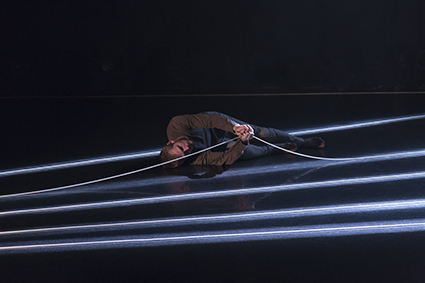
Alisdair MacIndoe, Spectra, Dancenorth/Batik
photo Ashley Mclellan, OzAsia Festival 2015
Alisdair MacIndoe, Spectra, Dancenorth/Batik
Joseph Mitchell’s first festival was highly anticipated, promising a reinvigoration of OzAsia through an emphasis on cross-genre work by a younger generation of artists with thematically and stylistically diverse and fluid practices. Indonesia was the geographical focus of this year’s Festival but, aside from Eko Supriyanto’s enthralling take on North Maluku tribal dance, Cry Jailolo, it was the program’s Japanese cohort that most embodied this recalibration. The acknowledgment of global trends such as the resurgence of body-based performance art and relational and immersive practice represented a welcome shift of focus from the visually lavish though formally and politically conservative works that have dominated previous festival programs. I detected instead, in works conceived within highly specific local contexts but rigorously engaged with contemporary global politics, a new and stimulating internationalism.
The Streets
The immersive dance-theatre work The Streets situates its audience members as citizens passing through a crowded street in one of Indonesia’s big cities—Jakarta, say, or Yogyakarta, the university town where director Yudi Ahmad Tajudin’s Teater Garasi was formed while Suharto was still in power. Beer and soft drink are offered to us on arrival, our nervous occupation of the mostly empty space temporarily eased. The presence of a roving street preacher and karaoke singer, however, projecting their respective fealties with the aid of homemade amplification devices, returns us to a state of vague unease. The work builds incrementally around us, a streetlight erected by two boiler-suited road workers here, a marching band who look like they are on their way to somewhere else there. As our awareness of this contested space develops, sights that provoke discomfort and incomprehension come into clearer focus—prostrate bodies coiled tightly in rough-hewn sleeping bags, vivid street art spliced with tattered political posters. I spot the anarchist circle-A symbol and some graffiti in Indonesian I translate later as “Mulu work like the witless buffalo.”
Eventually an official instructs the scattered audience to divide into two groups—the performance’s first, but not last, imposition of order on a chaotic situation—the members of each group settling, traverse style, on either the floor or one of the provided cushions. Wooden panels, like those used to board up vacant houses, are placed in front of us, obscuring our view of the performers. We’re informed we can move to a better vantage point if we can find one but most of us don’t, comfortable I suspect with the idea that an unobstructed view of the street would lack verisimilitude. By this stage a live band has asserted its presence, its carnivalesque, hard rock-infused improvisations a suitably ad hoc accompaniment to the bustling though tightly choreographed mosaic of street life that follows.
Indonesia’s class system is vividly dissected in overlapping vignettes that also expose the country’s richly complex interplay of local and global, its context the decentralisation of political and economic power brought about by reformasi. At various points the bodies in sleeping bags—Indonesia’s legion homeless—rise up to claim their share of the space, jostling with cops, hookers, cashed-up tourists and puffed-up bureaucrats. We hear a monologue about a soybean cake seller who suicides when the global price of soybeans surges, and a recording of a Suharto oration—disturbing reminders of the unstable present and the omnipresent past. As supple dancers sometimes violently intertwine their bodies with sheets of corrugated metal that are also used to construct temporary shanties, a voiceover intones, “What is order, what is chaos?” Both states are problematised in The Streets, making the work possible to read as a celebration of post-New Order Indonesia’s democratised vibrancy and an anxious meditation on the social disharmony produced by conflicting political, economic and religious interests.
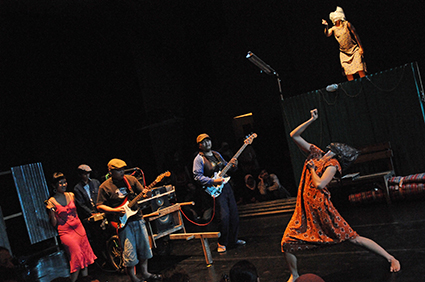
The Streets, Teater Garasi
photo courtesy OzAsia Festival 2015
The Streets, Teater Garasi
Superposition
Quantum mechanics explains the physical behaviour of matter and energy at the molecular, atomic and sub-atomic levels. Its language, in contrast to classical information’s bit (0 or 1), is qubit—0 and 1 in a superposition of both states at the same time. Bit is digital and discrete, qubit analog and continuous. It is these binaries, minute and intersecting, that Japanese composer and visual artist Ryoji Ikeda amplifies visually and sonically in Superposition. It’s a large-scale installation that combines high-contrast, high-resolution graphic renderings of data with an electronic soundscape and live performance that, ultimately, is submerged by the work’s furious display of light and sound. It begins temperately enough, a series of downstage screens lighting up in quick succession to a soundtrack of iPhone-like bleeps. This movement of light, soon overlaid with cascading, indecipherable data, adds up to a remarkable visual choreography, flawlessly synchronised between screens—there are two rows of 10 screens, plus a single floor-to-ceiling screen at the back of the theatre—and with a soundscape that, in its forays into uncomfortably low and high frequencies and sheer volume, made me reach several times for the earplugs audience members are given before entering the auditorium.
Singularly in Ikeda’s body of installation-based work, Superposition is deepened by the presence of two performers (Stéphane Garin and Amélie Grould) who sit at an overlong table. The relationship of their actions—tapping out Morse code, poring over old punched cards and crossword-like puzzles—to the ‘datamatics’ (Ikeda’s word for his visual representations of normally imperceptible data) is often obscure. But it also yields memorable synchronicities such as when Garin and Grould strike a series of tuning forks and the resulting sounds are visualised in real time as sine waves. The phrase “information is not knowledge” takes its place within the ever-accruing streams of data and this, I think, points to Superposition’s formal and thematic resonances. The bombardment of information is overwhelming, vexingly impenetrable in the absence of a discernible framework of meaning. There is a certain satisfaction to this on a conceptual level, and also, undoubtedly, in the work as a feat of digital programming, but its transference from art space to theatre is problematic. In this setting, I found the presence of the two performers strangely dispiriting, their seeming lack of energy and agency emphasised not only by the work’s sterility but also by its unsuitability for the proscenium stage. (See Lauren Carroll Harris’ response to the Carriageworks’ showing on page 29.)
Spectra
Meanwhile, Dancenorth and Japanese Butoh collective Batik’s fusion of contemporary dance, live music and digital sculpture Spectra underscored the rich potential of emergent cross-cultural performance. Its conceptual source is Buddhist philosophy rather than quantum physics—the notion of dependent origination, one term among many for the endless succession of causes and conditions that precedes all things. The choreography, by Dancenorth’s recently appointed Artistic Director Kyle Page in collaboration with Amber Haines, Alisdair Macindoe, Japanese-Australian Josh Mu and Japanese performers Mamiko Oe and Rie Teranishi, extends this idea, in itself a basic choreographic principle, into an intense embodiment of causality’s chain-like nature.
The work opens with a single performer, Macindoe, warmly and intimately lit in a beautiful design by Niklas Pajanti. He opens his body to the space slowly, a speck of cosmic matter—or, perhaps, a life form in infancy—feeling for the first time its connection to energies outside itself, its closed loop of origination. His arm, seemingly animated by an external force, undulates robotically and the action, equal and opposite, is repeated on the other side of his body. The presence of other bodies in the space allows the broadening of this principle of movement without compromising its simplicity, the dancers propelling, obstructing and interlocking with one another in largely unbroken sequence. The work is fired by an improvisatory energy and freighted with sensual, carnal gestures of bodily consumption and emission drawn from Butoh’s viscerally expressive language: orgiastic eating, violent seizures and the exchange of air between the mouths of the dancers. The simple manipulation of ropes, thrown into sine wave-like ripples by the dancers, is a further, elegant rendering of the concept.
The eclectic Japanese composer Jiro Matsumoto contributes an atmospheric live score, his bluesy, sustain-heavy guitar playing and largely indistinct vocals supplemented with the use of effects pedals and looping. Tatsuo Miyajima’s set—dozens of white and red LED timers suspended at various points and heights around the stage—sits above the work in both a literal and figurative sense. However handsome, this extension of Miyajima’s longtime practice as an installation artist feels like an imposition on, rather than a complement to, the compelling display of physical and cultural collision taking place beneath it.
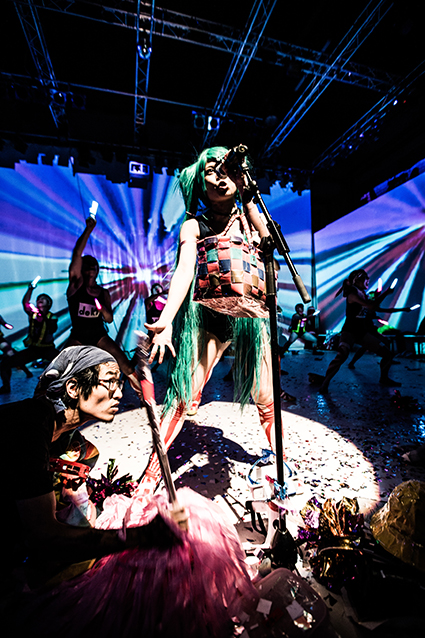
Miss Universal Idol Berserker
photo Claude Raschella, OzAsia Festival 2015
Miss Universal Idol Berserker
Miss Revolutionary Idol Berserker
We’re asked, as we wait to be shown into the performance space, to remove our shoes and socks and place them in a plastic bag. A transparent rain poncho is then handed to us with the warning that we’re likely to get wet during the show. Water isn’t the half of it. Minutes into Miss Revolutionary Idol Berserker, the air is filled with not only the contents of dozens of buckets of water but also seaweed, tofu and any number of discarded props and items of costume. Half-way into the show, the floor is inches deep in water and cheap shop ephemera: glow sticks, tickertape, confetti, toy swords and helmets, placards, wigs and plastic bags.
Miss Revolutionary Idol Berserker is a spectacle of self-eviscerating excess, the detritus its necessary corollary—the flipside of an increasingly attention deficient and evermore disposable popular culture writ large. Directed and choreographed by Toco Nikaido—who sits on a ladder at the back of the auditorium throughout the show, taking, we’re told during a long preamble, “thousands of notes”—the show flaunts a bewildering array of influences, from Japanese game shows and otaku (geek) culture to manga, idol TV, alternative theatre aesthetics and even, if I’m not mistaken, Shinto ritualism. Its costume design is equally eclectic, drawing on cosplay and flamboyant Japanese subcultural fashions like Lolita and kawaii. In its kitschiness and high energy, soundtracked by booming J-pop and techno, it plays like a relentlessly peppy high school eisteddfod, one song and dance routine following another at breakneck speed. Wall-to-wall projections flit like test patterns from one lurid mélange of colour to another as the performers strut and leer in engaging but never intimidating proximity to the audience. We’re handed props and signs to hold throughout the show and invited at its finale to exchange places with the performers, our gaze inverted as we, now the idols ourselves, are swallowed up by reality TV’s irresistible contract. But, of course, it’s only for a Warholian moment, the performers already ushering us out, the floor awash with tomorrow’s landfill. “Who,” asked Neil Postman in Amusing Ourselves to Death, “is prepared to take arms against a sea of amusements?” Who indeed?
–
2015 OzAsia Festival: Teater Garasi, The Streets, director Yudi Ahmad Tajudin, Space Theatre, 24-26 Sept; Superposition, concept, direction, music Ryoji Ikeda, Dunstan Playhouse, 29-30 Sept; Dancenorth/Batik, Spectra, concept Kyle Page, direction Kyle Page, Amber Haines, Space Theatre, 29 Sept-1 Oct; Miss Revolutionary Idol Berserker, direction and choreography Toco Nikaido, Dunstan Playhouse Rehearsal Room, Adelaide Festival Centre, 30 Sept-3 Oct.
RealTime issue #130 Dec-Jan 2015 pg. 4-5
© Ben Brooker; for permission to reproduce apply to realtime@realtimearts.net
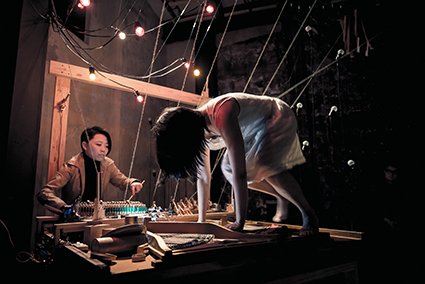
Dear John, M.O.V.E Theatre
photo courtesy OzAsia Festival 2015
Dear John, M.O.V.E Theatre
This year’s OzAsia Festival music program included two highly innovative and absorbing musical performances: Taiwan’s M.O.V.E. Theatre produced a homage to John Cage that involved dance, light displays, technological gadgetry and audience participation as well as sound, and the Australian Art Orchestra combined with musicians and performers from Sichuan to create a unique and hypnotic musical form.
M.O.V.E Theatre, Dear John
Ten minutes before M.O.V.E. Theatre’s performance commences, we’re let into Nexus Cabaret to find a darkened room with many curious spotlit objects spread around the empty space. The only sound is of water dripping from an electronically controlled container hanging beneath the ceiling, into a beaker on a wooden crate, a meditative sound that heightens our awareness. More crates are scattered around the room and dozens of tiny coloured lights glow in the dark. What really catches the imagination is the guts of a dismantled piano, mounted in a timber frame with lengths of twine attached to the hammers and extending across the room where they are stitched to a jacket hanging mid-air. There are suspended metal and bamboo wind chimes with dangling strings; as we wander around the space we brush against them, accidentally making sounds. On stage, more wooden crates form a bench covered with what looks like science-lab apparatus.
The performance commences when a dancer puts on the hanging jacket and activates the piano hammers by dancing. This is prepared piano modified to an extreme level, not just with Cagean screws and bits of rubber—the piano is completely re-imagined. The dancer and a percussionist then compete at the piano, the percussionist playing the strings and the wooden frame with mallets while the dancer simultaneously scrapes objects over the piano strings and even throws herself onto the strings to dampen the sound. The audience crowds around this spectacle as they might at a cock-fight.
As the performance unfolds, the dancer moves from apparatus to apparatus, drawing the audience with her. At an array of light bulbs, she invites a child audience member to join her in rapidly switching the lights on and off, creating a spontaneous dance of light. In another corner she dances on a platform inside a cube outlined by beams of light. The sound of a mechanically rotated rain-stick is occasionally heard, lights flash and electronic and acoustic sounds emanate from around the room without warning. The percussionist uses mallets to play the resonant metal staircase at the rear of the space, using the architecture as instrument. The dancer performs with a lit bulb and then plays a tiny concertina taken from another crate. Dear John playfully explores the intersection of sound, movement, light, technology and audience, and the meditative sound of dripping water closes the performance.
Afterwards, there’s a Q&A session with the director, performers and audience discussing the work’s concept in depth. There can be no better homage to Cage than to extend his experimental approach. After the Q&A, we’re invited to play with the equipment ourselves, breaking down the final barrier between performer and audience and encouraging our own experimentation.
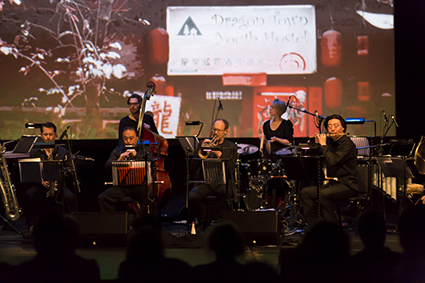
Water Pushes Sand
photo Claude Raschella, OzAsia Festival 2015
Water Pushes Sand
Australian Art Orchestra, Water Pushes Sand
The Australian Art Orchestra’s concert opens dramatically as two percussionists on stage play gongs heralding a procession of the wind players and an actor entering from the rear of the auditorium. Fusing jazz with traditional Chinese musical forms and instrumentation, the ensemble is led by pianist and composer Erik Griswold, who arranged the 10 pieces, and comprises five AAO performers on piano, percussion, trumpet, saxes and contrabass, four Sichuan musicians playing gongs, the double-reed suona, the banhu, bamboo flutes and the gu zheng, and charismatic actor-vocalist Zheng Sheng Li.
The music is characterised by driving jazz rhythms, but the sensibility is imbued with traditional Chinese flavours by the instrumentation and the melodic lines based on traditional songs using the pentatonic scale. The bamboo flute makes a perfect jazz instrument and even the suona, with its high-pitched, reedy sound, blends into the ensemble. In one piece, the sax player and the suona player face off in a musical duel that reaches a thrilling climax. In the final work, entitled Changing Faces, Zheng Sheng Li in costume virtuosically performs bian lian, the magically quick changing of masks worn by actors in traditional Sichuan opera.
While the artists perform, there are videos of street scenes in Chengdu. In introducing the pieces, Griswold tells stories of the city, including that of a 300-year-old laneway that is being redeveloped. The final video is of the beautiful Anshun Bridge that crosses the Jin River in Chengdu. The concert ends as it began, the performers departing in a noisy, clanging procession.
Griswold and percussionist Vanessa Tomlinson’s regular visits to Sichuan have resulted in a highly appealing musical form. The performers revel in taking their music in new directions. The performance would work well in cabaret or a club—the traditional concert format seems too formal for such compelling music. As well as being accessible and fun, the form enlivens both cultures. Griswold speaks of the blurring lines between Chinese and Australian culture, and the music typifies this burgeoning hybridity.
These concerts exemplify the OzAsia Festival, which has grown in scale, complexity, interest and reach over recent years and whose influence is building cultural recognition and respect.
2015 OzAsia Festival Music Program: M.O.V.E. Theatre, Dear John, Nexus Cabaret, 2 Oct; Australian Art Orchestra, Water Pushes Sand, Space Theatre, Adelaide Festival Centre, 3 Oct
RealTime issue #130 Dec-Jan 2015 pg. 6
© Chris Reid; for permission to reproduce apply to realtime@realtimearts.net
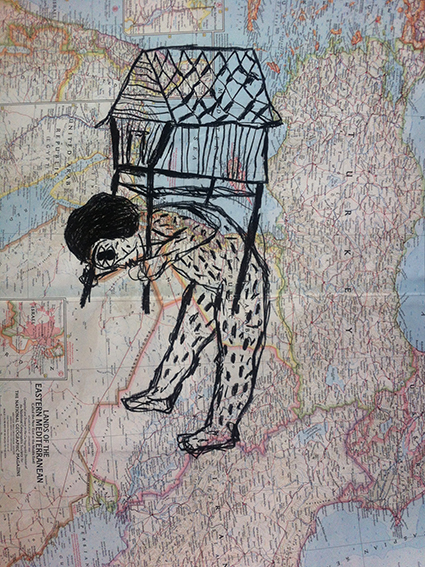
Jumaadi, Landscape of Longing
courtesy OzAsia Festival
Jumaadi, Landscape of Longing
This year’s OzAsia visual art program foregrounded Indonesian contemporary art, focusing on the reflexive re-invention of the individual in a rapidly evolving world as evident in the works of eminent Indonesian artists FX Harsono, MES56, Eko Nugroho and Jumaadi who all reconsider cultural and national histories. The program also includes the Shedding Light exhibition of artwork by South Australian and Indonesian artists with disabilities, demonstrating the capacity of art to provide a voice for all members of the community.
FX Harsono
FX Harsono’s exhibition Beyond Identity focuses particularly on the events of the 1947-1949 killing of people of Chinese descent in parts of Indonesia and on discrimination against minority groups and the consequent loss of personal and cultural identity. The exhibition comprises a video and a set of five rubbings in vivid red pastel on long sheets of cloth. The rubbings, entitled Pilgrimage to History, were made from the tombstones at mass graves and show the names, in Chinese, of those interred. Harsono is researching the history of Chinese Indonesians, the Tionghoa, to produce a documentary and is looking for other mass graves. He learned of the massacre of Chinese Indonesians through photos taken by his father who had excavated and reburied bodies of the victims.
Harsono is Indonesian but also identifies himself as Chinese and Catholic. In his video Writing in the Rain (2011) (see p.2) we view him through a sheet of glass repeatedly writing his name in Chinese over the same spot on the glass. Water, representing rain, then begins to wash the ink down the glass. The artist writes using a calligraphy brush, symbolically representing a tradition that is itself washed away. A 1967 Indonesian law required Chinese people wanting citizenship to change their names to Indonesian. The name he writes on glass is his in Chinese, unused since 1967. As he writes, the ink slowly masks his face from our view. Then the water washes the ink away to reveal him, suggesting a process of personal reinvention. Today, art such as Harsono’s is no longer censored, but he notes that Chinese Indonesians were again attacked in the upheavals of 1998 that culminated in the resignation of President Suharto.
Eko Nugroho
Prolific cultural commentator Eko Nugroho’s Mooi Anomaly welcomes visitors to the Art Gallery of SA with five gigantic lanterns hung between the neo-classical columns of the entrance, creating a suggestive juxtaposition. The work’s ironic title recalls the colonial concept of Mooi Indi or beautiful Indies. The oversized lanterns are decorated with cartoon images of strange composite beings instead of traditional lantern imagery, as if grotesque, hybrid cultures have supplanted colonial and traditional culture.
MES56
The artist collective MES56’s evocative exhibition Alhamdulillah, We Made It, examines the universal and highly topical theme of displacement through the plight of refugees in transit. Established in the late 1990s, MES56’s experimental photography, which they pioneered in Indonesia, predates the Reformasi period that followed the end of the Suharto regime. This body of work at the Adelaide Festival Centre was inspired by their visit to the Yogyakarta Refugee Centre. The photos show the kinds of ideal locations to which the refugees wish to go, but the images are manipulated to show the refugees as silhouettes, as if they have been excluded or erased from the site. The captions provide just the names and origins of the refugees, and they thus remain distant and impersonal to us. But we can visualise ourselves in their place as we already dwell in their destinations.
Jumaadi
Australia-based Indonesian artist Jumaadi makes paintings and sculptures and also videos of his shadow puppetry performances, examining, blending and reinventing Indonesian traditions and contemporary globalised art forms. His exhibition Landscape of Longing includes his Beehive Mountain, a series of large regional maps on which he has sketched images of people undertaking journeys as if they are mapping themselves onto the world. He states his map series is about travel and mobility, and in his sculpture and paintings he frequently depicts individuals carrying heavy loads or on a journey. The struggle of these individuals seems to be a metaphor for the reflexive process of responding to one’s location. The original maps represent the colonisation, control and ownership of territory and its inhabitants, and his appropriation can be read as the reappropriation or re-inscription of that region.
Jumaadi’s captivating video Give Me Back My Body and I Will Return Your Soul shows in split-screen format a shadow puppet play devised and performed by the artist with vocalists and musicians, and simultaneously shows the performers at work. The play opens dramatically with the portentous tolling of a gong accompanying imagery of headless corpses in a field. The story is of epic proportions—the dead are carried away; a monster arrives to devour a body; a heroic figure arrives and is angry at the devastation; a woman gives birth. The plot suggests the inevitable cycle of life and death, birth and destruction. Finally, the text references prophets and biblical figures — Adam, Noah, Abraham, Mohammed, Jesus, Jonah. The world is ultimately described as undifferentiated mud, a reference to the 2006 Lapindo mud disaster, which occurred in Jumaadi’s hometown, implying that our cultural and philosophical traditions are impotent in the face of environmental disaster.
Jumaadi’s bronze, figurative sculptures are collectively entitled 14 Stations. The title references the Crucifixion, but instead of carrying crosses, the figures bear emblematic objects such as a boat or an elephant. One bears his own amputated leg, as if defying any attempt to stop his journey. Another carries a refrigerator, referencing the looting that accompanied the 1998 Indonesian riots.
Jumaadi’s Strange Fruit paintings, on shaped sheets of cardboard sourced from fruit cartons, appear abstract but are symbolic, as dots or the outlines of heads in a crowd. Because Belgium was a colonial power, the artist uses cardboard instead of Belgian linen, suggesting the displacement or rejection of colonisation. The work’s caption states that Strange Fruit refers to the fig trees at Middle Head, Sydney, a species also found in Indonesia that is significant in Javanese cosmology, while the title quotes the song made famous by Billie Holiday about lynchings of Afro-Americans in the US South. All these ideas, Jumaadi says, coalesced in his mind and his art is an aggregation of disparate themes. By thus demonstrating his own thought processes, he shows how cultural identity is formed, disrupted and realigned through relocation.
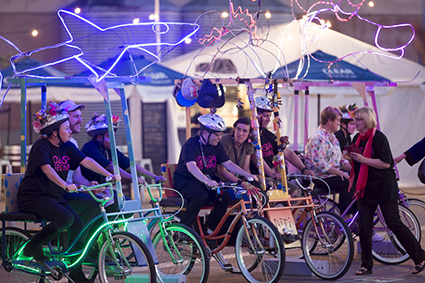
Shedding Light, Tutti Arts/Perspektif
photo courtesy OzAsia Festival 2015
Shedding Light, Tutti Arts/Perspektif
Shedding Light
Adelaide’s Tutti Arts, which provides opportunities for people with intellectual and learning disabilities to make art and develop an artistic practice, worked with their counterpart organisation in Indonesia, Perspektif, to produce an enchanting exhibition of work by artists with disabilities from both countries entitled Shedding Light. The collaboration provided the artists with mutual support and the opportunity to travel, and their work ranged across themes from popular culture including images of characters from fairy tales to observations from their travels such as exquisite drawings of shadow puppets and paintings of mobile food stalls. Their paintings and drawings are characterised by vivid colour and imaginative illustration, as each records their insights into their own and each others’ lives and cultures. The Perspektif artists included a series of small canvases covered with buttons or painted dots, delightfully balancing colour, form and materials. Each artist has developed a distinctive visual language, and their art is not only an essential form of self-expression, it establishes a unique and perceptive approach to visual culture.
Central to the exhibition is a video documentary, the Story Behind Shedding Light, in which Adelaide artist James Kurtze discusses his work and the genesis of the collaborative exhibition. A mobile stall in the gallery was filled with artworks for sale and there were performances and pop-up installations around the Adelaide Festival Centre.
Shedding Light draws attention to people who are often invisible or suffer discrimination and who are reinventing themselves through their art. Crucially, the artists are no longer identified as outsiders or by their disabilities but as artists. The inclusion of this work in the visual arts program embodies the mutual cooperation that is the raison d’être of OzAsia, and provides a foundation for future collaboration.
2015 OzAsia Festival Visual Arts Program: FX Harsono, Nexus Arts; Eko Nugroho, Art Gallery of South Australia; MES56, Artspace, Adelaide Festival Centre; Jumaadi and Shedding Light, Kerry Packer Civic Gallery, University of South Australia; Adelaide, 24 Sept-4 Oct
RealTime issue #130 Dec-Jan 2015 pg. 8-9
© Chris Reid; for permission to reproduce apply to realtime@realtimearts.net
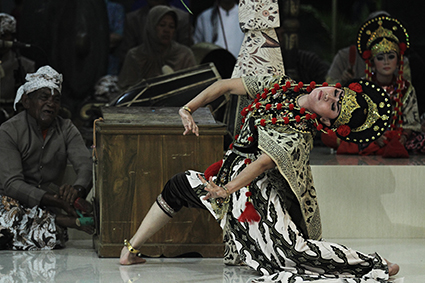
Nani Losari, Topeng Cirebon
photo courtesy Ozasia
Nani Losari, Topeng Cirebon
From the darkened space comes a rhythmic stamping, steady and implacable. Slowly, from the black, an eerie white spectre appears, then legs in loose red pants illuminated by a tight spotlight. We see a man, feet pounding, down on the ball of his right foot, then the heel of his left.
Cry Jailolo
In many ways Cry Jailolo, from Indonesian choreographer Eko Supriyanto, is a study in repetition. The work plays off the rigid structure we’re exposed to in the opening moments through the rest of the work, melding elements of militarised marching, stylised fighting and traditional Javanese dancing with contemporary European choreography.
Composer Setyawan Jayantoro also melds influences: a driving electronic score woven through with traditional instruments, but always building from the rhythm of pounding flesh. His soundscape is imbued with the thud of bare feet on the stage and hands clapping slightly off the beat: unexpected rhythms forcing us to focus our attention.
Building the work from this lone man, Supriyanto slowly introduces two more courting each other in a fight, and builds again to seven men working in harmony, endlessly stamping as they track across the stage. Then, he breaks the rhythm: one man peels free, six move in unison; or they all circle and swirl around the stage, splintering out, each expressing their own physicality.
Supriyanto created this work with non-dancers drawn from the community of West Halmahera suffering from the environmental degradation wrought on their island. He works with them to evoke the beauty of a world that is being lost. Bodies swirl to represent the currents and the schools of fish for which these oceans are home.
The performers never appear untrained—they perform with skill and precision–but perhaps because they are, the signs of the physical demands of the work are heightened. They become physically worn by the unrelenting movement and rhythms: leg muscles visibly weakening, sweat shining on their naked chests, exhaustion carving curves in their spines. At one time, they stand in silence, breathing heavily and staring out at the audience. But as the work continues Jayantoro’s music and Supriyanto’s choreography become increasingly frenetic and the dancers’ bodies fall.
With his swirling images of the ocean and of dancers pushed to their limits, Supriyanto builds a physical manifestation of the fight against environmental degradation: endless, exhausting, necessary.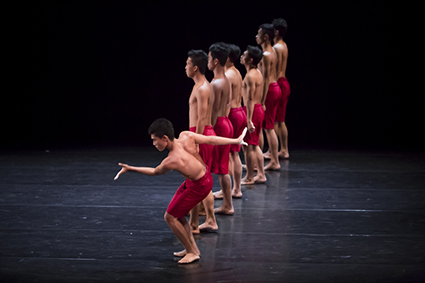
Cry Jailolo
photo Claude Raschella, OzAsia Festival 2015
Cry Jailolo
Play
From choreographers and dancers Sidi Larbi Cherkaoui and Shantala Shivalingappa, the work Play is all in the title: the pair dance the play of childhood exploration; they play their cultural heritages against each other. Musical instruments are played; as is a game of chess. Hands play out a rhythm on a wooden table, projected large above the stage: a vision of music as choreography, the creation of music through play.
It is a slightly uneven work—an extended mask sequence plays too heavily on an outdated sense of humour; a blindfolded dance with an audience member jars. But when the work excels it’s compelling. The key to the passion and complexity of the work is found in Cherkaoui and Shivalingappa’s playing out of their dance vocabularies: contemporary European dance versus classical Kuchipudi from India.
In the moments of contemporary dance both performers are virtuosic, engaging with physical limits and expressing all the possible beauty of their bodies, communicating with each other and with the space they embody. In a solo passage Cherkaoui extends his body into a state of almost incomprehensible looseness: throwing himself around the stage, he extends his legs beyond what seems possible; he arches his back beyond the limits of the spine’s capacity to bend.
But as the pair begins to perform elements derived from Kuchipudi the limitations of Cherkaoui’s training in the form and the intensity of Shivalingappa’s show through. His wrists are never quite held at the right slant; his fingers don’t hold the same tension and power as hers; he never quite achieves the same angularity in the movement of his shoulders and head. This doesn’t diminish our view of his virtuosity; instead, it allows us to fully appreciate hers.
The pair play further with this idea. Hands clasped behind their backs they perform the same rhythmic footwork. Cherkaoui’s feet stamp in heavy black shoes. Shivalingappa’s barefoot soles pound the stage, her toes curling upwards. We see their movements as pure representation of the lineage of Indian dance alongside the European, both manifested here as resolutely modern and born of play.
Topeng Cirebon
While modern Asia was the focus of most of director Joseph Mitchell’s first OzAsia Festival, his curation also reached back to traditional art forms. From the West Javanese city of Cirebon, two dancers and a 17-piece gamelan orchestra presented Topeng Cirebon: a continuing tradition of masked dance performance, dating back 600 years.
With intricately carved wooden masks, performers Nani Losari and Inusi embody traditional characters: playing with ideas of nobility, gender and the devil. They show strength and control as they hold their bodies in squats; they intrigue us as the smoothness of movement in their wrists plays against juddering limbs.
The comfortable seats and LED stage lights of the Dunstan Playhouse feel somewhat at odds with the presentation of this traditional form, and the performance extends for perhaps slightly too long for anyone not knowing topeng and thus unable to pick up the intricacies in shifts between scenes and physicalities. But with only one performance in the festival, Topeng Cirebon is a work firmly aimed at Adelaide’s Indonesian community: an audience invested in this traditional form and excited to see leaders in the craft.
OzAsia’s strength is its focus on both the historical and contemporary art forms it brings to an Australian audience. It’s necessary to see work like Topeng Cirebon to more fully understand the culture of Cry Jailolo and the masks of Play. Still, to Western eyes the passion, power and talent of the region and its artists comes through less when showing us the past than when it is built upon, driving dance into the future.
OzAsia Festival 2015, Cry Jailio, 24-26 Sept; Play, 2-3 Oct; Topeng Cirebon, 26 Sept; Dunstan Playhouse, Adelaide Festival Centre
RealTime issue #130 Dec-Jan 2015 pg. 10
© Jane Howard; for permission to reproduce apply to realtime@realtimearts.net
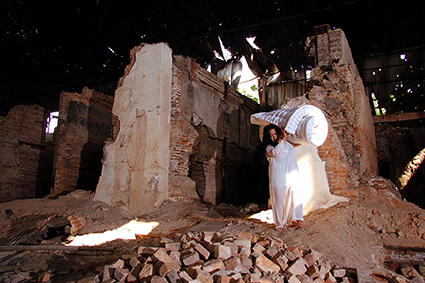
Melati Suryodarmo, 24,901 Miles
photo courtesy OzAsia Festival, 2015
Melati Suryodarmo, 24,901 Miles
Over a roomful of red sand 15 centimetres deep, Melati Suryodarmo transports a large, white mattress. She carries it on her head in the familiar burden-bearing posture of the Global South or arches it over her prostrate body as though sheltering from the elements. The other object in the space is an old spade with which Suryodarmo moves, Sisyphus-like, shovelfuls of sand from one part to another without discernable purpose. At other times, it is clear she is attempting to erect a trench or ridge, but such utilitarian action seems always accompanied by a sense of defeat—at any moment her sculpting of the landscape may be abandoned, Suryodarmo’s task unfinished as she resumes dragging the spade unproductively around the space, or wearily retreats to the sanctuary of the mattress.
There are few unambiguous cultural signals here. The artist’s earth-coloured scrubs are carefully neutral in effect, and even the red sand—palpably redolent of the history and landscape of Indigenous Australia—was, as Suryodarmo explained to me during our interview, an “accidental connection,” chosen simply as a reflection of the red brick with which houses are usually built. The work’s inescapable resonances with the unfolding European refugee crisis were similarly unpremediated. As I learned, Suryodarmo revels in these serendipities, and most especially in the multiplicity of meanings they open up for audiences of her work. “Consciously or unconsciously,” she says, “the public’s view of my art reflects their baggage, their own background, their own space. That’s why I like art, because it doesn’t necessarily have to be authoritative in terms of offering thoughts. Often I think we forget that artists should just give an impulse, a hint or a cue. People like to enter dimensions other than their daily life.”
24,901 Miles, commissioned by OzAsia Festival, is the first live performance Suryodarmo has premiered in Australia. Accompanied by a significant retrospective of documented live performance works and video art held across multiple venues, the moment feels overdue. Dividing her time between birthplace Indonesia and adopted home Germany, site of her alma mater, The Braunschweig University of Art, Suryodarmo’s body of primarily durational work has acquired international standing. Doubtless her tutelage by Marina Abramovic has opened doors, but we need not make too much of this—Suryodarmo’s practice is highly distinctive, a synthesis of European and Indonesian influences and methodologies that, through the filter of an absorbingly eccentric and charismatic personality, transcends category and boundary in its restless interrogation of form and its limits. “For me,” Suryodarmo confirms, “there are no restrictions; my work is fluid.”
I ask her about the differences she has perceived between the reception of her work in Europe and in Asia. “I cannot represent public opinion about my work,” she says, “but what I feel through being curated in different kinds of festivals and exhibitions is that the interest in new, contemporary performance is growing in the Asia-Pacific region. In Europe the curatorial ethic is very strong, related to political thought, to cultural politics, but I’m still seen there as representing Asia—not just Melati as Melati. As long as this sort of thing is still going on in the performing arts market, I’m very much not interested.”
Suryodarmo contrasts this with the contemporary visual art world in which she detects a greater openness to formal experimentation and less overt pressure to act as cultural envoy. “There are more people there interested in my art form, in performance art and video. But during the last couple of years I’ve also been working with dancers, choreographers, actors and also visual artists because I want to explore the relationship between theatre and dance, between many different modes. So it’s not just about taking performance art out of the gallery and inserting it into the theatre world; it’s about encounters and exchanges, about how the audience meets the artist.”
Suryodarmo’s work is not usually visceral, nor confronting or confrontational. Unlike many of the artists currently engaging with the international resurgence of body-based performance art, she places her body under stress but not in situations of extreme peril—rather the work is meditative, an accumulation of subtle, repeated gestures or phrases that focus the passing of time. This may be as little as six minutes, as in the case of her best-known work, Exergie—Butter Dance (2000), or, more likely, as much as several hours, or even a day or more. I Love You (2007) saw Suryodarmo convey a 35-kilogram pane of tempered glass around a room for up to six hours while repeating, to the point of meaninglessness, the phrase ‘I love you.’ “I had to move carefully,” Suryodarmo says of the work, “my body following the object. But that’s also like daily life, where many things move you in one direction or another.” In I Love You, as in much of her work, Suryodarmo’s attitude towards her body is one in which her power of authority over it is partially surrendered, creating a vivid tension between the artist’s agency—her ability to bear and shift the weight of a heavy, unwieldy object—and the physical limitations imposed by both the object and the terrain of the performance space.
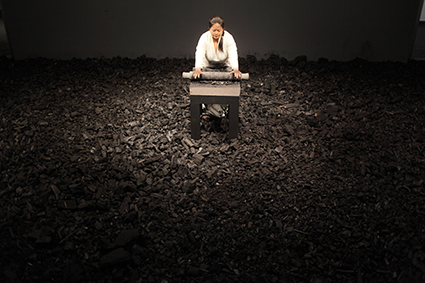
Melati Suryodarmo, I’m A Ghost In My Own House, 2012
photo courtesy the artist and APT8
Melati Suryodarmo, I’m A Ghost In My Own House, 2012
The single mattress in 24,901 Miles has been distilled from the 20 with which Suryodarmo performed Dialogue With My Sleepless Tyrant (2013). In that work, inspired by the Hans Christian Andersen fairytale The Princess and the Pea, Suryodarmo lay between the mattresses with only her head exposed, her long hair trailing down the side of the stack in an image that recalled another children’s story, Rapunzel, as recorded by the Brothers Grimm. When the weight became too much for her to bear, Suryodarmo would rotate her body and push upwards until the mattresses crushing her toppled to the ground. If I Love You assayed the burden of words and hackneyed notions like romantic love through a sustained image of the body under pressure, then Dialogue deployed an equally suffocating materiality as a metaphor for the social expectations faced by women.
In 24,901 Miles (the work’s title is derived from the circumference of the Earth at the equator) Suryodarmo does something else again, the peripatetic mattress becoming a symbol of home and of our search for roots in a time of mass displacement. The work’s development began, Suryodarmo explained to me, with an investigation of the circular nature of the movement of people and cultures throughout history: “I’m very interested in how our relationship with our ancestors moves in a circle. So in my own culture we see how the Indian people influenced Indonesian culture, also the Aboriginal people here—they grew up, moved, and they came back again. I’m fascinated by the way this cycle never comes to an end until we say ‘actually, I am looking for a home.’ And this is everybody’s basic myth—to have a home. Even people who deny it, strong people who say ‘no—I don’t need a home’, imagining perhaps that their body can be a home. But it can’t.”
The necessity for shelter—a spiritual as well as material precondition for a life well lived—is at the heart of 24,901 Miles, a fact emphasised by Suryodarmo’s resilient but ultimately fragile physical presence within the space. Despite her solid frame, she looks small amid the furrows of red sand, which are thrown into dusky relief by four amber lights. As she drags the mattress and shovel around, she visibly tires, her hair becoming increasingly dishevelled, her face draining of colour from the effort to navigate the encumbering sand. It’s impossible to witness the artist’s physical weakening, stretched out over the work’s two five-hour days, without thinking of the tens of thousands of Syrian refugees huddled in the winter cold of alien countries and wishing, more than anything, to circle home.
This, for Suryodarmo, is not merely an abstraction. Though not a refugee, she has a fraught relationship with migration. Her 1998 work Der Sekundentraum saw her reflect on her doubts around identity and belonging through the folding and piling of hundreds of items of clothing that she had collected during her time away from home. After disordering them again, Suryodarmo then put each item on until the weight and physical constriction of the clothes prevented her from moving—an archetypal anxiety dream in which the body is rendered immobile by an increasingly oppressive outside force.
I ask Suryodarmo if she still considers Solo, Java, the city in which she was born, to be her home. “Yes,” she replies, then adds heartily: “and Germany!” It’s a typical answer, testifying to the fertile crosscurrents of time and place Melati Suryodarmo—perhaps more than any physical location—inhabits.
OzAsia Festival, Melati Suryodarmo, 24,901 Miles, Artspace Gallery, 25-26 Sept; Selected Works, Contemporary Art Centre of SA (CACSA), 9-30 Sept, Artspace Gallery, Adelaide, 9 Sep-4 Oct
Melati Suryodarmo will perform her 12-hour work I’m a Ghost in My Own House (2012), in which she crushes and grinds hundreds of kilograms of charcoal briquettes into powder and dust, in the 8th Asia Pacific Triennial of Contemporary Art (APT8) at Queensland Art Gallery | Gallery of Modern Art, Brisbane 21 Nov, 2015-10 April, 2016
This interview is a co-commission with Tanzconnexions Asia-Pacific (Goethe-Institut).
RealTime issue #130 Dec-Jan 2015 pg. 11
© Ben Brooker; for permission to reproduce apply to realtime@realtimearts.net
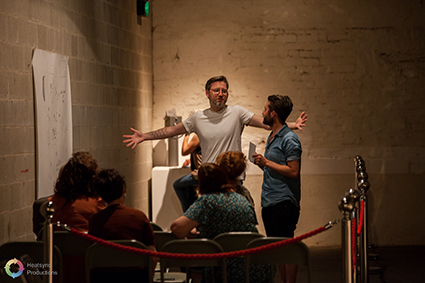
101.IS TO 5000.AU, Sandpit /Kviss Búmm Bang performance
photo Jennifer Greer-Holmes
101.IS TO 5000.AU, Sandpit /Kviss Búmm Bang performance
Near and Far is the first public project of Performance & Art Development Agency (PADA), founded by Vitalstatistix Creative Director Emma Webb and Country Arts SA Creative Producer Steve Mayhew. “Exploring distance, time, communication and personal agency” (program), the event—held in Adelaide’s heritage-listed empty shell venue the Queen’s Theatre—presented four new works of wide-ranging and resonantly contemporary form and theme by Australian and international artists, as well as an experimental criticism project and artist talks. Mayhew’s keywords at the event’s opening were “corroboree” and “minimalism,” suggestive of an inclusive, ritualistic celebration of community and live performance in what are increasingly attenuated times for the arts. Webb was more blunt, signalling her prevailing desire for Near and Far to “engage with the fucked up-ness of the world.”
Kviss Búmm Bang
Icelandic participatory art makers Kviss Búmm Bang were not present for 101.IS TO 5000.AU, its running ceded to collaborators Daniel Koerner and Sam Haren of Sandpit. The title references the postcodes of Reykjavik and Adelaide, the two cities the work is designed to bridge through a set of instructions to be completed by audiences. Our first task was to collectively produce a map of Iceland on a large sheet of paper, felt-tip markers and imperfect memories our only aids. I contributed a wild guess as to the location of one of Iceland’s famously large and powerful waterfalls while others doodled the country’s airports, volcanoes and other icons. Meanwhile, audience members were randomly selected to use a rotary-dial telephone to place calls to various Icelandic establishments—hotels, restaurants and so on—for the purpose of discovering more about the country, each caller given a card that suggested a particular line of questioning. The work neatly exposed our ignorance of distant countries. At its conclusion, we bagged up the map for postage via snail mail to Iceland. I can only hope that its recipients’ laughter at our inept effort to map their homeland is cut short by their own realisation of how little they know of ours.
Sarah Rodigari/Josie Were
No doubt Emma Webb programmed Sarah Rodigari’s Reach Out Touch Faith on the strength of her viewing of the work’s first iteration, with Emma Hall performing, at Arts House’s Going Nowhere in 2014 (RT125). Here the work is delegated to Josie Were (and the goat is Eddie, not Cindy) but the text—a performance lecture written in conjunction with UK artist and psychologist Joshua Sofaer about environmental ethics, the outsourcing of live art and our fear of missing out, accompanied by a very present animal—is unchanged. Draped in an airline blanket, Were delivers Rodigari’s monologue perceptively and humorously, veering from the text only to retrieve Eddie whose restlessness sees him dive off the back of the stage to the audience’s alarm. Despite the goat’s best attempts to entirely upstage Were, he fails. Rodigari’s text is a beautiful composition (it would work equally well outside a performance context), scholarly and deeply human, universal and confessional. Constructed in deceptively simple prose, it’s a kind of Freudian sluicing of neuroses around the cost in carbon of the artist’s (necessarily?) jet-setting practice. More broadly, the text dials into ongoing debates about the ontology of delegated performance and the validity of individualistic approaches to mitigating climate change. What is compromised and what made possible when, to invert Marina Abramovic, the artist is not present? It’s a question that will recur more frequently, and with greater import, as the outsourcing of live art continues to abrade old anxieties around authenticity, and as we pass frightening new climate change tipping points.
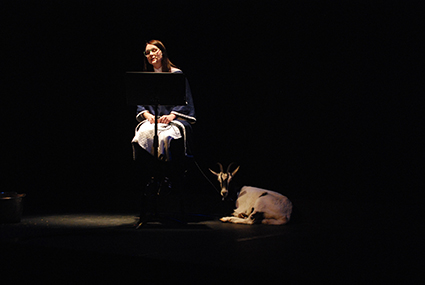
Josie Were and Eddie, Reach Out Touch Faith
photo Aaron Herczeg
Josie Were and Eddie, Reach Out Touch Faith
Jason Sweeney
The final in a trilogy of ‘quiet’ works, interdisciplinary sound artist Jason Sweeney’s Silent Type, with furniture design by Dale Wright, provided an elegant space for meditation amid the hubbub of the exhibition. Replacing our shoes with hotel-style slippers, we are greeted upon entry with two oversized books laid out for our inspection. Gorgeously minimalistic in design, the books contain dozens of ‘instructions for listening,’ which recall Brian Eno’s famous Oblique Strategies intended to spur creativity and generate lateral thoughts. A typical instruction reads: “Walk towards a window and put your head out into the air. Move your head and listen to the shifting sounds. Try to replace the sounds of cars and people with birds.” In the centre of the space sits a cross-legged, guru-like Sweeney on a round mat, surrounded by the accoutrements of the DJ: twin turntables and a mixer. There are two listening stations with headphones into which Sweeney pipes his nominal set, “a resonant and melancholy collective sound in a space where all that is left are scattered remains, hopeful fragments, sustained chords and distant echoes” (program). In another part of the space a different, deeper kind of introspection is catered for: noise-cancelling headphones lining a circle of wooden benches that surround a group of candles. I slip a pair of headphones on, close my eyes and happily let minutes pass in silence. I don’t fall asleep, as Steve Mayhew encouraged us to do during his opening remarks, but I do appreciate anew the capacity of the quiet to restore and prompt reassessment in our perpetually noisy culture.
Sarah-Jane Norman
Contrastingly, Sarah-Jane Norman’s work-in-progress Stone Tape Theory deploys a complex, nightmarish soundscape to explore memory and trauma. Norman, confined to a darkened space for 30 hours (in six-hour intervals over five successive days), uses analogue tape to record a stream of haphazard recollections from her recent and distant past, broadcast simultaneously into the space over 12 separate channels. Constituting a kind of audio palimpsest, each tape is erased following playback, and another recorded in its place. The result is an eerie, constantly evolving sonic landscape of fragmentary narratives and, finally, auto-decay as the tapes are worn unusably down. The work takes its name from the hypothesis of residual haunting, which posits that inanimate materials such as stone or wood can store and play back, as apparitions of one kind or another, impressions left by traumatic events, asking whether memory itself is not a kind of haunting, a ghostly afterimage of half-remembered experience that lingers within the body. Novel, unsettling and demonstrating fearless commitment from the artist, Stone Tape Theory should progress to full realisation with high hopes.
Jane Howard
Finally, Adelaide-based critic Jane Howard presented Simple Art Transfer Protocol, an experimental criticism and documentary project. Over the exhibition’s five days, Howard engaged via a subscribeable series of email chains with fellow critics Nicole Serratore (New York), Cassie Tongue (Sydney) and Megan Vaughan (London). Using the works in Near and Far as jumping off points, the conversations—passionate, articulate and deeply personal—traversed aesthetics, the state of criticism, diversity and representation in the arts, and much else besides. Howard was also physically present throughout Near and Far, hosting a series of similarly eclectic discussions from behind a desk strewn with performance books and accompanied by a world map on which she progressively plotted the location of her subscribers (not surprisingly, they were concentrated in Adelaide but their range was impressively international). All in all, it was a fascinating, though perhaps conceptually and ethically unresolved, experiment in embedded criticism that was able to generate refreshingly vivid dialogues about art and how we talk about art.
–
PADA, Near and Far, curators & producers Emma Webb, Steve Mayhew, Queen’s Theatre, Adelaide 16-20 Oct
RealTime issue #130 Dec-Jan 2015 pg. 13
© Ben Brooker; for permission to reproduce apply to realtime@realtimearts.net
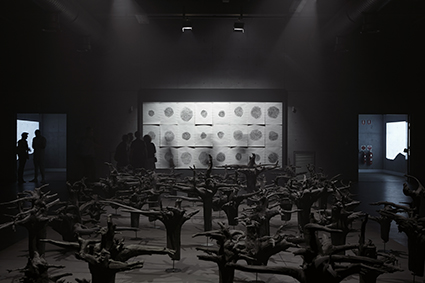
The Black Stump, Jonathan Jones
photo Zan Wimberley
The Black Stump, Jonathan Jones
The springtime flowering of Performance Space’s Liveworks was well worth waiting for to revel in a wild garden of strange varieties, brilliant hybrids, spooky ornamentals and unnamed species. But brightness can bite the spirit and the darkness in undergrowth eat at the soul. New experiences disoriented us aesthetically, perceptually and morally in a festival that realised the best part of Performance Space’s annual program in three delirium-inducing weeks.
Jonathan Jones, guguma guriin/black stump
Desecrated nature was a grim presence in Jonathan Jones’ guguma guriin, black stump—an eerie field of 32 inverted native tree stumps hoisted low on small black metal stems, entwined roots twisting painfully out and upwards as if tormented at the moment of the trees’ passing.
The darkened gallery, the formally arranged stumps, charcoal rubbings of their cross sections on a wall and the recorded singing ‘in language’ of “Amazing Grace” conjures a memorial place, a complex spiritual space in which the pain of loss of sacred land to colonisation coexists with Christian optimism and without contradiction. Guguma guriin was a hauntingly memorable Liveworks centrepiece, its ‘liveness’ manifest in the triggering of learning and sad reflection.
Wade Marynowsky, Robot Opera
A different kind of immersion was experienced in Wade Marynowsky’s Robot Opera, a spectacle which I mostly enjoyed in the moment but less so on reflection. Stephen Jones (p20) addresses the issue of autonomy and control, so important if we are to believe that we are meeting robots, not animatrons. At least these robots were not pretend humans and were about as agile as Daleks. Robots are fascinating but do we need to dramatise their effects on us; movies have long done so. Here, in the vast Bay 17 we sight the robots; they signal us, it’s beautiful but we don’t get it; they advance; we mingle cautiously; they appear to track some of us, we’re fascinated; they form two lines between which we are corralled; the robots flicker and buzz, huge lights cross over us, the sound score erupts, warlike, with soaring quasi-spiritual soprano choiring, we feel threatened (are they Dalek cousins?); and then, entropy—the robots turn off, save for one which wanders among us (‘Sadly?,’ we finally project) to a halt. No messages. No exchange. The end. No narrative payoff, after all that. Not such a strange encounter, even if adroitly engineered, produced, composed and lit.
Victoria Hunt, Tangi Wai…The Cry of Water
The issue of heightened production values at the expense of content came up strongly at the RealTime forum at the end of Liveworks, in which a couple of festival-goers worried at a superfluity of effects in Victoria Hunt’s Tangi Wai…The Cry of Water, a work they nonetheless appreciated in many respects. The effects were truly remarkable but their relationship with the moving bodies of the performers uncertain, frequently veiling them and some seemingly key design elements. Had we witnessed a dance/movement work or an enormous light and water sculpture in which was buried an evocation of the cultural/spiritual life of women of the South Pacific? Some moments stood out: Hunt’s primordial birthing figure and Kristina Chan’s crawling, panic-breathing creature (who or what is she?) struggling to stand. Otherwise how central was movement to the work? As in Robot Opera, an overwhelming sound score demanded attention, here evoking the power of wind and water, complementing the visually dominant beauty of falling mist and the ebb and flow of low shoreline waves in a female water world inhabited by barely discernible gods and spirits. Experience of Hunt’s previous work helped (Copper Promise: Hinemiki Haka, 2012, RT109, p6), but Tangi Wai is not an exposition of cultural knowledge, it’s Hunt’s embodied expression of her culture, if with far less body than anticipated. The work concluded with a deeply alarming image, a surprisingly literal one that evoked the end of traditional South Pacific womanhood with the advent of European colonisation.
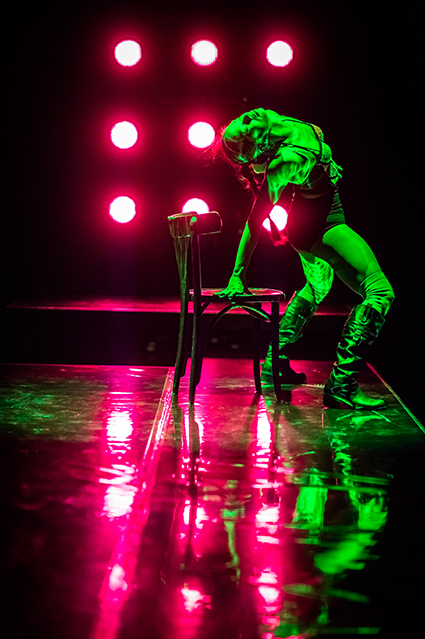
Eisa Jocson, Macho Dancer
photo Zan Wimberley
Eisa Jocson, Macho Dancer
Eisa Jocson, Death of a Pole Dancer, Macho Dancer, Host
Context was again an issue, if in a different way, in the performances by Filipino dancer Eisa Jocson. “The invisibility of the original context was problematic,” writes Fiona McGregor. Meaning is clear enough: example, the three figures Jocson represents are exploited workers—pole dancer, macho dancer and a Filipina who takes on the traditional dance young Japanese won’t. But MacGregor sees these dances (she saw the first two) as abstracted from reality by European dramaturgy, making them purely art objects for delectation for a certain class of viewer not likely to have experienced the gritty reality of the venues where the dancers perform. The truth of that aside, Jocson’s works are nonetheless powerful expressions of empathy and protest by an artist committed to learning these demanding forms. The full power of her performances will doubtless be felt at home in the Philippines where context will be a given.
In Death of the Pole Dancer I was taken by Jocson’s considered construction and testing of her pole—circling and rhythmically thrusting herself against it with a complementary sharp clicking of her heels and inherent musicality. The repeated, slow upside down slide that concludes the work portrays the pole dancer’s demise (Jocson admitting in an interview a few days after that she is now almost beyond executing the demanding move). In Macho Dancer, Jocson becomes a young, gum-chewing male dancer passing though a series of telling phases in which he is variously proud, defiant, calculatingly erotic and sulky; at one point he stops dancing and withdraws into upstage shadow—a tease or a moment of existential doubt?
In Host, as we hear the lap and drip of water to temple bells and gradually distorted chanting, Jocson’s foreign worker appears in a kitschily glittering kimono, dances with a Noh devil mask and then peels off her outfit to reveal a finer, more tasteful kimono in which she dances with great refinement. Another layer, and another, is removed to near nakedness with erotic intent, but the outwardness of the performance turns bhuto-ishly inward, until the dancer is finally transformed into a grinning pretend teenage Korean pop star. Jocson’s entertainment industry worker is never less than adaptable, meeting market demands for Japanese refinement but also for the satisfaction of darker desires that lie beneath.
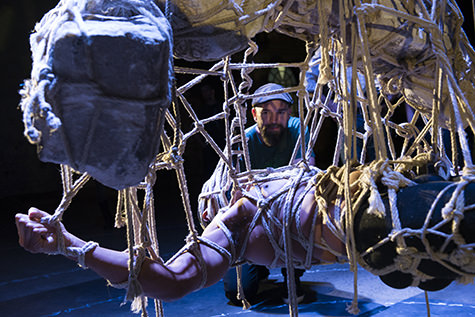
Garth Knight, Nemeton, Liveworks
photo Amanda James
Garth Knight, Nemeton, Liveworks
Garth Knight, Nemeton
Also ‘out of context’ was Garth Knight’s Nemeton. Staged in Carriageworks’ vast foyer it brought to the fascinated public gaze the usually more private display, often photographic, of Japanese rope bondage, shibari. With a timber frame, rope and rocks Knight constructed a striking series of sculptural creations, each night incorporating a naked or near naked participant. When I saw the artist at work he had meticulously knotted the rope into something that looked like a three-trunked tree emerging from a bed of suspended rocks beneath which he was hanging a woman horizontally, her head arched back tautly, mouth stopped, legs flexing, muscles twitching involuntarily. Beautifully crafted but quite disturbing, the work prompted thoughts variously of being buried alive, crimes against women, the right to explore one’s physical and emotional limits and the complexities of ‘beauty.’ Foyer noise, audience movement, bright light, disco music and the artist going about his work partly undercut a sense of voyeurism, but not the power of the work.
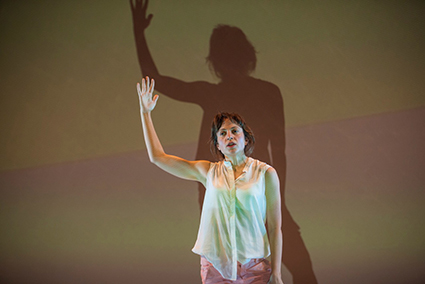
Nicola Gunn
photo Alex Davies
Nicola Gunn
Nicola Gunn, Piece for Person and Ghetto Blaster
Spoiler alert: if you haven’t yet seen Nicola Gunn’s Piece for Person and Ghetto Blaster, you might not want to read further. Gunn brings words powerfully into play in Liveworks in surprising ways. The show’s kind of stand-up but utterly physicalised with a constant stream of exercises and emotionally illustrative poses and movements. It’s a moral and physical workout, exhausting for performer and audience in the best possible way. Central to the work is the artist’s recall of seeing a man, a refugee she thinks, throwing stones at a nesting duck. It’s “a sitting duck,” she explains, incubating eggs and therefore will not move. A duck admirer in particular (“You are so awesome, duck”) she is outraged but worries at the refugee’s state of mind, triggering a relentless stream of moral speculations, relativities and contradictions. These are connected through a series of motifs, including the film Brief Encounter and things Belgian—Ghent (where she sees the assault on the duck), Poirot (well, the actor who plays him) and 19th century playwright Maeterlinck whose symbolist theatre made puppets of actors. Also recurrent are observations about artists: “How do you make something you don’t know to create? Artists do it all the time!” and, self-defensively in imagined conversation with the refugee, “I’m not on the lookout for material.” Plus there’s some “What would Marina do?” sniping at Marina Abramovic (Gunn was one of the 12 Kaldor Public Art Projects artists recently working with her). The motifs begin to add up when Gunn reveals her own anxieties—she’s concerned about lacking energy, being in her “early late 30s” and admits to having behaved badly in Ghent, rationalising this with the philosopher Levinas’ notion of “the temptation of temptation.”
The breathtaking workout having pretty much run out of words and puff and Gunn having failed ‘to stand in the refugee’s shoes,’ she spectacularly transforms into the object of her admiration, the mother duck, slowly repeating just a few words which are increasingly swamped by Kelly Ryall’s score, now deep organ notes and high shrill ones—including “I’ll sit and think awhile” as laser beams sweep around us in a self-mocking, over-the-top fantasia of identification and evasion.
Witty, outright funny, deeply intelligent and, as intended, morally perplexing, Piece for Person and Ghetto Blaster joined Eisa Jocson’s trio of performances, Jonathan Jones’ guguma guriin and Vicki Van Hout’s Les Festivités Lubrifier as festival experiences I’ll long remember. Gunn and Van Hout make a great pair: wickedly funny, self-deprecating ironists and highly inventive artists, both playing experimentally with form in ways that make their works rewardingly unpredictable. To again quote Gunn, “How do you make something you don’t know to create? Artists do it all the time!” That’s experimentalism, which is the thrill of Liveworks, an intensive gathering of works that test forms, ideas and the senses and, above all, our openness to new experiences. I look forward to the next of these annual wild flowerings.
–
RealTime issue #130 Dec-Jan 2015 pg. 14-15
© Keith Gallasch; for permission to reproduce apply to realtime@realtimearts.net
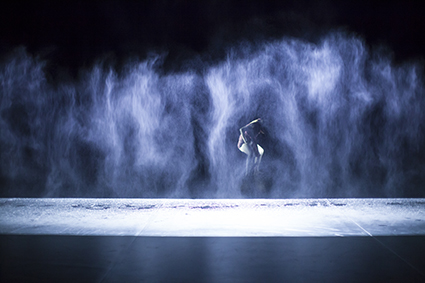
Tangi Wai, Victoria Hunt, Liveworks Festival, Performance Space
photo Alex Davies
Tangi Wai, Victoria Hunt, Liveworks Festival, Performance Space
A piercing single light source, an eye which surveils. Cracking, rumbling materiality of Earth’s movements sonified. Visual and auditory marks of something transcendent above and below. It exists; we are born. These, the originating gestures of Victoria Hunt’s latest work Tangi Wai—The Cry of Water, herald new formations in discrete episodes which roll out like waves, first lapping at our attention, then amplifying in their motion and affect through a finely crafted composition of light, sound, movement, object and, indeed, water.
Creation. A hunched form is fed life through a tube of pulsing light, vacillating somewhere between Frankensteinian construction and a story from the Book of Job. The noise of geo-thermal pressure gives over to zapping scapes that spark more life (sound design James Brown). Figures appear, naked from the waist; they float, encircled by light, gently rocking hips and snaking vertebrae, headless and faceless, the female form enshrined. A tension is assumed between bones fossilised, pre-civilised and their careful ‘plinth presentation’ on long crimson skirts (costume design Annemaree Dalziel, Victoria Hunt).
A duet emerges between Victoria Hunt and Kristina Chan within a river of light. Moving separately, but through similar pathways, a quality, rather than form or shape, emanates, birthing a new element—simultaneously solid, liquid, gas. Time and space are transformed. Something is stirred.
Hunt emerges alone from the darkness. We first feel and hear the wetness of the space. Passing light glints from the vertical descent of a cloudy mist of water droplets that stream steadily from sky to earth. The figure exposes flesh and bone through a wrap of fabric, escaping modesty and flirting on the edge of light in thrusting motions with widened hips in deep open second position: ducking, diving, drilling. Amphibious female morphologies slither wet in powerful strokes. Bands of white light roll in, thin metered lines, smooth and hypnotic. They expand, hitting the falling water at a perpendicular angle with the beat from Brown’s now trancey score. Body, light, water and sound are a tempest, a cry; it’s a liquid dramaturgy (video and light design Boris Bagattini; light and mist design Fausto Brusamolino).
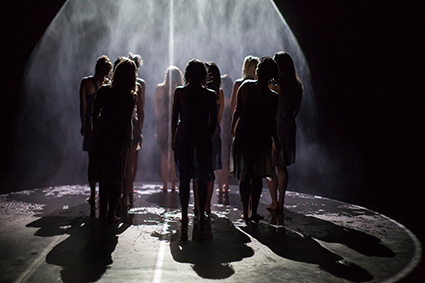
Tangi Wai, Victoria Hunt, Liveworks Festival, Performance Space
photo Alex Davies
Tangi Wai, Victoria Hunt, Liveworks Festival, Performance Space
Ten other cast members assemble in various formations on the margins. We rarely see their faces, but hear their pants and cries. They move in pairs or small groups to elongate body parts with curious appendages (object design Claire Britton, Victoria Hunt); flick hand-wrist gestures above their heads like scribes to the gods; incubate restlessly, but with subtlety in a womb of light, to lay out the spine of a moth (or butterfly) in a final scene. Winged projection ripples on the wall of water still dripping. Sounds of lightning crash with violent strobe flashes, the line of supine bodies is now headed by Hunt who slowly rotates to a monstrous reveal. There’s an overall Geiger-like appeal to the aesthetic, where sharp white and red light explodes and shines off oily black surfaces, with multiple scenes of suspended vertebrae and this final insect-like assemblage.
Tangi Wai is an intensive and immersive sensorium of image and deeply layered affect with its elements captivatingly sculpted by a rich collaboration of artists.
–
Performance Space, Liveworks Festival of Experimental Art, Tangi Wai—The Cry of Water, concept, choreographer, director, performer Victoria Hunt, dancer, choreographer Kristina Chan; Carriageworks, 28 Oct-1 Nov
RealTime issue #130 Dec-Jan 2015 pg. 15
© Jodie McNeilly; for permission to reproduce apply to realtime@realtimearts.net
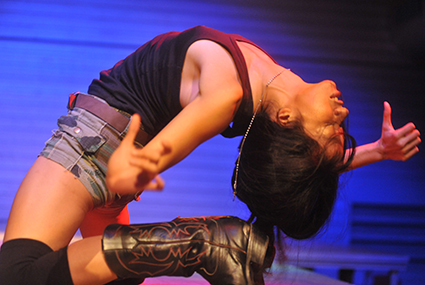
Eisa Jocson, Macho Dancer
photo Giannina Ottiker
Eisa Jocson, Macho Dancer
Eisa Jocson comes to us with accolades from Europe. These two solos investigating the performance of gender and sexuality are in a mode familiar to Sydney audiences of queer parties and clubs going back decades. Performance Space itself has intermittently supported such work since cLUB bENT in the mid 90s.
Jocson seems an ideal vehicle for these ideas. Trained in the visual arts and ballet, an award-winning pole dancer, her prowess is evident with every move. Death of the Pole Dancer was mostly taken up with the assemblage of the pole, one of my favourite sequences, with its simple indication of source, structure and the everyday behind the exotic dancer’s work. After grappling with the pole, Jocson eventually mounted it, hooking herself up feet first, sliding glacially down [to a distorted version of Dusty Springfield’s “I just don’t know what to do with myself,” Eds]. Audience members who could see her face would have benefited from a fuller range of expression.
Bringing to the stage a form that originates in spaces of sexual spectacle is more difficult than meets the eye. In the local context, foremost artists such as Sex Intents and Glita Supernova, were themselves strippers: the queer club spaces to which they transposed spectacle by women for men spelt instant subversion. The body dictated, even mocked, the dance for its own pleasure; the gaze was female and male queer.
Jocson’s audience was Sydney’s usual performance aficionados, the sexes evenly distributed, better versed in gender politics and more diverse in sexuality than their counterparts down at Sydney Theatre Company or over at Metro Theatre. Yet not, I would guess, well acquainted with pole dancing in clubs, or so-called macho dancing in the Philippines, where men dance erotically for mostly male clients.
The invisibility of the original context was problematic. The T-shaped stage for Macho Dancer brought the dancer among us, down to the last bead of sweat, yet interaction was a no-no. The product for salacious entertainment was replaced by a product for highbrow perusal. We sat politely admiring Jocson’s athletic androgyny, her immense skill and strength, the compelling slow moves. We wondered about her melancholy expression.
We wondered too about the original macho dancers in the Philippines, dancing no doubt with little choice, dictated by poverty. Were we westerners implicated in that? Yet these works were honed in the laboratories of the European avant-garde. What about us women? Is this part of the inexorable move of women towards sexual consumerism? Cause for celebration then? Yet gender, rather than highlighted, felt flatlined. We thought about pole dancers and macho dancers, yet we did not feel any closer to them for the experience.
Liveworks Festival of Experimental Art, Death of the Pole Dancer, artist Eisa Jocson, Carriageworks, Sydney, 4, 5 Nov
RealTime issue #130 Dec-Jan 2015 pg. 16
© Fiona McGregor; for permission to reproduce apply to realtime@realtimearts.net
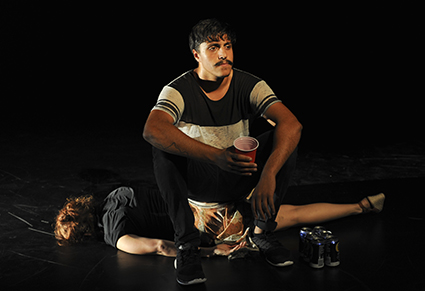
Thomas Kelly, Vicki Van Hout, Les Festivités Lubrifier
photo Heidrun Löhr
Thomas Kelly, Vicki Van Hout, Les Festivités Lubrifier
Thomas E S Kelly is on stage to welcomes us. A pile of clothes heaped stage left. Red plastic cups, and six-packs of beer stacked on a trolley stage right. Vicki Van Hout enters, part concealed in a well-padded, long pocketed navy blue parka. “Am I late?”
The rehearsal begins, but what to dance to? Kelly is asked to flick through the files on his phone to find the music, The Avenue, and a tempo in this tempo-lacking piece. Van Hout pulls from her pocket a printed email from the Finnish guy who composed it and wants her to choreograph to it. They met on Van Hout’s birthday, her 45th, in Paris, while she was a resident at the Cité Internationale des Arts. Among other things said slightly ‘off’ in translation, he “thanks her for existing.”
From this moment, the psychedelia of Van Hout’s travelogue recounted in bursts of hilarious, hyperbolic description—well written—land us elsewhere, in a non-fictional past. But fact and fiction in this meta-tale become as murky as the River Seine. Frenetic reveries of arriving in a city both beautiful and hostile to the foreign are physicalised. Neuroses ‘on high’ and she’s missing a device: her mobile phone—indubitable life support, much like a heart or lung when the technology of language for communication malfunctions. In an apartment decorated in cotton coloured undies pulled from every orifice of her long parka and strung haphazardly over the front row of the audience to air, her phone appears, misplaced, not lost. Social connections enabled. Lubricated (lubrifié). And the party (Les Festivités), well, not quite yet…
Present time. Rehearsal continues. Van Hout’s deprecating humour (and crankiness) toward self and others works overtime. Something about being 50, and the synapses not quite making the right connections. Who remembers the chore? Stand just slightly behind and to the side in front. A section of The Avenue is danced to. Momentarily we are suspended from Van Hout’s narrating and berating as the trio grounded with strong centres cantilever torsos from hip. Precarity is never present, contradictory to the artist life as Kelly intimates in an earlier scene. Shovel, paddle and whipping windmill limbs; sure-footed fast turns and shift of place, displace. Land. Okay, great, Van Hout’s “nailed it”! But the music’s too short. They’ve run out of tempo. But it’s not the real dance—here, now. Even though we are watching, together, in this moment.
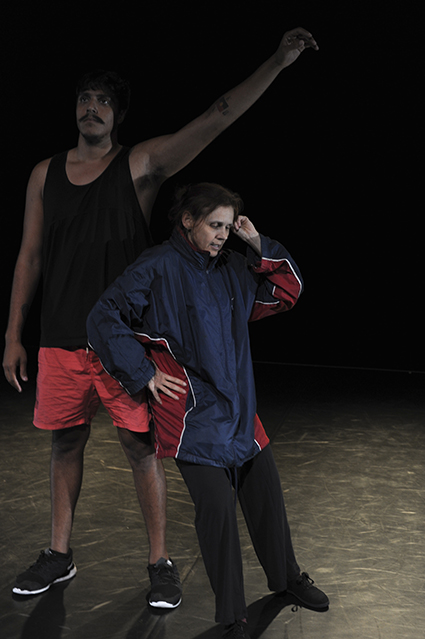
Thomas Kelly, Vicki Van Hout, Les Festivités Lubrifier
photo Heidrun Löhr
Thomas Kelly, Vicki Van Hout, Les Festivités Lubrifier
A tinny cracked and heels on. The auto-ethnographicist Van Hout whirls in a skirt with a pretty decent French accent, elle parle trés bien francais! Meantime slurping down the Fosters, filling cups and painting the scene as it was then, “dinner in a typical Parisian apartment of an Australian woman,” well decorated even when “belts are tightened.” Time and place oddly contract on stage and in the mind. Animated storytelling bridges these ‘then-now’ moments, while the pairing sequence of mostly Kelly and Van Hout narrate with weight, texture and force a physicalised, iterated accent to the spoken text—not just movement abstraction playing out on a separate track.
A sense of slippage between fiction and fact in the performative telling of a life event persists—however insignificant it may seem in the bigger picture (was it to try and make a dance?). Van Hout’s surreally constructed world appears as nothing less than brute fact from what is said and done on stage—like the beer drinking. She plays her self, somewhat exaggerated but, for those who know her, also not. This, along with the on-stage synergy between the trio and the unseen unheard “Chloe” alluded to up in the lighting box, is what makes the work endearing, rather than just funny, and more about the tenuousness of human relations: those that are fleeting and those made for life. Thanks for existing.
Liveworks Festival of Experimental art, Les Festivités Lubrifier, choreographer, performer Vicki Van Hout, performers Thomas E S Kelly, Caleena Sansbury, lighting design Chloe Stafford; Carriageworks, Sydney, 4-7 Nov
RealTime issue #130 Dec-Jan 2015 pg. 16
© Jodie McNeilly; for permission to reproduce apply to realtime@realtimearts.net
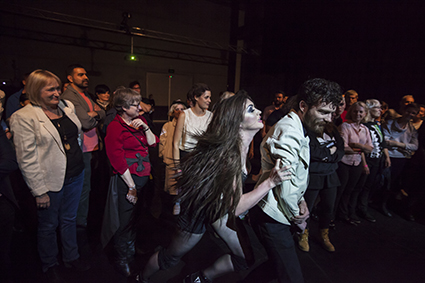
Hissy Fit, I Might Blow Up Someday
photo Alex Davies
Hissy Fit, I Might Blow Up Someday
The queer art trio Hissy Fit are all about blasting the notion of ‘hysteria’ for the way nonconformist women have been pathologised through the ages, dismissed as mentally ill rather than deviating politically from gender norms. Their latest work, I might blow up someday, borrowed from a catalogue of feminist and punk musicians—Chrissy Amphlett, Peaches and Wendy O’Williams—to create a performance work in which ‘hysterical’ movements like headbanging and moshing are reclaimed and celebrated.
For an hour, Hissy Fit assumed the roles of punk heroines, swinging hair and posing in black leather. It was moody and atmospheric, the performances heroic. The image that lasts is a particularly effective strobe-filled sequence of three silhouetted sci-fi-ish women in violet and orange beams of diagonal light and abundant smoke.
I suspect the contemporary art arena isn’t the right place for inducing collective hysteria, especially in a controlled black-box environment that suggests a more traditional audience-performer relationship. Perhaps some audience members still prefer a traditional art-going experience—one told me to be quiet and stop moving. Or perhaps the headbanging rock queen as a reclaimed symbol of the ‘hysterical woman’ can only go so far—this is Hissy Fit’s fifth or sixth reworking of the concept—and the leap from pathologised individual hysteria to liberating collective hysteria makes sense conceptually but is too big to actualise. Certainly the headbanging motif felt more successful in the more contained 2014 Tiny Stadiums performance and accompanying video artwork.
Think of Anjelica Mesiti’s 2009 video study in devotion, Rapture (silent anthem) in which the mass worship and hedonist togetherness of a rock concert depends on an audience’s recognition of a beloved melody. That’s missing here (along with the dynamism and spontaneity of Hissy Fit’s beloved riotgrrl influences) despite a carefully composed, rhythmic drone soundscape and strong but highly staged choreography. The decision to stage I might blow up someday as a music gig from a thrust, elevated stage ended up distancing the pacified audience from the performers, working against the performer-audience fluidity that Hissy Fit aimed for. We were viewers, not participants. You can’t manufacture chaos. The crowd mostly watched as two of the trio descended onto the floor for a highly constructed brawl in the final sequence.
The experimental area of dramaturg-facilitated performance work, blended with the conventions of live music, is a courageous and ambiguous space to play in. Pushing the bounds between disciplines was the mandate of the Liveworks Festival, and there’s a strong argument that experimentation in this space should be encouraged not for the result it produces but for the fact of the exploration itself. The show functioned best as an opportunity to observe an elaborately produced, one-hour headbanging session—an exhausting feat of durational self-punishment by strong, brave, hyper-focused performers; an ode to a more confrontational feminism past; and material for a series of striking stills or a video clip brought to life, witnessed from the safety of a respectfully observant audience pit.
Performance Space, Liveworks Festival of Experimental Art, Hissy Fit, I might blow up someday, artists Jade Muratore, Emily O’Connor, Nat Randall, lighting Toby Knyvett, sound artist Nina Buchanan, choreography Lizzie Thompson, dramaturgy Emma Price; Carriageworks, Sydney, 22-25 Oct
RealTime issue #130 Dec-Jan 2015 pg. 17
© Lauren Carroll Harris; for permission to reproduce apply to realtime@realtimearts.net
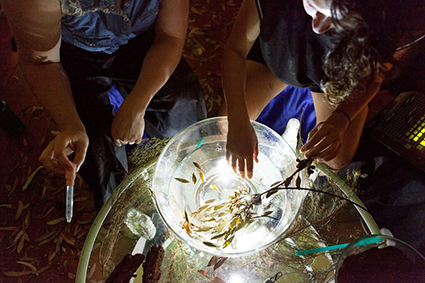
Meditations on Water, Mei Saraswati
photo Matt Sav courtesy Proximity Festival
Meditations on Water, Mei Saraswati
Carefully curated programs A, B and C take the Proximity Festival’s audiences along distinct pathways of experience, whether individually or as a marathon effort of 12 consecutive unique engagements. At the Art Gallery of Western Australia, works are performed in a selection of open spaces and behind-the-scenes locations, sometimes mingling with gallery patrons in the festival’s new daytime schedule. Also new this year is a Day Spa facility, serenely superintended by Ian Sinclair, himself a veteran Proximity artist. The Day Spa offers an oasis of calm, complete with cucumber slices, green tea and goldfish, as well as guided meditation recordings: a space to decompress, unpack and process the Proximity experience.
The performers have undergone an extensive selection process, as well as a two-week lab experience, working with Guest Provocateur Helen Cole from In Between Time, UK (RT129, p8). This year’s works each provoke in different ways, from subject matter to presentation to startling self-revelation. Some site-specific works engage closely with the gallery’s surrounds, history and architecture. Some intensely personal works depend upon the audience’s own internal resources. Some are contemplatively conceptual and some see the audience become part of a public art piece.
Program A: surreal
Program A embraces the surreal, each 15-minute experience leaving the audience bemused and wondering “did that really just happen?” Mish Grigor’s Sex Talk brings intimate revelations into the public gaze, with artist and audience at a plinth reading out transcripts of interviews about Grigor’s relatives’ sexual experiences. Malcolm Whittaker ambushes an unsuspecting audience in his engaging persona of enthusiastic volunteer usher, artfully steering the conversation and audience back to a plinth to experience the oddly intimate sensation of having one’s teeth brushed by a friendly stranger in his piece, Once of Twice Daily. Monopolly is set away from the daily life of the gallery in the sumptuous Foundation Club Room, where a calmly business-like Chloe Flockhart discusses with you the financial potential of investing in another human’s parts.
Jackson Eaton’s Current Mood uses the gallery space to explore art, modern relationships and connecting via social apps. The time between bells signalling the start of each session is crammed with a crash course in Snap Chat use on iPhone. The helpful usher is patient, but I am already distracted, wondering in what ways this experience will differ for those already familiar with this app and device.
Set loose in the Gallery, my first message arrives, a wittily annotated picture of an artwork. I look around, take a picture of a detail in a painting, put my own caption to it and send. The next missive arrives nearly instantly. Is there a theme here? Are we being randomly flippant? Is this interaction or swapping posts? Getting the hang of this, reducing mighty canvases to transient smartphone fodder, I am on a roll when the tone of incoming messages changes. “I thought we could make a connection.” “I don’t know if this is working.” The sudden change from jaunty confidence to plaintive self-doubt is disarming.
“Can I touch you?” appears on my screen, as Eaton appears in front of me, makes sustained eye contact as he raises his hand slowly towards my face, before abruptly snatching the phone out of my hand, turning on his heel and walking rapidly away as the next bell rings.
The experience raises a flurry of questions in its wake, encompassing the nature of engagement, communication, technology, distraction and the etiquette of art appreciation. Eaton’s deft manipulation of Snap Chat raises doubt over the validity of my responses.
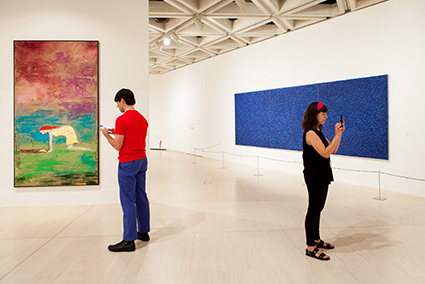
Current Mood, Jackson Eaton
photo courtesy Proximity Festival
Current Mood, Jackson Eaton
Program B: existential
Program B is existential in outlook, challenging audience perspective. In Micronational, the audience is gently guided by Tom Blake to discover their own state of being, then create their own State. Caroline Garcia’s Beings-Unlike-Us is a capsule of Filipino culture across time and taste, enfolding the audience member into a whirl of flavours, habits, melodrama, costume, dance, karaoke and Pacquiao posters before an abrupt return to the gallery concourse. Phillip Adams’ beautifully conceived and presented After is inspired by alien abduction—featuring mirrors, movement, flesh and auditory isolation. The question as to which party is the abductor and which the abductee, is cleverly ambiguous.
Mei Saraswati’s Meditations on Water is grounded in the vanished geography of inner Perth, a chance to experience the history of the gallery site. A degree of trust is required as the artist takes me on a blind tour through bygone wetlands. Senses are heightened in the dark, leaves crunch underfoot, releasing eucalypt scent. Fingertips are taken on their own journey through bowls of fine sand and leaves. The feel of water droplets connects with Saraswati’s vivid descriptions and a soft soundtrack of nature’s movements. The sudden sensation of sunshine on eyelids as an external door is opened brings the large water feature by the side of the gallery to new life and cacophonous birds seem to perform myriad antics in the trees around the edge. Saraswati’s description continues, relentless, explaining how and why rich wetland life disappeared.
Then we go to another place, the former lakeside site by night, and on opening my eyes find vessels of water, gentle night sounds and cool native vegetation. Sitting on a stool, I work with Saraswati to create sound loops with the water. Splashing, dribbling and stirring to learn the song of the ripples creates a meditative recreation of a vanished place. Returning to the bright, dry gallery, a subtle palimpsest lingers of a mighty lake that once dominated this landscape.
Program C: introspection
Program C is an exercise in introspection, with an emphasis on audience contribution. Guided by Jo Bannon’s voice from the other end of a rotary dial telephone in a hidden nook of the gallery, Dead Line raises practical and metaphysical questions about our mortality. Raised by Brutalism fills a stairwell with stark lines of raw concrete, snarling bass stylings and a personal response to being immersed in isolation, courtesy of Leon Ewing [Black en Masse]. More interactive, but still contemplative, is Emily Parsons-Lord’s daytime stargaze on the rooftop, exploring the power of naming objects and the fundamental chemistry of the universe in You Will Always be Wanted by Me.
Brett Smith musically occupies another stairwell in When You’re Here, I’m Nowhere. The audience is taken to the roof of the gallery and left at a door. Walking down the stairs inside, the warm yellow glow of the hanging light bulbs with their tangled filaments leads the way, fading again above and behind. Piano chords, full of notes, sound from below. As I arrive at the grand piano, Smith looks up and smiles at me and keeps on playing. I perch on a stool provided across the strings and watch him play.
Smith develops his chords, improvises. The intensity builds. He is lost in his keys. He starts to sing, a voice easy on the ear, but conveying intense emotion: “When you’re here, I’m nowhere,” a simple lyric, repeated. The chords change, the style changes and the same lyrics take on other shades of meaning.
Each audience member will experience this piece differently, a salute to the intense subjectivity of the world of music. Smith presents it and his audience must take on the raw experience and a slightly voyeuristic sensation with an intimacy and ambiguity that may be encompassing, trigger a fly-on-the-wall response or even exclude them from the performance. The strength of this piece lies in its openness to subjective engagement.
Proximity Festival breaks new ground in 2015, both with the profile of its hosting venue and in the careful selection of provocative pieces. No work seems included for novelty value alone, performers having developed tight conceptual expression and working to a consistently high standard. The efficient organisation that has marked previous festivals remains in place, individual maps, timetables and co-ordinated bell-ringing combining with friendly and helpful volunteer ushers to make even the most convoluted route through loading bays safe and quick. Curators Sarah Rowbottam and Kelli McCluskey continue to develop the skills and sensibilities of performers and audiences in the peculiar challenges of one-on-one performance, driving not only Proximity Festival’s future scope but possibilities across the entire form.
–
Proximity Festival 2015, co-curator, director Sarah Rowbottam, co-curator Kelli McCluskey; Art Gallery of Western Australia, Perth, 28 Oct-8 Nov
RealTime issue #130 Dec-Jan 2015 pg. 12
© Nerida Dickinson; for permission to reproduce apply to realtime@realtimearts.net
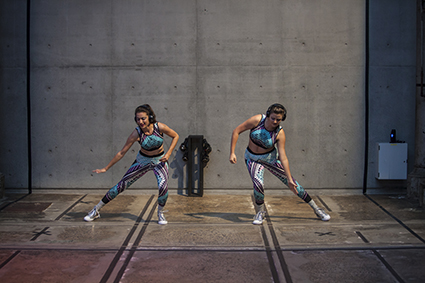
zin, Each Other
photo Alex Davies
zin, Each Other
Making fun art calls for serious motivation. Like Hissy Fit’s I might blow up someday, zin’s Each Other crossed from the world of performance art to the world of music. Clad spectacularly in neon Lycra and silver Converse wedges, artists Roslyn Helper and Harriet Gillies bust choreographed moves to music only they hear on noise-cancelling headphones. This starts a guessing game—are they listening to Michael Jackson? Beyonce? After a while, zin venture out from their dance floor, offering headphones to the crowd and dragging punters into the music zone. The new players learn zin’s dance moves on-the-go, in what we see as a silent disco world, until the song wraps, the tiny dance floor is evacuated and the game starts afresh.
This hybrid space—not quite live art, but experimental work between definitive genres—is a dangerous arena for artists to explore but the cliff-like risk of failure is what can make a work exciting. As with Hissy Fit’s I might blow up someday, Each Other showed that inhibitions can only be lost in a large crowd and that it’s intrinsically hard to turn art-goers into participants. The issue for zin became one of scale and mass: forgetting yourself and embracing your inner dancing queen as a pair or in a posse of just six dancers is a tough call. In some vital way, Each Other was less captivating than the things it naturally referenced—flash mobs, silent discos, the No Lights No Lycra one-hour pitch-black dance parties—because of the small number of participants. Rather than allowing people to break free and lose themselves in the rhythm, the fact that audience members were on show rather than immersed in a crowd and a space [Carriageworks foyer] much larger than themselves created a self-conscious spotlight.
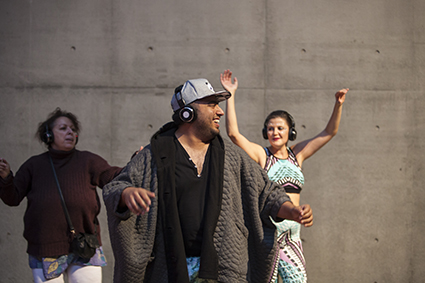
zin, Each Other
photo Alex Davies
zin, Each Other
I didn’t understand Each Other until I dived into it. For a couple of hours I watched zin pull reluctant audience members from the crowd—including a number of shy performance artists. When I finally relented, donned the headphones and joined the team, I found that they’d created a genuinely fun and interesting art project. The music turned out to be Mirrors by Justin Timberlake, a shimmery work of shamelessly feel-good pop—a pretty perfect choice, particularly given the fact that Gillies and Helper were mirroring each others’ moves. A graduate of 90s boy band N*Sync, Timberlake is the kind of pop artist whose work embraces pure danceability at the expense of any self-examination. However Each Other is less interesting to watch because, objectively, most people are terrible dancers, despite the accessible nature of Caroline Garcia’s modest choreography.
Watching zin perform the same moves for almost three hours did induce admiration (the duo were residents in Marina Abramovic’s Kaldor Public Project earlier in the year). But the real act of endurance turned out to be waiting for audience members to down enough drinks and summon the courage to join in. The experience didn’t appear to be happiness itself or the heroin euphoria of a 2am dancefloor; rather, Each Other engaged as it intended, to create fun.
Performance Space, Liveworks Festival of Experimental Art, zin, Each Other, artists Harriet Gillies, Roslyn Helper, choreographer Caroline Garcia, Carriageworks, Sydney, 22-31 Oct
RealTime issue #130 Dec-Jan 2015 pg. 18
© Lauren Carroll Harris; for permission to reproduce apply to realtime@realtimearts.net
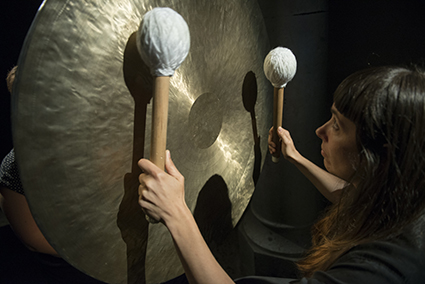
Wall of Sound, Bree van Reyk
photo Amanda James
Wall of Sound, Bree van Reyk
A friend confirms Wall of Sound doesn’t go for an hour as listed on the schedule, only five minutes, but that it’s one-on-one so I need to get my name on ‘the list.’ Staff have the list and it’s somewhere around the back, in a corridor, near the toilets. Off I toddle, past the kinbaku/shibari (erotic arty rope-tying installation) by Garth Knight and into the recesses of Carriageworks. I pass the bathrooms and hit a dead end, but hear a gong rumbling and, beyond a sign I can’t read because it is so dark, I see van Reyk from behind giving a private performance for someone (well just their shadowed legs) seated on the opposite side of her huge hanging gong. It looks personal and saturated with soft and loud sounds. Was this where ‘the list’ keeper would emerge? I waited, fumbled, then retreated.
Moments later I was back around the front, mystified by the symbolism of the rocks and female body suspended in Knight’s pagan, Celtic, tree-design—his stated homage to the collective consciousness—and waiting for my few minutes on the shadowy side of the gong. Staff suggested I leave my bag and phone emphatically off in the long dark corridor that led to van Reyk’s shiny edifice. I ditched the handbag and didn’t think of it again until the trek back to the disciplinarians (both the bondage display and collectors-of-worldly-possessions).
There was a stool and Chinese wind gong and van Reyk now in shadow. I sat with my face only centimetres from her bronze structure. I had seen her hands resting delicately on her lap so I did the same. Her mallets had huge white woollen heads and the sight of them made sense of the sounds I’d followed behind the toilet block. Her quiet precision, her patience in delivering the same experience time and again for each of us—encapsulated in the poise of her resting mallets—made me self-conscious about my shoes. That was all she knew of me and they were scuffed and old. I wondered if that’s how she’d decipher the right mood for our interaction: were my last-season, holey beige boots the score? She lifted her mallets and I flicked my brain to silent mode.
It started soft—like a singing bowl’s rim brushed without perceptible sound for a few rounds—and built. Visually stunning, the gong gyrated while flapping forwards and back, yielding the sensation of being pushed off-kilter on a swing. Bronze looked gold in that light and, cast in concentric circles like tree rings, introduced another layer of naturalness to playground reminiscing.
By reducing variables in performance, van Reyk’s simplicity ripened interest. It was immersive and intimate. In defiance of the good usher’s tip to ear-block if needed, I leaned in close to the swaying gong as things heated up—I wanted that ‘felt sound’ promised by the brochure, like the kind I heard in Ryoji Ikeda’s Superposition that dares you to go still a decibel higher without flinching. But it was just right. Her gong, more than a divider and a conduit, was a living sculpture we fed—Bree van Reyk with her actions and me by eager attention.
Performance Space, Liveworks Festival of Experimental Art, Wall of Sound, artist Bree van Reyk, Carriageworks, Sydney 23-29 Oct
RealTime issue #130 Dec-Jan 2015 pg. 18
© Felicity Clark; for permission to reproduce apply to realtime@realtimearts.net
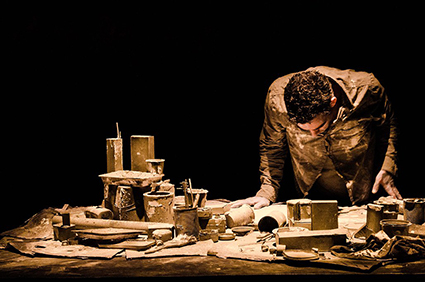
Muscle Mouth
photo courtesy Liveworks, Performance Space
Muscle Mouth
As great a shame as it is that the performances by New Zealand company Muscle Mouth for Liveworks had to be cancelled due to an injury, it is somehow fitting that a work which explores creative process so intently should be represented in another format where process is exposed. We join dancer and company director Ross McCormack and producer Melanie Hamilton for an open conversation about the processes and intentions that formed the work, and see two excerpts from Triumphs And Other Alternatives performed by dancers Emily Adams and James Vu Anh Pham.
Hamilton describes Triumphs as an exploration of the obsessiveness of creative practice and the creative drive to perfect it. It grew out of a residency in Wellington when the then team of four piled a load of plaster, plastic and other materials into a space. McCormack spent the better part of a day “mumbling and building” in the midst of it; fumbling, aiming to create nothing in particular, but aiming to be obsessive.
A muscular knot of bodies stretches on a table in a rubble-strewn workshop space. A lump of clay with two heads that is pulled apart, pressed together, reconfigured in different ways. Discoveries are made: a hand happens upon a neck and investigates—analogous to that moment of discovery in art-making when working persistently with a material reveals an unforeseen possibility, or an answer to a question.
There is the strong sense, most of the time, that the bodies are being moved from outside. Limbs are resistant but pliable. When the knot comes apart, Adams plods with a thick, muddy materiality, while Vu Anh Pham spills and rolls across the floor with a continuousness that suggests rubber or water—as if you might have to keep gathering his mass back together with both arms to keep it from running in all directions.
But these bodies are not just material. Both dancers slide back and forth on a continuum as if moved by some external force, and energised from within. The subject/object question plays itself out on their faces, too, in expressions that loop rapidly through almost caricatured extremes. The sharp intake of Adams’ breath can sometimes be heard over the deeply reverberating soundscape. All this points to the elusive subjectivity inside ‘matter’ and raises questions about the implications of creative practice for ‘inanimate’ materials. What might these materials be experiencing under the force of human hands and human consciousness?
McCormack and Hamilton talk about their desire to foster ambiguity in this work, which lends itself so well to metaphor. One strategy for doing so has been to expand their usual cast of one dancing body to three. Interestingly, in this performance lecture, the three danced parts have been compressed into two: the original piece has been reconfigured to show something of the “essence,” said Hamilton, of the full work, including those parts that the injured McCormack could not perform. This last-minute rearrangement perhaps pulls the work into even deeper ambiguity. It also beautifully reflects the work’s theme of constant revision in creative practice. Unable to perform Triumphs and Other Alternatives, Muscle Mouth reinvented it.
Liveworks Festival of Experimental Art, Talk, Muscle Mouth, Triumphs and Other Alternatives, Carriageworks, Sydney, 30 Oct
RealTime issue #130 Dec-Jan 2015 pg. 19
© Cleo Mees; for permission to reproduce apply to realtime@realtimearts.net
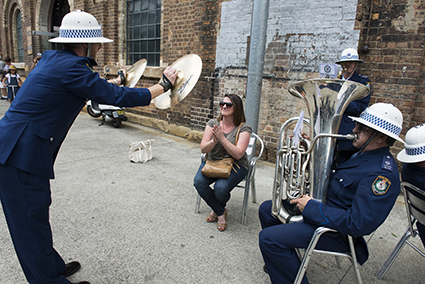
No Performance Today, Bree van Reyk & Lauren Brincat and New South Wales Police Band
photo Amanda James
No Performance Today, Bree van Reyk & Lauren Brincat and New South Wales Police Band
Do you remember the last time you were excited to see a police band? They’re in parades, public remembrance ceremonies, Olympic openings, but if advertised would you go to a concert of theirs? Perhaps at the Tweed Heads Casino if your grandparents were going, but it’s unlikely to be top of the list. That is unless you’re Lauren Brincat and Bree van Reyk, many-time sassy collaborators. Brincat is known for using drum-kits in her projects. She’s added long stilt-extensions to a drum-kit’s legs; in Drum Roll she steamrollered a drum-kit; and in Live When I’m Alive, Sleep When I’m Dead (no.1) she buried one. Van Reyk is a percussionist with mad drum-kit chops so they pair well. No Performance Today had no drum-kit but a hardy percussion section from the New South Wales Police Band.
The gals both love marching bands, so set out to make this stiff and anachronistic type of musicking engaging by warping its context. No Performance Today is a “choreographed sound portrait” that unravels the brass band uniformity. It’s like Charles Ives time-travelled with a whole marching band in his time-machine-contraption’s trunk. The band comes and goes, merges, diverges, being sensible and silly.
I saw the Friday evening performance inside Carriageworks’ massive echoing foyer, but on Saturday morning the band marched amid unsuspecting Eveleigh Markets shoppers in that bustling public space of designer lettuce, bespoke jams and hang-over-curing coffees. In that setting the performers interacted more whimsically with the public.
Inside, the police band appeared in full swing from out of a humble corridor in perfectly pressed blue uniforms with badges, polished shoes and white hard-hats. Their marching feet lifted and lowered at roughly the same time, but each leg’s trajectory was different, so out-of-synch that it was miraculous when they moved as a unit—both loose and unified.
Brincat and van Reyk wanted to ‘free’ the individuality trapped within this generic battalion. Personalities surely shone through. The bass clarinettist had a sense of humour, passing out musical quips to colleagues and lobby loiterers. The curators prescribed Louis Andriessen-like fragments to the players, suggesting each should be played with erratic phrase-bending at voluntary time-intervals.
Booming brass filled the foyer, commanding attention and obliterating our wine-fuelled conversations. From the chaos of their free-form wandering, the group united in formation on the top balcony to perform a more orchestrated section. Fraught with suspension, this music was triumphant and characterised by slowly morphing long notes. The conductor looked very serious and this confused us, but we played along: “Is this how it’s meant to sound or is he putting on a brave face while they’re all ‘out’ because of the reverb in this giant space?” It yielded a great dissonance (not sonic, but conceptual), accentuated by the perfection we attribute to such a meticulous genre. The band wilfully ‘sounded bad’ to challenge perceptions of band music, even though it was clear they were all exceptionally professional in their ability to follow wonky orders.
Performance Space, Liveworks Festival of Experimental Art, No Performance Today, directors Lauren Brincat, Bree van Reyk, NSW Police Band, Carriageworks, Sydney, 6-7 Nov
RealTime issue #130 Dec-Jan 2015 pg. 19
© Felicity Clark; for permission to reproduce apply to realtime@realtimearts.net
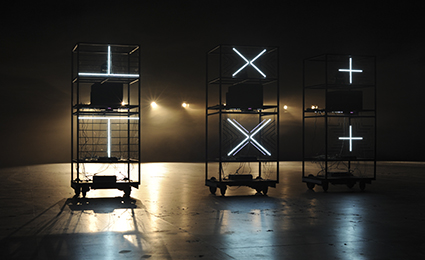
Robot Opera, Wade Marynowsky, Liveworks Festival, Performance Space
photo Heidrun Löhr
Robot Opera, Wade Marynowsky, Liveworks Festival, Performance Space
A row of eight standing rectangular frames appears at the end of the darkened auditorium, each emitting with strong LED light a pair of abstract geometric characters. The sound roars. The robots stand still as the characters flash and flicker; perhaps talking to each other in some alien robot language. The sound itself ripples as well. The robots wait as the sound forms into a martial beat at high volume, flickering characters matched by flickering sounds. They wait a few moments and then one robot rotates itself slightly.
At first they begin to move forward so slowly that you don’t notice. The activity of the characters decreases while on two of the frames a bright red light shines towards the rear. As the frames advance at a slow walking pace they follow individual trajectories and the audience moves forward to meet them.
These frames, about a metre square and two tall, are the robots. There are five shelves in each frame for the equipment which includes motorised driving wheels, an Arduino microcontroller and two motor driver circuit boards, a woofer speaker box under which is a Kinect depth sensor and a laptop facing the rear. On the top shelf is an infrared camera and a bright red lamp that spotlights the audience, with their images appearing on the laptop screens.
The sound becomes more subtle as the performance continues. The roar grows more self-modulated, with vocalisations in hard-to-interpret heavily phased single words, striking out into the space.
Marynowsky has abandoned the stately robots of his earlier work The Hosts and returned to a raw functional object that does not hide the hardware laid out on its shelves. They are disarming since they appear more like lab furniture than what we have come to expect. There is nothing approaching trunks, legs, graspers or heads. They show a medium level of autonomy. Each frame is equipped with sensors on the front and rear which stop the movement of the robot if it comes too close to a member of the audience or a wall. They move back and forth, pirouetting at various moments as the audience follows them across the floor or gets out of their way. The overall control of the choreography is via wi-fi from the master control laptop.
I call these robots lab racks because Marynowsky has dispensed with all notions of the humanoid robot or the 18th century automaton. Not controlled by mechanical levers and cogs, although the motorised wheels allow movement, they appear to possess some autonomy. But much of that is driven by the robot operators, Marynowsky and colleagues, tightly choreographing for their overall activity within the arena.
A group of delighted kids are the first to come into the arena and approach these well-behaved robots which seem to pirouette for approval, showing off their equipment. Of course the kids are of a generation for whom robots will seem a part of the everyday. Now the robots go their separate ways, mixing it with the audience: following, backing away, circling and generally wandering about as they take photographs of us which they show on their screens.
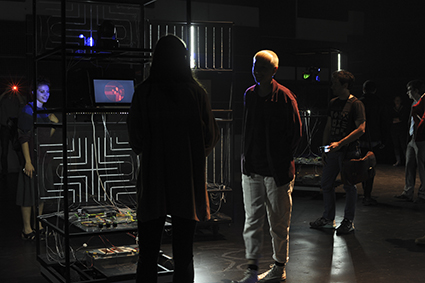
Robot Opera, Wade Marynowsky, Liveworks Festival, Performance Space
photo Heidrun Löhr
Robot Opera, Wade Marynowsky, Liveworks Festival, Performance Space
To what extent are these robots autonomous? Autonomy, at minimum, allows the robot to sense and navigate a fluidly changing environment, in this case a room full of people also navigating their ways around the robots. This sensing produces a feedback loop between the robot and its environment so that it can recognise the consequences of what it does. A non-autonomous robot will only produce outputs and will input nothing about effects.
In conversation with Edward Scheer (Liveworks, 31 Oct), Marynowsky detailed the modes of robot behaviour: “There’s a manual mode and there’s an autonomous mode. We call [the latter] ‘Avoid and Wander.’ It uses a laser scanner to avoid obstacles and people. There’s also another behaviour called ‘Follow’ where it moves after people depending on their x-y position within the space. So they’re the two main behaviours, they’re the two with safety mechanisms, as you might call them.”
In the finale the sound begins as a thick self-modulated chord and the robots realign themselves into allotted spaces marked with crosses on the floor. There they stay as the music plays out and the audience applauds, generously. Meanwhile the mob of kids sitting on the floor at the rear of one of the robots chatter excitedly. For all of us it’s a very satisfactory half hour or so.
The performance is not an opera. Yes, it is a gesamtkunstwerk, a total artwork involving the gathered artforms—a synthesis of sound and light and mobile robotic behaviour threaded in among a fluid and actively interested audience. The music is grand and imposing, there is no stage as such and no stage effects. Lighting is used to illuminate not to trick the eye. It changes in mood, following the robots’ progress and is echoed in the music. Without a star, a lead robot, the audience is completely central to the performance. Even though there is some oversight by the operators, the audience mingling with the robots provides a level of stimulus that affects each robot.
–
Performance Space, Liveworks Festival of Experimental Art, Robot Opera, artist Wade Marynowsky, music, sound design Julian Knowles, lighting Mirabelle Wouters, dramaturgy Lee Wilson, electrical design Ben Nash, programmers Imran Khan, Adam Hinshaw; Carriageworks, Sydney, 28 Oct-1 Nov
RealTime issue #130 Dec-Jan 2015 pg. 20
© Stephen Jones; for permission to reproduce apply to realtime@realtimearts.net
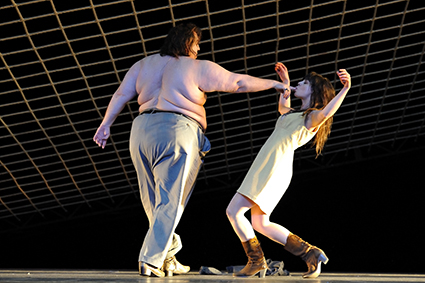
Woyzeck, Thalia Theater Hamburg
photo Krafft Angerer
Woyzeck, Thalia Theater Hamburg
Having foregone the pleasure of a conventional launch with all its speech-making in favour of opening the festival well in advance with the Peter Sellars production of Toni Morrison’s Desdemona, Sydney Festival Artistic Director Lieven Bertels is in fine form, elaborating on the works in his action-packed 2016 program. He’s proud of having persistently brought live music into theatre and dance productions, giving local companies international opportunities and bringing classical music back into the festival. Contemporary classical has done well too; he thinks festivals are ideal for introducing it to a wider audience.
Bertels is particularly pleased to be bringing Hamburg’s Thalia Theatre to Australia for the first time—it travels rarely in Europe and its production of Georg Buchner’s Woyzeck has so far only played once outside Germany. He thinks Thalia one of the country’s top three theatre companies. After the success of The Black Rider in the Sydney Festival of 2005, and as part of a festival reflecting on the achievements of his forebears, Bertels wanted to bring Woyzeck, another of the Tom Waits-Robert Wilson-trilogy (Time Rocket is the third), but chose the new Thalia version by a young female director Jette Steckel. Spoken in German and sung in English, the production is strikingly designed and cast and is accompanied by live music.
Belgium’s Rosas makes its second appearance in Sydney after last year’s Carriageworks’ season. This time De Keersmaeker is re-mounting and performing one of her classic works, Fase, to the music of Steve Reich. It’s an engrossingly lyrical work and quite different from her current more open-ended choreography which will be represented by Vortex Temporum with the music of ‘spectralist’ composer Gerard Grisey played live by Ictus. Bertels says, “Each musician is matched with a dancer who, essentially, dances out a musical line.”
Bertels is presenting Beethoven’s nine symphonies, eight in “the perfect acoustic of Angel Place” and the ninth, for large forces, at the Opera House. It’s not a conservative choice: “playing with period instruments is like stripping away layers of varnish on an old painting; it’s extremely dynamic.” A different kind of engagement with classical music comes in the form of Schubert’s Wintereisse sung by the great German baritone Thomas Goerne with animations by the South African artist and animator William Kentridge.
A fan of Sydney Chamber Opera, Bertels offered the company the opportunity to work with Pierre Audi who has directed in the major opera houses of Europe and New York’s Metropolitan Opera and whose impressive account of Monteverdi’s The Return of Ulysses featured in the 1999 Sydney Festival. “I asked Audi if he’d like to work with a bunch of young people who graduated yesterday and have great international potential, and he said yes.” The SCO’s Artistic Director and conductor Jack Symonds will be flown to Amsterdam to rehearse two young singers in the chamber opera Passion, with its Orpheus and Eurydice scenario, by Pascal Dusapin, a much-honoured French composer. Composer and company unite again for O Mensch (see below).
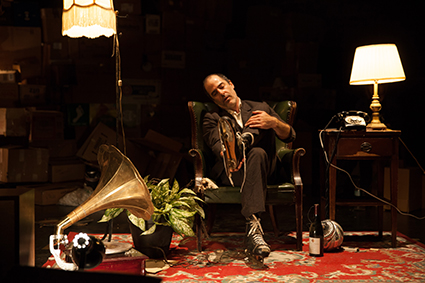
Geoff Sobelle,The Object Lesson
photo Max Gordon
Geoff Sobelle,The Object Lesson
In Sydney Town Hall, New York artist Geoff Sobelle will mount a fascinating installation of huge cardboard cabinets with a multitude of drawers full of personal objects which he introduces to a participating audience equipped with pencils and paper. Canada’s Mammalian Diving Reflex, of the acclaimed Haircuts by Children, take participation to another level with a group of over-65 Sydneysiders reflecting on their sex lives in All the Sex I’ve Ever Had. The Events [see p25 Adelaide Festival], a work by Scottish playwright David Grieg about post-traumatic stress will be staged in the Granville Town Hall, which is apt says Bertels, not only because of the 1977 Granville train crash but also the “rehearsal space feel of the hall.” Each performance involves a different local choir.
Participation of another kind, hands on, will take place at Barangaroo in Olivier Grossetete’s The Ephemeral City (France) with audiences helping construct for an hour, a day or three weeks, monumentally sized buildings out of cardboard boxes in the cutaway beneath the park safe from Sydney’s intense summer heat and likely rain. “Olivier choreographs the assembling and movement of the buildings with participants, so it’s a project in urban planning.” An outdoors version, The People’s Tower, will be mounted over three days in Darling Harbour: “Half the fun is in tearing that one down,” laughs Bertels. The backdrop to the Barangaroo installation will be a huge Shaun Glaldwell video triptych on the rock wall of US champion skateboarder, Rodney Mullen, who, about to retire (“I can’t break another bone in my body”) responded to the artist’s request to be filmed skateboarding on great minimalist public sculptures.
Lieven Bertels’ festival is full of inviting works, too many to detail here. You should think about seeing some of the following. A video installation at UNSW Galleries has recorded the journey of a piece of Carrera marble shipped from Italy to China where it’s turned into a column by Chinese craftsmen and then chipped into classical form by the Albanian artist Adrian Pacj on an open deck on the return trip. Says something about globalisation.
In the huge music program Mexican musicians Mexrrissey perform Morrissey miserabilism with wit, conviction and bad translations, says Bertels; NY’s Peter Gordon reforms the band that played with the late lamented and quietly influential Arthur Russell in the 1970s; Meow Meow manifests as the Little Mermaid; American jazz soprano Claron McFadden sings the audience’s secrets in the show of that name; Cosmic Cambodia revive and build on classic 60s Cambodian pop and rock; and British singer, hip-hopper and poet (the Ted Hughes Award, 2013) Kate Tempest performs with her band.
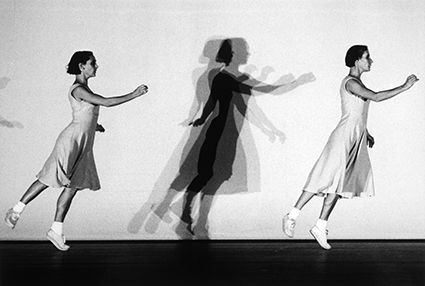
Fase, Anne Teresa de Keersmaeker
photo Herman Sorgeloos
Fase, Anne Teresa de Keersmaeker
On the performance front, About an Hour returns to its ideal venue, Carriageworks with the premiere of Melbourne choreographer Stephanie Lake’s Double Bind; Tomorrow’s Parties by Forced Entertainment; +51 Aviacion San Borja by a Peruvian member of the Japanese diaspora about ‘going home;’ Christopher Brett Bailey’s (UK) not funny spoken word reflections on the dark side of life—one for the tough-minded; Performance 4A’s In Between Two, hip Asian-Australian reflections on life here in word and song; and Sydney Chamber Opera, again, with O Mensch—21 poems by Nietzsche scored by Pascal Dusapin. Nick Power and his b*boys perform Cypher at Riverside Theatre. There’s ample physical theatre from two Brisbane-based companies, Circa and CASUS and, in About an Hour, Fall Fell Fallen by France’s Lonely Circus.
Alongside Woyzeck, Phase and Vortex Temporum, Passion and the Beethoven symphonies are the Sydney premieres of major, already applauded Australian works: the Kate Miller-Heidke/Shaun Tan/Lally Katz/Iain Grandage opera The Rabbits and Marrugeku’s Cut the Sky.
Online you can enjoy “a festival gift,” as Bertels puts it: Michel van de Aa’s engrossing, Borges-inspired, interactive video work The Book of Sands, featuring Kate Miller-Heidke. There are many gifts in this festival, from the giant participatory works at Barangaroo and Darling Harbour to the wealth of small scale innovative works to be staged from the city to Redfern and Parramatta. For sheer variety and invention it’s the best of Bertels’ four festivals.
Sydney Festival, 7-26 Jan, 2016
RealTime issue #130 Dec-Jan 2015 pg. 21
© Keith Gallasch; for permission to reproduce apply to realtime@realtimearts.net
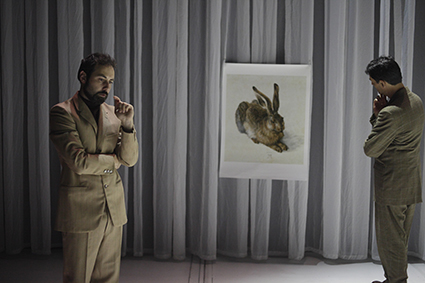
Go Down, Moses
A fully-formed human being entering the world from a shapeless, liquescent mass. A robot head reciting numbers to a baby. An Auschwitz populated by children who ride a toy train and take tea with a Mad Hatter. These are some of the images that will be familiar to those lucky enough to have witnessed the works of Italian theatre maker and artistic director of Socìetas Raffaello Sanzio, Romeo Castellucci. A former painter, Castellucci’s imagistic, richly evocative mise en scènes retain some of their fascination in YouTube clips. The effect of these works in the theatre, however, remains mysterious to me and is made tantalising by their wide-ranging documentation and discussion, as well as the awed word of mouth generated by the company’s previous appearances in Australia in productions such as Giulio Cesare in the 2000 Adelaide Festival and Genesi, From the Museum of Sleep in the 2002 Melbourne International Arts Festival. Via email, I put a series of questions to Castellucci about a new work, Go Down, Moses, which looks set to be a contemporary performance highpoint at next year’s Adelaide Festival of Arts.
Your last work to feature in the Adelaide was Giulio Cesare. What are your memories of that festival and of how the work was received by Adelaide audiences?
My memories of that voyage are a bit blurry. I recall, in any case, the abnormal kind of interest shown by the audience towards the performance. There was a strange reaction during the applause, which I remember as being particularly slow, perhaps stunned. Then, later, a huge number of people came to a debate, with me sitting behind a desk covered in boxes of chocolate, like they were on display in front of me (I think it was because of the sponsor). The audience in Adelaide clearly knew Shakespeare’s world very well, which gave them an enormous advantage in understanding the performance’s structure; they had access to the work at a profound level.
As with Giulio Cesare, Go Down, Moses uses a canonical text—in this case, the Book of Exodus as opposed to Shakespeare—as its source material. What is it about such material that holds appeal for you? Is it because their reverence makes them more powerful to subvert?
It’s not a question of subversion or desecration. If anything, the procedure used is quite the opposite. It’s a matter of using the same material to delve into language itself. Go Down, Moses is a homeopathic and linguistic kind of work. These texts, moreover, offer mythological material that is, by definition, universal and comprehensible at a ‘lower’ level.
Can you explain the significance of the title and its relationship to African-American slave history?
The topic of slavery is found throughout Exodus, like a mosaic. The song referred to in the title alludes to the need to be freed again by someone, in much the same way as the African-Americans awaited the arrival of a new Moses. And so, a young mother dreams of the liberation not of one particular group of people but of all humanity, which, according to her, has fallen into a new slavery, unconsciously and invisibly. We are still—according to this mother, who abandons her newborn child just as Moses’ mother did—slaves of the Pharaohs.
You were quoted in RealTime as saying that “Genesis frightens me much more than the Apocalypse”. What did you mean by that exactly, and what is it about Biblical themes that both inspire your work and create a sense of terror for you?
This reflection concerned tragedy, in a strictly ‘Greek’ sense. Genesis represents creation, that is, the fact that there is something rather than nothing. The fact of being is the fundamental problem. As far as Greek tragedy is concerned, the problem is that we were born, not that we must die. Creation represents possibility, the pure potential of the creative act. Here, “anything is possible” becomes a threatening statement, not one that conveys a sense of freedom or openness. Creation, in Genesis, allowed for everything, even the word Auschwitz (which was in fact the title of the second act [Genesi From The Museum of Sleep]). From Genesis originates the mystery of evil in the world and, in the end, the divine plan. The philosopher Luigi Pareyson has written remarkable things about a ‘tragic’ conflict within the sphere of the divine; but we could also simply recall Dostoevsky.
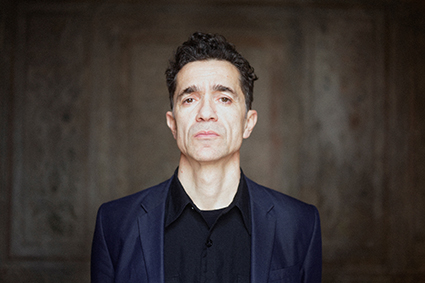
Romeo Castellucci
photo Luca del Pia
Romeo Castellucci
Go Down, Moses doesn’t contain conventional dialogue, but the text is credited to you and Claudia Castellucci. What does the text consist of, and what is its relationship to the wider work, which, like all of your work, is highly visual?
My work is dramaturgical more than textual. I use every possible tool and anti-tool: things that are to be seen and things that one cannot put into focus, vivid images and the triumph of the banal, words and silence, narration and events that do not arouse the slightest neural fluctuation. Anything is possible, as I was saying before. There is no difference. Touch is what counts the most. And I don’t have a style. Or, more precisely, my style consists in not having a style.
American electro-acoustic composer Scott Gibbons is providing the score. He is a frequent collaborator of yours. What can you tell me of his contribution to Go Down, Moses?
Since Genesi (1999) I’ve worked exclusively with him on every theatre production. He is the best composer in the world (second only to Wagner, and I mean that seriously). I feel extremely fortunate and privileged to work at his side. He is a great artist. We do not need to talk too much. We are the same in a way. We each carry the other within us.
You have worked widely with non-professional performers and those who have unconventional bodies. Will you be doing so again in Go Down, Moses?
Everything depends on dramaturgy. I’m not the one who chooses people! I might even say that it’s not my problem. The shape of bodies and their attitudes come solely from the requirements that dramaturgy imposes at any given moment. That’s all.
–
Socìetas Raffaello Sanzio, Go Down, Moses, direction, set, costumes, lights Romeo Castellucci, music Scott Gibbons, text Claudia Castellucci, Romeo Castellucci, Dunstan Playhouse, Adelaide Festival of Arts, 25-28 Feb 2016
RealTime issue #130 Dec-Jan 2015 pg. 22
© Ben Brooker; for permission to reproduce apply to realtime@realtimearts.net
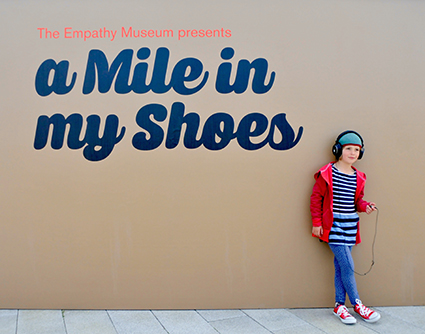
A Mile in My Shoes, promotional image
photo Kate Raworth
A Mile in My Shoes, promotional image
In enlightened programming, Wendy Martin, the new Artistic Director of the Perth Festival of International Arts, has invited curators Clare Patey and Kitty Ross and cultural thinker Roman Krznaric to stage A Mile in My Shoes, a work in which you enter a huge cardboard box, select a pair of shoes belonging to a stranger, put them on and walk a mile listening to the owner of the shoes speaking about themselves. It’s part of a larger project titled The Empathy Museum, founded in London and beginning to travel internationally. Krznaric, raised in Sydney and the author of Empathy, A Handbook for Revolution (Rider, 2014) is a key speaker at the festival’s Writers’ Week.
I spoke via Skype with Clare Patey, an artist and curator who has produced huge installations that directly engage communities and audiences in addressing the nature of their lives and environment. I ask her about the origins of The Museum of Empathy, which go back to the mid-90s in London, where she lives.
Patey says she created a series of museums “in a disused warehouse on the Southbank in London before it was such a cultural quarter. The building was owned by a property developer focused on social housing who wanted to bring life back into the area. I asked what they wanted to do with it and they said they’d quite like it to be a new museum of the River Thames. I decided that at the heart of the project would be a question about the cultural space of the museum and that the whole project should be a participatory forum of debate about what a new museum for London would look like and what people wanted of it. It didn’t happen but it created a model for an experimental museum.
“The first was a Museum of Collections, looking at the psychology of collecting. We invited 42 locals to display their collections—toast racks, cheesy record covers, rejection letters (!), Dolly Parton items, snow domes, coins, ties and 15,000 Kinder toys—all catalogued. We interviewed each person in their home about their collection and what it meant to them and, with a theatre designer, asked them how they’d like their collection shown. We built Dolly Parton’s living room to show that collection.”
I asked about what the museum did for the collectors. “It put them in touch with each other” and raised issues about “when is a collection complete and how do you pass it on and what does it mean when transferred to a museum?” As Patey points out this is critical for any museum object, not just those from everyday collections.
Sharing and participation are elementary to Patey’s practice, if not at the time central to the Museum of Collections, but even then there was a wall dedicated for visitors to make their own contributions to the overall collection—“a love poem in Hungarian; instructions on how to reverse park… We were experimenting with ideas of agency in the audience which became central to subsequent shows.” Next was the Museum of Me, in which the public collected in cans their responses to artworks and observations about themselves in answers to questions—35,000 in the end, time capsules of exhibitions of the self in the year 1999. Then came the Museum of The Unknown (identifying mysterious objects), The Museum of Emotions (with its spaces in which to scream, sigh, feel love and lust and traverse the seven stages of grieving) and eventually, The Museum of the Thames, the overall series taking five years up to 2001 and providing the foundations for the Museum of Empathy.
After the museums project, Patey worked with LIFT [London International Festival of Theatre] on two shows, one of them, Old Dog New Tricks, testing proverbs. The one thing she couldn’t do in the series of caravans that housed this show, she says, “was put a bull in a china shop.”
Patey then went on “to work a lot with food.” A year-long project involved “an allotment, a primary school, chef, gardener and five artists growing and cooking to create an alternative school dinner. It was tied to key in with all areas of the school curriculum. It was like an outdoor classroom. The quality of conversation and the physical acts—and this has to do with empathy—of planting, weeding and harvesting frees you up for a different quality of conversation. Some children didn’t know a carrot came out of the ground—‘Disgusting!’ But later said, ‘I’ll have the beetroot.’” Patey comments on how we’re increasingly aware of the origins of food, but not of consumer items like clothing and furniture.
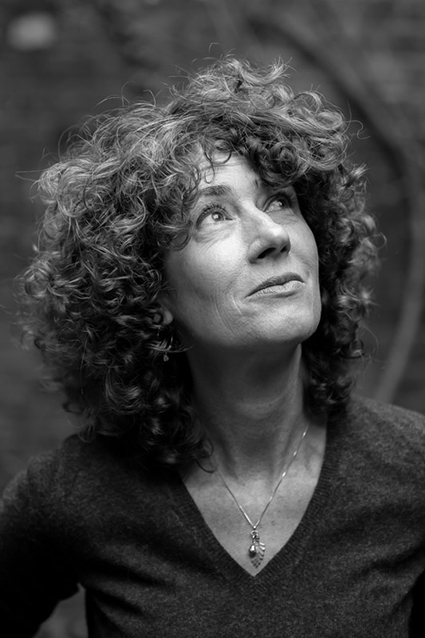
Clare Patey
Out of this project, starting in 2007, came Feast on the Bridge with the Thames Festival, another year-long project, this time “growing food in allotments, urban gardens and schools. The festival got permission to close a bridge on the river. We lined up banquet tables on it, collected 5,000 food stories from Londoners and illustrated them on tablecloths. The project brought together farmers, ethical food producers, foragers, artists, herbalists and campaigners to explore the whole food narrative, from the soil to growing and eating together and the waste cycle —composting workshops, worm farms, anaerobic digesters…We collected the waste in golden wheelbarrows. Three thousand people sat down and ate together.”
A very busy Patey has also been involved in work around environmental issues, creating The Ministry of Trying To Do Something About It with the New Economics Foundation think tank, stemming a feeling of public helplessness by issuing carbon ration books, based on those of World War II Britain, in a campaign titled Ration Me Up (2009). Patey explains that the book “showed if you were living within your fair global share of CO2 and how to adjust when buying socks or getting a flight to Sydney from London.” She also made a TV program, Our Human Footprint, about the amounts of materials an average British person consumes in a lifetime. I mention paper production and Patey laughs: “The average British family is more likely to have two cars than two books!”
Clare Patey met Roman Krznaric “when working on environmental projects and he’d been to The Museum of Emotions. After he wrote the book he wanted to bring its ideas onto an experiential plane.” Therefore, A Mile in My Shoes is “fitted out like a shoe shop, but with the names of the owners on the boxes. If you don’t know your size, then your feet are measured. In London we had 30 pairs and we’ll add another 40 in Perth. We’re collecting more for British Health and for shows in Beirut and Brazil. Maybe we’ll connect with climate change and refugees, and we’ll be online soon.”
In London, Patey employed 15 audio producers, mostly from radio, to record the stories from a community including “a sewer worker, lifeboat operators, suicide watch staff, a hospice operator, a drag queen, a chess grandmaster and an ex-prisoner who’s now an artist. They just tell personal stories.
“The choice of shoes depends on the sizes available, but a few visitors imagine they’re in a real shoe shop: ‘Have you got these in a red or with a bit of heel?’ Some men are offended by the prospect of wearing the drag queen stilettos which are size 11—which I couldn’t walk in—but a dad in his 50s with his family took to them.” The sewage waders apparently worried some wearers. Feedback comments indicated that people felt they’d got to know the shoe owners, some would have liked to meet them—‘Where is their flower shop?’ For others the experience enabled them to reflect on their own lives, thinking about the hospice and ‘what is a good death?’ Conversations would break out, says Patey, when people returned from their walk. She recalls one night just before closing, two young interns on their way to being surgeons discussing how they’d had to necessarily reduce empathy during their training and were thinking about how to build it again.
Patey explains, “I’m not claiming to totally transform anyone’s life but there’s something about being on a physical journey while you’re on an emotional one and inhabiting that person’s shoes that makes a difference. You find yourself walking and looking down and they’re not your shoes…”
A Mile in My Shoes is the first of a series that will eventually become a fully installed Museum of Empathy, “conceived like a kind of high street as an antidote to the homogenisation of consumerism and high street culture. It will have a library, café, shoe shop, undertaker, gym, laundrette and travel agency.”
Clare Patey is currently working on a project titled Edible Utopia and also with Tipping Point, which addresses cultural responses to climate change. It involves “a group of structural engineers to build an inside-out house,” she says, laughing, “to reveal all the infrastructure that goes into it.”
Perth International Arts Festival, The Museum of Empathy, A Mile in My Shoes, curated by Clare Patey and Kitty Ross in collaboration with Roman Krznaric, Stirling Gardens, 18 Feb-6 March; Roman Krznaric, Writers’ Week, Octagon Theatre, Perth, 18 Feb; www.empathymuseum.com
RealTime issue #130 Dec-Jan 2015 pg. 23
© Keith Gallasch; for permission to reproduce apply to realtime@realtimearts.net
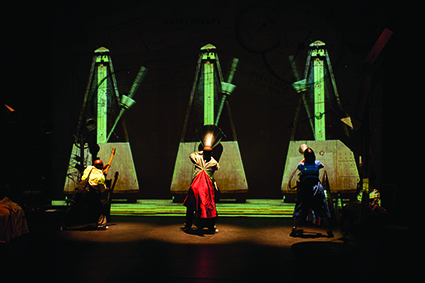
Refuse the Hour, William Kentridge
photo John Hodgkiss
Refuse the Hour, William Kentridge
Wendy Martin, the new Artistic Director of the Perth International Arts Festival, wanted for her opening event a sense of place, of Western Australia rather than the usual European spectacles, although she thinks they’re great. WA, she says, has a wealth of talent, so for the event, titled HOME, she’s appointed large-scale events artist Nigel Jamieson to direct with Iain Grandage, Lucky Oceans and Wayne Freer working on the music, Zoe Atkinson on design and Sohan Ariel Hayes on media art. The focus is on how WA artists evoke a sense of place with the event to be opened with a very special Welcome to Country by storyteller and virtuoso didjeridu player Richard Walley, associate director of HOME. A sense of place, of one’s own being and of others intelligently and aesthetically pervades the 2016 festival program.
One of the festival centrepieces, Refuse the Hour is a live version of William Kentridge’s The Refusal of Time which appeared as an installation in the 2014 festival. I wrote then, “It’s a huge work occupying the whole of the main PICA space with five screen projections (filmmaker Catherine Meyburgh) on three walls of Kentridge’s animations and staged performances (choreography Dada Masilo) with enveloping music (Philip Miller) and dramaturgy by physicist and historian of science Peter Galison. I was taken in particular with the costuming (touches of Bauhaus inventiveness), dancing and transformations in the strange domestic scenes, as well as with the overall sense of time in and out of synch, measured against the stars, the beat of metronomes and the epic march of shadows of human beings bearing goods and possessions and led by a hauntingly scored brass band” (RT120, p17). Martin’s favourite moment in this live incarnation is “a phenomenal duet in which Berlin-based Australian Jo Dudley sings in reverse the words she’s just heard from a woman in the Soweto Choir.”
If Kentridge seduces us with his fantasia into reflecting on our relationship with time (and always with a South African political dimension), in Apocrifu, Belgian-Moroccan choreographer and dancer Sidi Larbi Cherkaoui, exploring the great religious and philosophical texts, wants us, says Martin, “to see that these can sit side by side and create beauty without having to be in complete agreement.” His expression of this is realised by Cherkaoui himself, a Japanese classical ballet dancer, a French contemporary dance and circus artist and the Corsican choir A Filetta—“singing to die for,” claims Martin.
If reflecting on others’ values is central to improving human relationships, there are works in the festival that focus very specifically on the bodies and feelings of others. You can read about the The Empathy Museum’s A Mile in My Shoes (UK) on page 23; it’s an experiential work for audiences created by Clare Patey and Kitty Ross with cultural thinker Roman Krznaric, author of The Empathy Revolution and opening speaker at the festival’s Writers’ Week. Also from the UK is Claire Cunningham whom Martin worked with on London’s Unlimited Festival of Disability Arts. “She’s a great artist and a great thinker,” says Martin of the Scottish artist. “She’ll present Guide Gods, which I commissioned for the Glasgow Commonwealth Games. It’s a dance theatre piece exploring the views of the world’s major religions on disability which began when she met a Buddhist monk in Cambodia who suggested she was disabled because of karma. It’s only performed in places connected with religion. She’ll also perform Give Me a Reason to Believe, her solo response to the works of Hieronymus Bosch and his depiction of the disabled—it’s an investigation into empathy.” Cunningham will also run a week-long workshop for artists from across Australia during the festival. Martin has a four-year strategy for the festival to work with DAADA (Disability in the Arts Disadvantages in the Arts, WA).
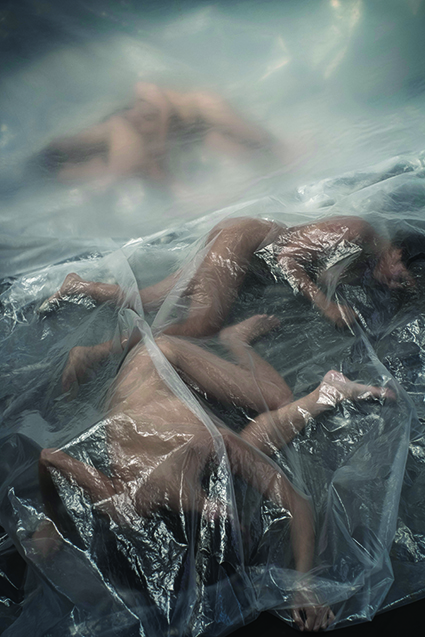
Pindorama, Lia Rodrigues
photo Sammi Landweer
Pindorama, Lia Rodrigues
Depression is the subject of Every Brilliant Thing by British writer Duncan Macmillan and performer Jonny Donahoe, both geniuses says Martin, who was so moved by the performance that she thanked the actor for being so brave, to which he replied, “It’s not my life.” The work drew on interviews with sufferers. “It’s staged in the round and is very intimate and welcoming, like a conversation,” Martin explains, “and is funny, but deeply affecting.”
The need for understanding across cultures has never been so critical as ignorance—and its offspring, racism and sexism—increasingly threatens to undo democracy. Another work that will open audiences to the complexities of the lives of others, and our kinship with them is Common Wealth’s No Guts, No Heart, No Glory (UK), created by Bradford woman, Evie Manning, who directs the work and writer Aisha Zie. Twenty-eight years old and living next door to a Muslim woman with 11 children,” says Martin, “she asked her how she managed given that she herself could barely cope with one child. The woman said ‘come to the gym with me.’ It was full of Muslim women learning how to box to build their self esteem and being in the world. Evie interviewed girls 16 to 23 years of age including a woman who is the UK University Boxing champion. The performers are mentored by a Pakistani woman who’ll represent Britain in the next Olympic Games and has trained them in technique and how to feel confident and speak about their lives. No guts… will be staged in a Perth boxing gym. Evie’s staying on for 10 days to work with marginalised people towards a new work we’ll commission from her.”
WA dancer James Berlyn has crafted a fine live art repertoire including the 2013 work Crash Course, a surreal language lesson. In this festival he’s presenting and performing I Know You’re There, which Martin describes as “a beautiful personal story about his family and when something you thought was true no longer is. He builds the set out of recycled paper—it’s an understated ecological message—dances and engages the audience in conversation. You can choose to join in or not. It’s in the round and very intimate.”
The great kathak dancer Aditi Mangaldas, from India will present with her dancers two works on the one program. The first, Knotted, is a bold response to the December 2012 gang rape of a young woman left for dead, “not a direct response,” explains Martin, “but about the effect.” The second work, Unwrapped, a display of classic kathak accompanied by harmonium and vocals, will doubtless be riveting.
In Plexus, French artist Aurélien Bory will install Japanese performer and circus artist Kaori Ito in a beautiful cage of 5000 elastic cords in which she’ll be reduced to the role of puppet though seeking to escape as we watch, listening to the amplified movements of her body in the musical score.
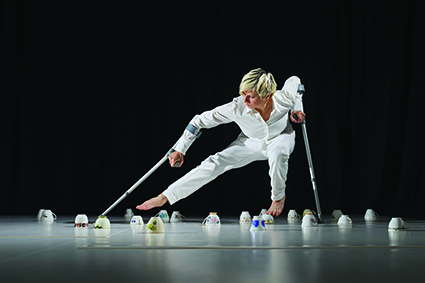
Guide Gods
photo courtesy Perth International Arts Festival 2016
Guide Gods
“It’s one of the most visceral works I’ve experienced, and the most visceral in the festival,” says Martin of Lia Rodrigues’ dance work, Pindorama, “which is the name of Brazil before colonisation. You enter a black space, you’re standing, a huge transparent tarp is unrolled. As it is moved by naked performers it becomes a raging sea, the sound of the storm coming only from its movement, of water against plastic, and you become one of the performers.” This work about danger, survival and cooperation is inspired by ancient ritual with which to meet current social and political challenges; Rodrigues recently moved her studio to Maré, one of the largest favelas in Rio de Janeiro.
There’s much more to Martin’s festival—Meow Meow as The Little Mermaid, PVI’s Blackmarket, the premiere chamber ensemble version of Mark Anthony Turnage’s contemporary music classic Blood on the Floor at Fremantle Arts Centre, Simon Stone’s The Wild Duck and The Tiger Lillies Perform Hamlet. Martin is eager to point out too that the Festival’s Conversations program will be hosted by Ruth Little, associate director of the climate change organisation Cape Farewell (UK), writer, literary manager and dramaturg for the likes of Akram Khan and Sidi Larbi Cherkaoui, and a great interviewer.
I tell Wendy Martin I’m impressed by the emphasis on empathy in her program, always from quite different perspectives—philosophical, political, collective and individual, and always aesthetic. “I’m not telling people what to think,” she says, “but if they find the ideas, that’s good.”
–
Perth International Arts Festival, 11 Feb-6 March
RealTime issue #130 Dec-Jan 2015 pg. 24
© Keith Gallasch; for permission to reproduce apply to realtime@realtimearts.net
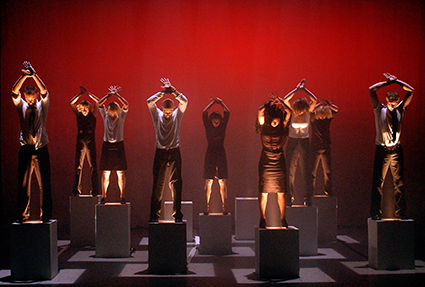
Monumental, The Holy Body Tattoo
photo Chris Randle
Monumental, The Holy Body Tattoo
For his final festival Artistic Director David Sefton is mounting some mighty works, invoking Adelaide Festivals past with Pina Bausch’s Nelken and Romeo Castellucci’s Go Down, Moses (see the interview, p22) and including his own with The James Plays trilogy, recalling Toneelgroep’s Roman Tragedies in 2014. There’s continuity too in Sefton’s adventurous contemporary music programs Tectonics and Unsound Adelaide and the presence this year of the remarkable, reclusive Canadian heavy art-rock band Godspeed You! Black Emperor.
The Holy Body Tattoo, monumental
The eight-piece Montreal band (who reappeared in 2012 after a 10-year hiatus) will stage their own concert and also accompany Vancouver’s famed dance company The Holy Body Tattoo (also back from a 10-year absence) in monumental. Nine dancers mounted on pedestals will express and battle with the psychological pressures of contemporary life with ferocious but highly articulated choreography framed by intensive visuals.
1927, Golem
From UK company 1927 comes Golem, an update of Jewish tales about a man-made creature built from clay, precursor of Frankenstein’s monster and out-of-control robots. In a melding of live performance and animation including, of course, clay, an antiquated picture book world is conjured in which a computer programmer creates a golem, but with a very contemporary difference, making the work a satire of our preoccupation with everyday technological tools. The quaint imagery won’t be to everyone’s taste and I didn’t take to the company’s artistry in Between the Devil and the Deep Blue Sea in the 2008 Sydney Festival, but many did and it’s five stars all round from UK reviewers.
Tiny Bricks, Deluge
If Holy Body Tattoo physically realise modern angst and 1927 focuses on the ills of synthetic production, Australian playwright Philip Kavanagh portrays us as succumbing to the ever increasing flood of information, which is no longer simply knowledge. He’s created “five plays run[ing] simultaneously as 10 characters attempt to find meaning and connection without drowning.” The play proposes “our brains are changing because of the media we use. We all live in The Shallows now. The trouble is human desire runs fathoms deep… Now that the deluge is upon us do we swim to each other or get swept apart in the torrents?” (Playwriting Australia, July). For those lucky enough to have seen the Malthouse-STC production of Caryl Churchill’s Love and Information (RT128, p34), with its over 100 playlets, new local company Tiny Bricks’ production of The Deluge will be another rare opportunity to reflect on the kinds of creatures we are becoming.
Stone/Castro, The Country; STCSA, Belvoir, Malthouse, The Events
Adelaide’s Stone/Castro has, unusually, chosen to mount English playwright Martin Crimp’s The Country, an acutely observed, acerbic account of middle class conversation as dangerous misinformation; doubtless the company will apply to it their own experimental vision. STCSA, Belvoir, Malthouse have come together to stage The Events by Scottish playwright David Grieg, in which the sole survivor of a mass shooting grapples with survival and loss; each performance is accompanied by a different local choir, offering a sense of community and music that consoles. Another local production, Oscar Wilde’s The Young King, by the acclaimed Slingsby, should also be on the must-see list.
ADT, Habitus
For ADT Artistic Director and choreographer Garry Stewart, it’s back to basics with none of the technology in tandem with dance which he has deployed over many years to speculate on our natures. The performers will dance with and manipulate books, furniture and household appliances to create a new view of of “the vast complexity of a living ecosystem.” I recall from the Adelaide Festival in 2008, being astonished by Moving Targets (RT 84, p10) created by German playwright writer Marius von Mayenburg, director Benedict Andrews and their actor collaborators who messed with a sofa, other bits of furniture, their bodies and clothing to create an anarchic but somehow cogent world of feeling and endless invention. Stewart’s vision should be very different and dancers’ bodies speak in other ways, but I look forward to making comparison.
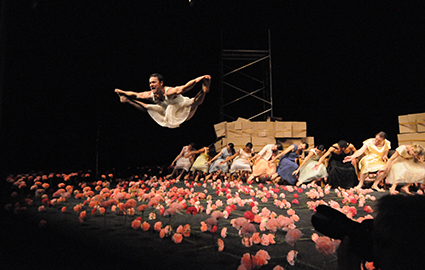
Paul White (foreground) and Tanztheater Wuppertal, Nelken (Carnations): a piece by Pina Bausch
photo Alexandros Sarakasidis
Paul White (foreground) and Tanztheater Wuppertal, Nelken (Carnations): a piece by Pina Bausch
Pina Bausch, Nelken (Carnations)
Who needs prompting to see Nelken, performed by a company like no other: 20 performers bearing a great legacy and dancing on a field of silk carnations to the music of Schubert, Lehar and Gershwin played on accordion? Enough said.
The James Plays
A co-production from the National Theatre of Great Britain, National Theatre of Scotland and Edinburgh International Festival, Scottish playwright Rona Munro’s The James Plays is a trilogy about the lives of James I, James II and James III of Scotland across the 15th century. The plays can be seen on their own or in a seven and a half hour marathon. Of the many critical recommendations I liked this one in London’s The Telegraph: “Munro’s script is the star. As well as illuminating Scotland’s history of distancing itself from England while uniting with Scandinavia and France, these plays all capture something elusive about Scottishness: that potent mix of individual spirit, darkness, alcohol and loyalty that can seem so foreign to the rest of Britain. Often, the writing is just very funny.”
Tectonics Adelaide
Once again, the pilgrimage to Adelaide by audiences and artists will confirm the ongoing success of Tectonics. Program 1 features the Adelaide Symphony Orchestra conducted by the program’s curator Ilan Volkov, The Necks and Splinter Orchestra. New works by Eyvind Kang, Annie Hsieh, Cathy Milliken, Phill Niblock and Jim O’Rourke will feature. The 20 artists in the epic Program Two include Niblock, Col Fuhler, Jim Denley, Melanie Herbert, Nik Kamvissis, David Shea, Klaus Lang, Eyvind Kang and Papaphilia. The sheer variety of music and the event’s informality make Tectonics Adelaide very special.
Unsound Adelaide
Experimental and underground club music are at the core of Unsound, a unique Australian event for the fans of techno, post-punk, dubstep, grime and more, often with immersive visuals. The international lineup, curated by Mat Schulz and David Sefton includes, in the first program, Nine Inch Nails keyboardist Alessandro Cortini (Italy), Kangding Ray (France) and Mogwai bassist Barry Burns (UK), Kode9 (UK), Jlin (US) and Australian group Tralala Blip, featuring members with and without disabilities. The second program features Fennesz (Austria) and Lillevan (Germany), Johann Johannsson (Iceland) and Adelaide’s Zephyr Quartet, Vessel (UK) and Pedro Maia (Portugal), Powell (UK) and Lorenzo Senni (Italy) and Berlin-based Paula Temple (UK) with her densely textured, pulsing noise-dancing electronics.
Adelaide Festival of Arts, 26 Feb-14 March
RealTime issue #130 Dec-Jan 2015 pg. 25
© Keith Gallasch; for permission to reproduce apply to realtime@realtimearts.net
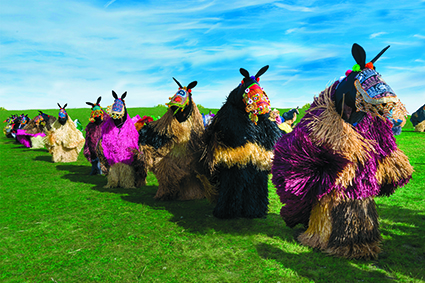
Nick Cave, Heard:Detroit 2015
image courtesy the artist and James Prinz Photography
Nick Cave, Heard:Detroit 2015
What would we do without Carriageworks? CEO Lisa Havilah and her staff continue to integrate an expanding range of contemporary art practices, international artists and artist development strategies into its programs both within and beyond the building into Western Sydney and with a large commitment to Indigenous artists. Havilah has ensured that we think of Carriageworks not as venue, but as an organically functioning contemporary arts centre with a history and a growing identity of its own and as integral to a local, national and, increasingly, international arts ecosystem through its support for the artistic well-being and innovations of its resident companies and partner organisations and commissioned artists.
Partnerings
I met with a spirited Havilah at Carriageworks where she guided me through her 2016 program which has more works, commissions and partners than ever, without losing either passion or direction. New partners include the Sydney Writers’ Festival to present talk programs; Sydney Symphony Orchestra for their 20th-21st century composers series; and City of Sydney for K-pop Party, The Great Strike (see below) and Art and About. As part of its arts and disability strategy Carriageworks is partnering Western Sydney’s Urban Theatre Projects to create a new work, Simple Infinity, with hearing impaired artists. In another arts and disability project resident dance company Force Majeure will work with Grafton-based Dance Integrated Australia in Off the Record.
With its principal resident company, Performance Space, Carriageworks will partner Day for Night for Mardi Gras, co-commission an exhibition of works by media artist Ross Manning after the success of last year’s Ken Thaiday show, and an exhibition of Indigenous art in the Liveworks Festival of Experimental Art. Other partners include Sydney Chamber Opera and Brisbane’s Room40.
Dancing
For the Sydney Festival, Carriageworks will host the adventurous 2016 About An Hour program, which includes a new dance work by Melbourne choreographer Stephanie Lake, Belgium’s Rosas dance company, also in the festival, will perform at Carriageworks which presented the company’s first Sydney appearance in 2014. Later in the year, from France comes Tragédie, choreographed by Olivier Dubois for Ballet du Nord. Inspired by Nietzsche’s notion of the commonality and liberating transcendence dance can offer, it features 18 naked dancers “in a chorus of hypnotically repetitive movements backed by a pounding bass” (program). In May the second round of the Keir Choreographic Fellowship Award will premiere the works of finalists Sarah Aiken, James Batchelor Chloe Chignell, Ghenoa Gela, Martin Hansen, Alice Heyward, Rebecca Jensen and Paea Leach. Adding to the dance program, there’s also Off the Record, mentioned above, and NAISDA’s 40th anniversary production (see below).
Soundings
Just as Sydney Chamber Opera has brought new audiences to Carriageworks hungry for alternatives to Opera Australia’s staid programming, so should the two Sydney Symphony Orchestra concerts of 20th and 21st century music, the first led by SSO chief conductor David Robertson (acclaimed for his support of new music in the US) attract not only those deprived of the new, but also newcomers to it. I’m hoping that after 2016 it will have more than the admirable Brett Dean to represent Australian composition.
The program also includes Sydney Chamber Opera’s Notes from the Underground and Brisbane’s Room40 presenting concerts by experimental musicians Fennesz and Michael Gira (of The Swans). Havilah tells me, “this year’s Room40 season [RT 127, p47] enjoyed a terrific response and director Lawrence English is great to work with.”
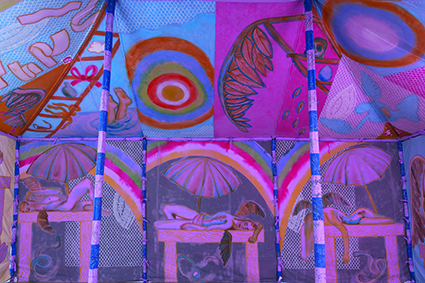
Francesco Clemente, Angels’ Tent 2013 (detail)
courtesy the artist and Mary Boone Gallery, New York
Francesco Clemente, Angels’ Tent 2013 (detail)
Internationals
The organisation’s international standing continues to grow with return visits of Ryoji Ikeda and Lemi Ponifasio (director of NZ’s internationally acclaimed MAU company). Havilah has commissioned a work by Ponifasio for 2017 titled Children of Gods. Involving 400 community members, the work addresses the plight of millions of children today by reflecting on the Children’s Crusade, the story of the expulsion of Muslim children from Jerusalem by Christians in 1212.
Commissioning Ponifasio has given Carriageworks important international leverage to co-produce work it could not itself afford. There are some 50 commissions in Havilah’s program, some starting, others in-progress and others being realised across 2016. One of the latter is Australian artist S Shakthidharan’s multimedia performance work COLONY centred on stories from Western Sydney but with a global perspective and developed by Carriageworks over three years.
Visualising
Over the summer Carriageworks’ featured artist is Ghanian Eli Anatsui, making his first appearance in Australia with five decades of his remarkable assemblages on show. Another featured major artist is Italian Francesco Clemente who, following a visit to India, says Havilah, “made a beautiful series of hand-painted tents. We’ve taken the whole collection and will show it across the foyer from August to October.”
In June we’ll see Adelaide’s Hossein Valmanesh’s major media art installation, which uses four projection screens to create an Iranian bazaar ‘room’ [in which] “to contemplate movement, human interaction and the passing of time. [It’s] a metaphor for Iran, a country which has been subject to invasion, religious and cultural interaction for centuries” [2016 program]. This work has been realised with the support of Adelaide Film Festival, Carriageworks, Samstag Museum, the University of Western Australia and Sydney Film Festival. Havilah had just seen the work in Adelaide and was deeply impressed.
In October-November a greatly warranted and much anticipated major exhibition of Australian artist Ross Manning’s exquisitely beautiful light and sound sculptural works will be displayed in the Carriageworks foyer in partnership with Performance Space.
In another new relationship, two shows from Hobart’s MONA will be exhibited this year at Carriageworks. In French artist Mathieu Briand’s installation Spiral, “five turntables play samples on an endless loop. [The artist] invites you to intervene, creating sonic chaos that’s simultaneously cut to vinyl.” The second exhibition, titled Love, gathers works by the late Sydney light artist Kathy Cavaliere, curated by Daniel Mudie Cunningham.
In Heard•Syd, co-presented by City of Sydney’s Art & About, leading American artist Nick Cave’s 30 fantastical horses will come to life with live music and 60 local performers over two days in November around Sydney and at Carriageworks.
Indigenous art, development & aspiration
After two years in development, Carriageworks and Moogahlin Performing Arts will present writer-director Andrea James’ play Winyanboga Yurringa. Inspired by the groundbreaking 1981 TV series Women of the Sun, it focuses “on the lives of Aboriginal women and their connection to country.”
NAISDA will celebrate 40 years of training Indigenous dancers with a new work and an exhibition at Carriageworks. Naya Wa Yugali—We Dance “will feature oral histories, a new commission by Vicki Van Hout and the work of artists including Tracey Moffatt, Lee Chiswick, Elaine Kitchener and the late Michael Riley.”
On the developmental front is Solid Ground, a $2m three-year partnership between Carriageworks and Blacktown Arts Centre which has just commenced with the employment of two full-time Aboriginal staff. Havilah explains, “It’s about providing pathways for young Indigenous people into the arts and cultural industries under the national Indigenous Advancement Strategy. There’ll be 90 participants from Redfern and Waterloo to Blacktown in job training and bespoke tertiary programs. We hope not only to support the next generation of artists but also arts managers and leaders, so that we’re working on both fronts.” The program includes mentorships and the production of new Indigenous works.
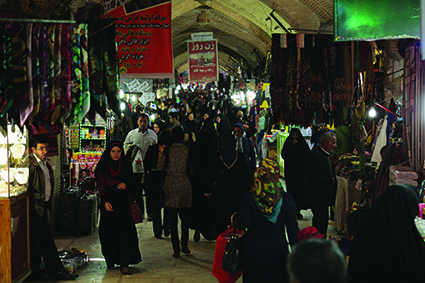
Hossein Valamanesh, Char Soo 2014
© Hossein Valamanesh/Licensed by Viscopy. Image: M Reza Jahanpanah, courtesy the artist and GAGProjects, Greenaway Art Gallery, Adelaide
Hossein Valamanesh, Char Soo 2014
A venture that also advances Indigenous artists, their art and students is the full-time artist residency (with Tony Albert in 2016) with its permanent Park Road studio at Alexandria Park Community School in Sydney’s inner-east. The artist has contact with students each week and helps shape the school’s curriculum, which Havilah see as very important in an integrated program. A permanent studio is also one of the targets for the Solid Ground project.
An excitingly pragmatic new initiative will be Black Arts Market, with curator Hetti Perkins and artist Jonathan Jones bringing artworks by east coast regional Aboriginal artists to market for two days at Carriageworks.
In development
There’s also much in development: a new work by Back to Back Theatre; new plays from Yellamundie and Milk Crate Theatre; and The Great Strike, an exhibition about industrial action held at Carriageworks in 1917 that went national, propelling the consolidation of trade unions in Australia. Curated by Beatrice Gralton in association with local historians and five artists it will feature original materials, photographs and rare film footage in its recounting of employees at Eveleigh and Randwick Tram Sheds striking for six week in protest against new work regulations in World War I.
Lisa Havilah is a master of integration who with her staff, resident companies and many partners has embraced the contemporary arts organically and with a great sense of considered but always exciting evolution. She puts it simply: “It’s a matter of keeping your core values, not changing your path, learning from what you deliver and expanding on it.”
RealTime issue #130 Dec-Jan 2015 pg. 26
© Keith Gallasch; for permission to reproduce apply to realtime@realtimearts.net
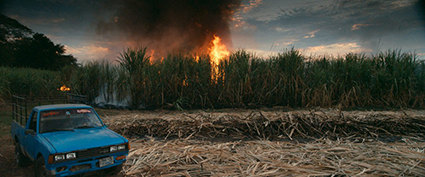
Burning Sugar Cane Field in El Salvador. Still from “This Changes Everything”
There’s a rather jaw-dropping moment in Louie Psihoyos’ environmental documentary Racing Extinction (2015) when the director, in voiceover, offhandedly mentions his dismay after calculating the immense amount of greenhouse gasses generated by the production of his movie. Having acknowledged his contribution to the problem his film documents, he glibly glosses over this inconvenient truth and spends the rest of the film playing the heroic white American investigator catching out environmental abusers in developing countries like China.
Avi Lewis and Naomi Klein’s This Changes Everything, which has been doing the rounds of special screenings organised by environmental groups across Australia, is not quite so wilfully blind to its own internal contradictions, but I couldn’t help feeling the same sense of discomfort I experienced watching Psihoyos’ film.
As if to pre-empt responses like mine, in the opening moments of This Changes Everything Klein tries to head off any suspicion she will follow a well-established formula. In a chatty, rather cutesy voiceover she declares that climate change documentaries are “boring” and images of polar bears on shrinking ice caps “have never really done it for me.” Despite this, the film treads much the same path as countless other recent documentaries on environmental issues.
First we are bombarded with astounding statistics and mind-boggling images of environmental degradation to demonstrate the irrationality of mega-rich corporations and their governmental lackeys. At around the 50-minute mark there is a ray of hope, with a story of localised resistance to corporate development instigated by poor people in the developing world. Then the filmmakers bring it back home with a heart-warming, small-scale initiative in a Western country involving people like us, who speak English. They then make some vague statements about finding a better way to live, slap up a website in the end credits so people can find out how to “take action,” and send us all home reassured that saving the planet is only an online petition away.
Lest I sound like a cynical climate change denier, let me clarify. I don’t for a moment doubt we are on the edge of environmental catastrophe, and that those who say otherwise are either protecting vested interests or are wilfully blind. It is also abundantly clear that governments around the world now see their role as representing the interests of capital above all else. But I also strongly believe that constructing simplistic binaries—between developed and developing countries, corporations and the ‘99 per cent,’ capitalism and some other economic system that cannot be named—is preventing all of us taking an honest look at ourselves, our lifestyles and our culture. Films like This Changes Everything often feel like they are about reassuring us—concerned, middle class people who actually watch these documentaries—rather than alerting us to the disastrous path we’re all on.
Take, for example, the film’s vague attack on “capitalism.” I put the word in quotation marks because there is no attempt here to really examine what capitalism is as a social, political and economic system. Instead, it’s bandied about as a handy symbol of all that is wrong with other people. Is capitalism necessarily inherently doomed to generate environmental disaster? If so, what exactly are Lewis and Klein proposing as an alternative? There is no evidence that centrally planned socialist systems are more friendly to our planet, as the state of parts of the former Soviet Union attests. Or is the problem the neo-liberal variant of capitalism that has been instigated across the West since the 1970s? If so, then what form of capitalism might better serve the environment? Lewis and Klein examined some alternative economic models in their earlier film, The Take (RT 69, p21), but This Changes Everything doesn’t seriously delve into any of these questions. Instead, we get some rather glaring instances of interviewees blaming “capitalism” and corporations for our problems, while failing to reflect on our own imbrication in the consumerist way of life that these corporations are feeding.
Early in the film, for instance, we meet Crystal, a young Indigenous leader of the Beaver Creek Nation in Alberta, Canada. This is tar sands country where oil is being extracted on a vast scale, with predictably grim results for the surrounds. When her people learn of a spill from a pipeline, Crystal tries to gain access to the site, as is her legal right as an Indigenous custodian. She is interviewed by Klein as she drives to the mining company headquarters in her car, waxing lyrical about what our obsession with oil is doing to the planet. At no point does Crystal, or anyone else in the film, notice the irony of condemning oil companies while going about her daily business—like so many of us—in a large, privately owned, petrol-fuelled motor vehicle.
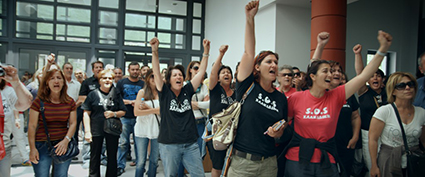
Protesters against gold mine in Halkidiki, Greece. Still from “This Changes Everything”
Later in the film, we see a group of Greek women in a beautiful forest area earmarked for mining. The Greek Government, we are told, is rapidly selling off all the country’s natural resources to try and inject funds into the cash-strapped economy. The women raise a toast to the beauty around them that they are trying to save—using disposable plastic cups.
These sound like small incidents, but it is tiny, unthinking acts multiplied billions of times across the planet on a daily basis that are inexorably destroying our world. It’s easy to blame big polluters—and they should certainly be held to account—but how many of us in the affluent West are really prepared to rein in our lifestyles for the sake of the planet? How many of us are even prepared to stop buying coffee in disposable cups, let alone give up our cars?
The filmmakers themselves traverse Canada, the United States, Greece, China and India in the course of the documentary—much like Louie Psihoyos’ globetrotting effort in Racing Extinction. Yet nowhere do Lewis and Klein reflect upon the damage they are inflicting by happily zipping around the world on jetliners. When are we going to see an environmental film that actually tries to lead by example, instead of simply reiterating visual and verbal clichés?
Of course the impact of making a documentary like this does not compare to the mining of the tar sands of Alberta. But the filmmakers’ willingness to blithely burn the oil they condemn others for extracting speaks, I think, of a deeper denial. Large corporations are feeding a demand created by us—all of us. If what is happening really changes everything, why aren’t documentary makers like Lewis and Klein at least trying to challenge their usual modes of filmic production?
This Changes Everything, director Avi Lewis, producers Avi Lewis and Joslyn Barnes, writer Naomi Klein, Canada-USA, 2015.
RealTime issue #130 Dec-Jan 2015 pg. 27
© Dan Edwards; for permission to reproduce apply to realtime@realtimearts.net























































































